

Compact Muon Solenoid
LHC, CERN
| CMS-PAS-HIG-16-004 | ||
| Search for $ \mathrm{ t \bar{ t } H } $ production in the $ \mathrm{ H } \rightarrow \mathrm{ b\bar{ b } } $ decay channel with $ \sqrt{s} = $ 13 TeV pp collisions at the CMS experiment | ||
| CMS Collaboration | ||
| March 2016 | ||
|
Abstract:
First results of the search for the associated production of a Higgs boson with a top quark-antiquark pair ($ \mathrm{ t \bar{t} H} $) in proton-proton collisions at a center-of-mass energy of $\sqrt{s} =$ 13 TeV are presented. The data correspond to an integrated luminosity of 2.7 fb$^{-1}$ recorded with the CMS experiment in 2015. Candidate $\mathrm{t\bar{t}H}$ events are selected with criteria enhancing the lepton+jets or dileptonic decay channels of the $ \mathrm{ t \bar{t} } $ system and the decay of the Higgs boson into a bottom quark-antiquark pair ( $ \mathrm{H} \rightarrow \mathrm{ b \bar{b} } $). In order to increase the sensitivity of the search, selected events are split into several categories with different expected signal and background rates. In each category signal and background events are separated using a multivariate approach that combines a physics-motivated method (matrix element method, MEM) with methods from machine learning (boosted decision trees, BDTs). The result is presented in terms of the $\mathrm{ t \bar{t} H }$ signal strength modifier $\mu$, the ratio of the observed $ \mathrm{ t \bar{t} H }$ production cross section relative to the value expected for a 125 GeV standard model Higgs boson. A combined fit of multivariate discriminant templates in all categories to data results in an observed (expected) upper limit of $\mu <$ 2.6 (3.6) at the 95% confidence level. The combination of ttH results with CMS data at 13 TeV is summarized at this url. | ||
| Links: CDS record (PDF) ; inSPIRE record ; CADI line (restricted) ; | ||
| Figures & Tables | Additional Figures | CMS Publications |
|---|
| Figures | |
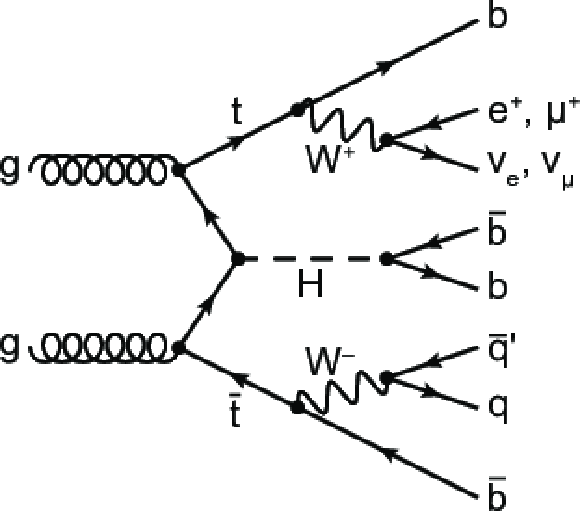
png pdf |
Figure 1-a:
Exemplary leading-order Feynman diagrams for $ \mathrm{ t \bar{t} H } $ production, including the subsequent decays of the top quark-antiquark pair in the lepton+jets channel (a) and the dilepton channel (b) as well as the decay of the Higgs boson into a bottom quark-antiquark pair. |
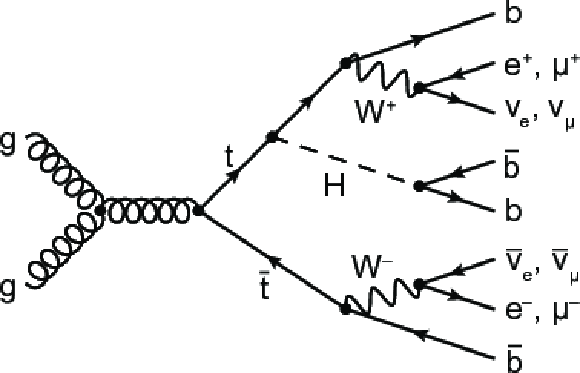
png pdf |
Figure 1-b:
Exemplary leading-order Feynman diagrams for $ \mathrm{ t \bar{t} H } $ production, including the subsequent decays of the top quark-antiquark pair in the lepton+jets channel (a) and the dilepton channel (b) as well as the decay of the Higgs boson into a bottom quark-antiquark pair. |
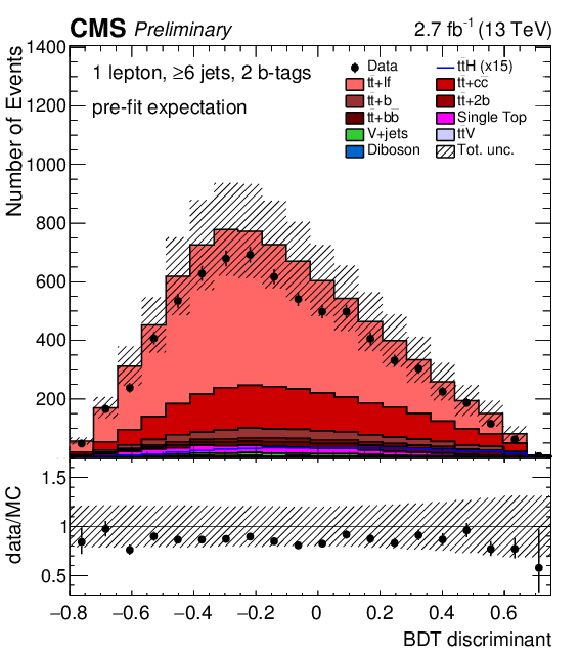
png pdf |
Figure 2-a:
Final discriminant shapes in the different analysis categories in the lepton+jets channel before the fit to data. The expected background contributions (filled histograms) are stacked, and the expected signal distribution (line) for a Higgs-boson mass of $ {m_{H}}= $ 125 GeV is superimposed. Each contribution is normalized to an integrated luminosity of 2.7 fb$^{-1}$, and the signal contribution is additionally scaled by a factor of 15 for better readability. The distributions in data (markers) are also shown. In the top row the $\geq $ 6 jets 2 b-tag, the 4 jets 3 b-tag, and the 5 jets 3 b-tag category are shown. Below are the $\geq $ 6 jets 3 b-tag category, the 4 jets 4 b-tag category with low BDT output, and the 4 jets 4 b-tag category with high BDT output. |
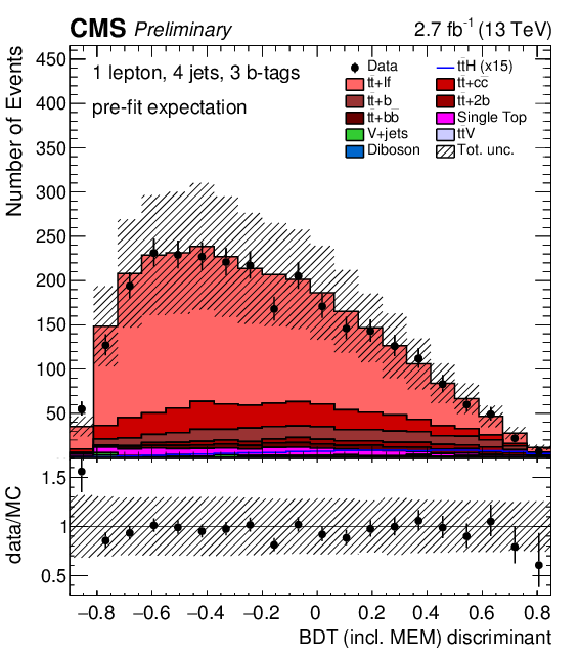
png pdf |
Figure 2-b:
Final discriminant shapes in the different analysis categories in the lepton+jets channel before the fit to data. The expected background contributions (filled histograms) are stacked, and the expected signal distribution (line) for a Higgs-boson mass of $ {m_{H}}= $ 125 GeV is superimposed. Each contribution is normalized to an integrated luminosity of 2.7 fb$^{-1}$, and the signal contribution is additionally scaled by a factor of 15 for better readability. The distributions in data (markers) are also shown. In the top row the $\geq $ 6 jets 2 b-tag, the 4 jets 3 b-tag, and the 5 jets 3 b-tag category are shown. Below are the $\geq $ 6 jets 3 b-tag category, the 4 jets 4 b-tag category with low BDT output, and the 4 jets 4 b-tag category with high BDT output. |
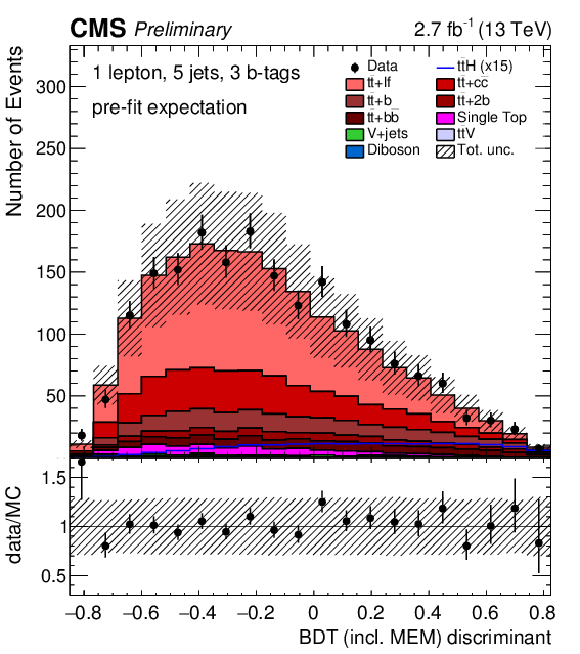
png pdf |
Figure 2-c:
Final discriminant shapes in the different analysis categories in the lepton+jets channel before the fit to data. The expected background contributions (filled histograms) are stacked, and the expected signal distribution (line) for a Higgs-boson mass of $ {m_{H}}= $ 125 GeV is superimposed. Each contribution is normalized to an integrated luminosity of 2.7 fb$^{-1}$, and the signal contribution is additionally scaled by a factor of 15 for better readability. The distributions in data (markers) are also shown. In the top row the $\geq $ 6 jets 2 b-tag, the 4 jets 3 b-tag, and the 5 jets 3 b-tag category are shown. Below are the $\geq $ 6 jets 3 b-tag category, the 4 jets 4 b-tag category with low BDT output, and the 4 jets 4 b-tag category with high BDT output. |
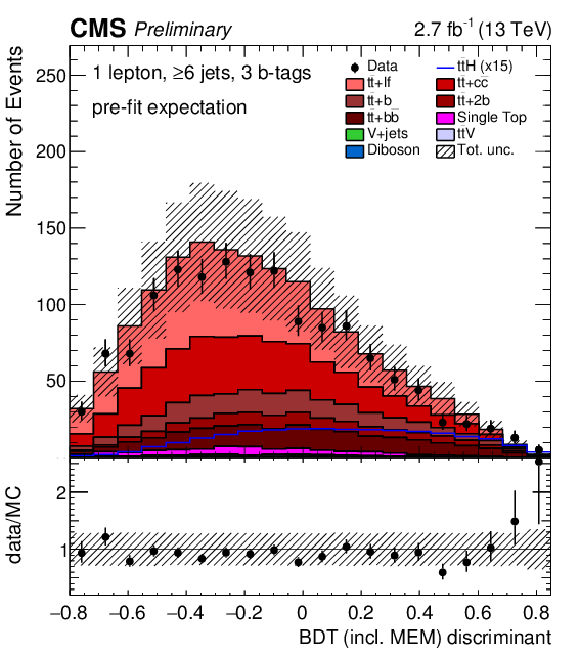
png pdf |
Figure 2-d:
Final discriminant shapes in the different analysis categories in the lepton+jets channel before the fit to data. The expected background contributions (filled histograms) are stacked, and the expected signal distribution (line) for a Higgs-boson mass of $ {m_{H}}= $ 125 GeV is superimposed. Each contribution is normalized to an integrated luminosity of 2.7 fb$^{-1}$, and the signal contribution is additionally scaled by a factor of 15 for better readability. The distributions in data (markers) are also shown. In the top row the $\geq $ 6 jets 2 b-tag, the 4 jets 3 b-tag, and the 5 jets 3 b-tag category are shown. Below are the $\geq $ 6 jets 3 b-tag category, the 4 jets 4 b-tag category with low BDT output, and the 4 jets 4 b-tag category with high BDT output. |

png pdf |
Figure 2-e:
Final discriminant shapes in the different analysis categories in the lepton+jets channel before the fit to data. The expected background contributions (filled histograms) are stacked, and the expected signal distribution (line) for a Higgs-boson mass of $ {m_{H}}= $ 125 GeV is superimposed. Each contribution is normalized to an integrated luminosity of 2.7 fb$^{-1}$, and the signal contribution is additionally scaled by a factor of 15 for better readability. The distributions in data (markers) are also shown. In the top row the $\geq $ 6 jets 2 b-tag, the 4 jets 3 b-tag, and the 5 jets 3 b-tag category are shown. Below are the $\geq $ 6 jets 3 b-tag category, the 4 jets 4 b-tag category with low BDT output, and the 4 jets 4 b-tag category with high BDT output. |
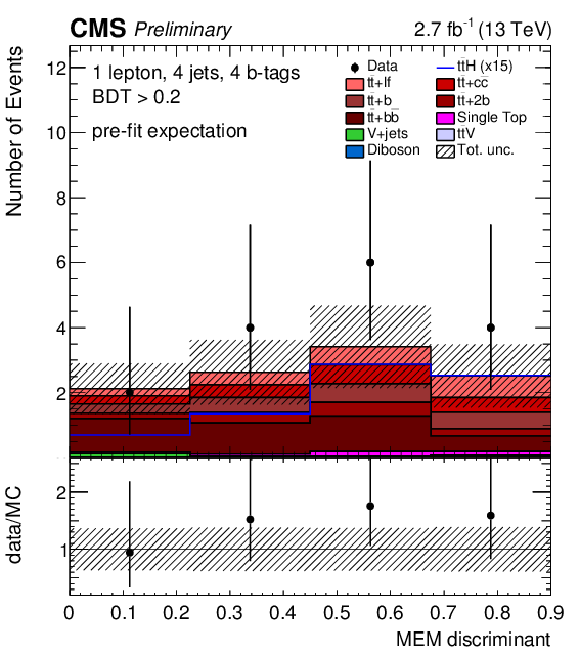
png pdf |
Figure 2-f:
Final discriminant shapes in the different analysis categories in the lepton+jets channel before the fit to data. The expected background contributions (filled histograms) are stacked, and the expected signal distribution (line) for a Higgs-boson mass of $ {m_{H}}= $ 125 GeV is superimposed. Each contribution is normalized to an integrated luminosity of 2.7 fb$^{-1}$, and the signal contribution is additionally scaled by a factor of 15 for better readability. The distributions in data (markers) are also shown. In the top row the $\geq $ 6 jets 2 b-tag, the 4 jets 3 b-tag, and the 5 jets 3 b-tag category are shown. Below are the $\geq $ 6 jets 3 b-tag category, the 4 jets 4 b-tag category with low BDT output, and the 4 jets 4 b-tag category with high BDT output. |
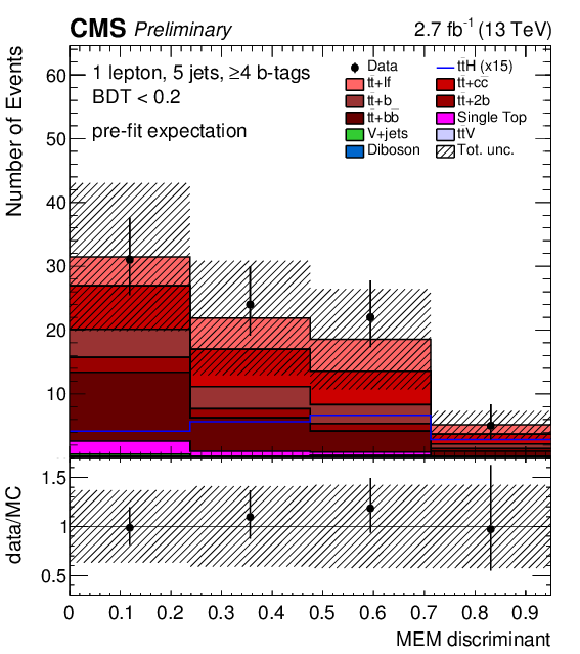
png pdf |
Figure 3-a:
Final discriminant shapes in the different analysis categories in the lepton+jets channel before the fit to data. The expected background contributions (filled histograms) are stacked, and the expected signal distribution (line) for a Higgs-boson mass of $ {m_{H}}= $ 125 GeV is superimposed. Each contribution is normalized to an integrated luminosity of 2.7 fb$^{-1}$, and the signal contribution is additionally scaled by a factor of 15 for better readability. The distributions in data (markers) are also shown. In the top row the 5 jets 4 b-tag with low BDT output, the 5 jets 4 b-tag category with high BDT output, and the 6 jet category with low BDT output is shown. Below are the 6 jets 4 b-tag category with high BDT output, and the boosted category. |
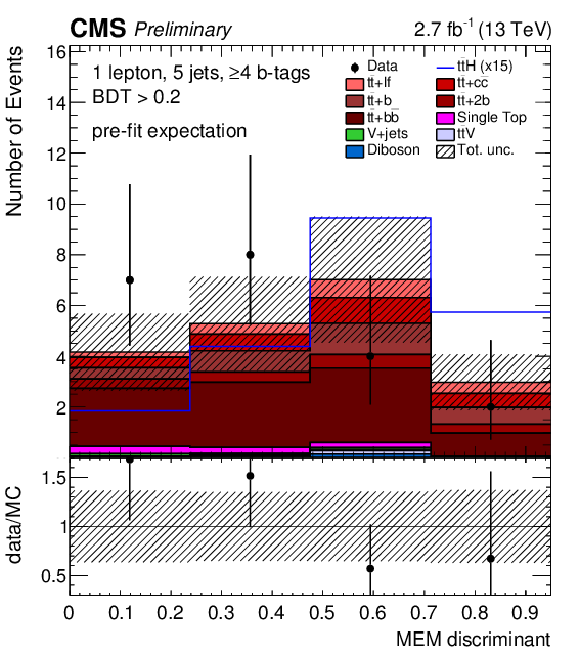
png pdf |
Figure 3-b:
Final discriminant shapes in the different analysis categories in the lepton+jets channel before the fit to data. The expected background contributions (filled histograms) are stacked, and the expected signal distribution (line) for a Higgs-boson mass of $ {m_{H}}= $ 125 GeV is superimposed. Each contribution is normalized to an integrated luminosity of 2.7 fb$^{-1}$, and the signal contribution is additionally scaled by a factor of 15 for better readability. The distributions in data (markers) are also shown. In the top row the 5 jets 4 b-tag with low BDT output, the 5 jets 4 b-tag category with high BDT output, and the 6 jet category with low BDT output is shown. Below are the 6 jets 4 b-tag category with high BDT output, and the boosted category. |

png pdf |
Figure 3-c:
Final discriminant shapes in the different analysis categories in the lepton+jets channel before the fit to data. The expected background contributions (filled histograms) are stacked, and the expected signal distribution (line) for a Higgs-boson mass of $ {m_{H}}= $ 125 GeV is superimposed. Each contribution is normalized to an integrated luminosity of 2.7 fb$^{-1}$, and the signal contribution is additionally scaled by a factor of 15 for better readability. The distributions in data (markers) are also shown. In the top row the 5 jets 4 b-tag with low BDT output, the 5 jets 4 b-tag category with high BDT output, and the 6 jet category with low BDT output is shown. Below are the 6 jets 4 b-tag category with high BDT output, and the boosted category. |

png pdf |
Figure 3-d:
Final discriminant shapes in the different analysis categories in the lepton+jets channel before the fit to data. The expected background contributions (filled histograms) are stacked, and the expected signal distribution (line) for a Higgs-boson mass of $ {m_{H}}= $ 125 GeV is superimposed. Each contribution is normalized to an integrated luminosity of 2.7 fb$^{-1}$, and the signal contribution is additionally scaled by a factor of 15 for better readability. The distributions in data (markers) are also shown. In the top row the 5 jets 4 b-tag with low BDT output, the 5 jets 4 b-tag category with high BDT output, and the 6 jet category with low BDT output is shown. Below are the 6 jets 4 b-tag category with high BDT output, and the boosted category. |
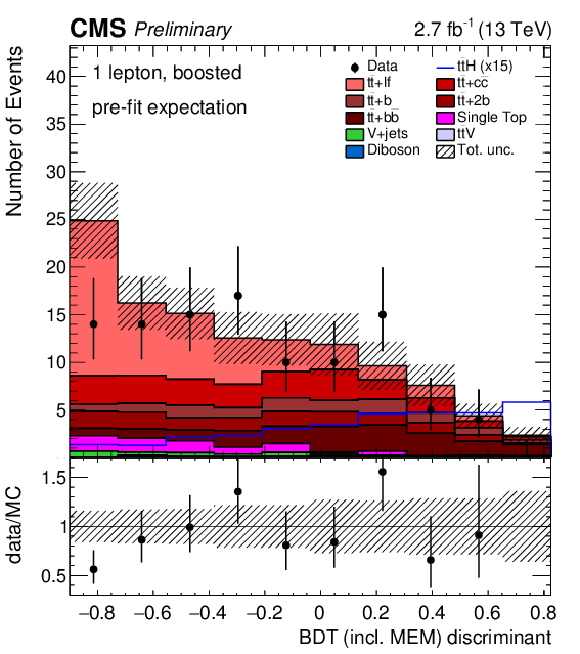
png pdf |
Figure 3-e:
Final discriminant shapes in the different analysis categories in the lepton+jets channel before the fit to data. The expected background contributions (filled histograms) are stacked, and the expected signal distribution (line) for a Higgs-boson mass of $ {m_{H}}= $ 125 GeV is superimposed. Each contribution is normalized to an integrated luminosity of 2.7 fb$^{-1}$, and the signal contribution is additionally scaled by a factor of 15 for better readability. The distributions in data (markers) are also shown. In the top row the 5 jets 4 b-tag with low BDT output, the 5 jets 4 b-tag category with high BDT output, and the 6 jet category with low BDT output is shown. Below are the 6 jets 4 b-tag category with high BDT output, and the boosted category. |

png pdf |
Figure 4-a:
Final discriminant shapes in all analysis categories in the dilepton channel before the fit to data. In the top row the (3 jets, 2 b-tags), (3 jets, 3 b-tags), and ($\geq$ 4 jets, 2 b-tags) are shown. Below are the ($\geq$ 4 jets, 3 b-tags) and ($\geq$ 4 jets, $\geq$ 4 b-tags) categories. The expected background contributions (filled histograms) are stacked, and the expected signal distribution (line) for a Higgs-boson mass of $ {m_{H}}=$ 125 GeV is superimposed. Each contribution is normalized to an integrated luminosity of 2.7 fb$^{-1}$, and the signal contribution is additionally scaled by a factor of 15 for better readability. The distributions in data (markers) are also shown. |
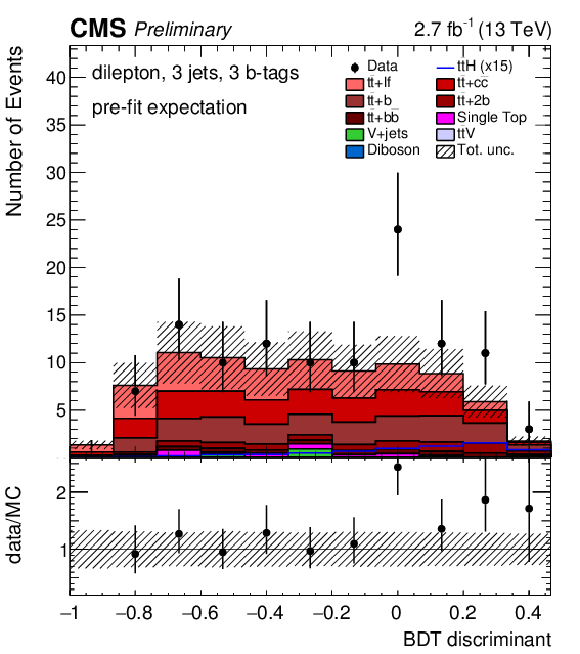
png pdf |
Figure 4-b:
Final discriminant shapes in all analysis categories in the dilepton channel before the fit to data. In the top row the (3 jets, 2 b-tags), (3 jets, 3 b-tags), and ($\geq$ 4 jets, 2 b-tags) are shown. Below are the ($\geq$ 4 jets, 3 b-tags) and ($\geq$ 4 jets, $\geq$ 4 b-tags) categories. The expected background contributions (filled histograms) are stacked, and the expected signal distribution (line) for a Higgs-boson mass of $ {m_{H}}=$ 125 GeV is superimposed. Each contribution is normalized to an integrated luminosity of 2.7 fb$^{-1}$, and the signal contribution is additionally scaled by a factor of 15 for better readability. The distributions in data (markers) are also shown. |
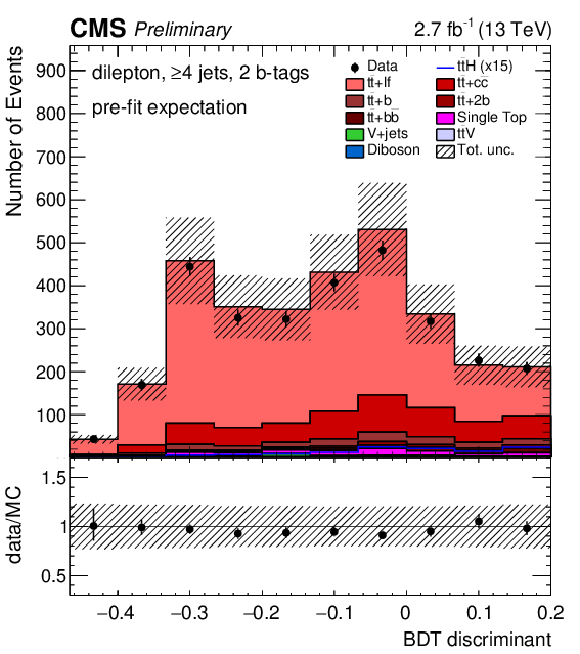
png pdf |
Figure 4-c:
Final discriminant shapes in all analysis categories in the dilepton channel before the fit to data. In the top row the (3 jets, 2 b-tags), (3 jets, 3 b-tags), and ($\geq$ 4 jets, 2 b-tags) are shown. Below are the ($\geq$ 4 jets, 3 b-tags) and ($\geq$ 4 jets, $\geq$ 4 b-tags) categories. The expected background contributions (filled histograms) are stacked, and the expected signal distribution (line) for a Higgs-boson mass of $ {m_{H}}=$ 125 GeV is superimposed. Each contribution is normalized to an integrated luminosity of 2.7 fb$^{-1}$, and the signal contribution is additionally scaled by a factor of 15 for better readability. The distributions in data (markers) are also shown. |
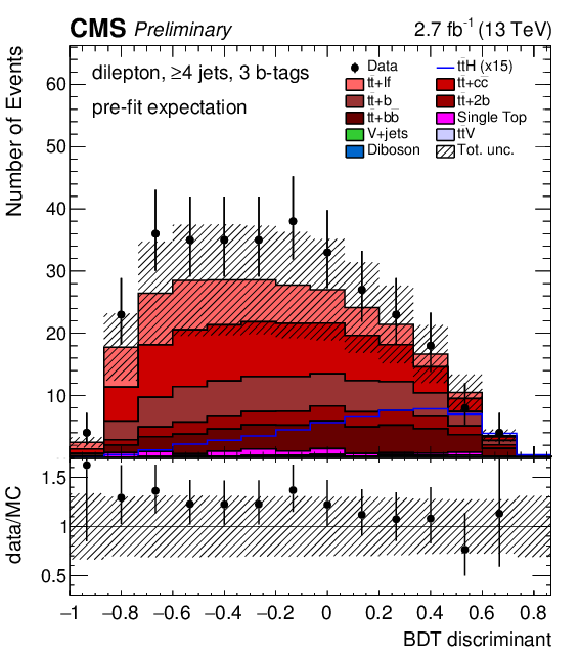
png pdf |
Figure 4-d:
Final discriminant shapes in all analysis categories in the dilepton channel before the fit to data. In the top row the (3 jets, 2 b-tags), (3 jets, 3 b-tags), and ($\geq$ 4 jets, 2 b-tags) are shown. Below are the ($\geq$ 4 jets, 3 b-tags) and ($\geq$ 4 jets, $\geq$ 4 b-tags) categories. The expected background contributions (filled histograms) are stacked, and the expected signal distribution (line) for a Higgs-boson mass of $ {m_{H}}=$ 125 GeV is superimposed. Each contribution is normalized to an integrated luminosity of 2.7 fb$^{-1}$, and the signal contribution is additionally scaled by a factor of 15 for better readability. The distributions in data (markers) are also shown. |

png pdf |
Figure 4-e:
Final discriminant shapes in all analysis categories in the dilepton channel before the fit to data. In the top row the (3 jets, 2 b-tags), (3 jets, 3 b-tags), and ($\geq$ 4 jets, 2 b-tags) are shown. Below are the ($\geq$ 4 jets, 3 b-tags) and ($\geq$ 4 jets, $\geq$ 4 b-tags) categories. The expected background contributions (filled histograms) are stacked, and the expected signal distribution (line) for a Higgs-boson mass of $ {m_{H}}=$ 125 GeV is superimposed. Each contribution is normalized to an integrated luminosity of 2.7 fb$^{-1}$, and the signal contribution is additionally scaled by a factor of 15 for better readability. The distributions in data (markers) are also shown. |
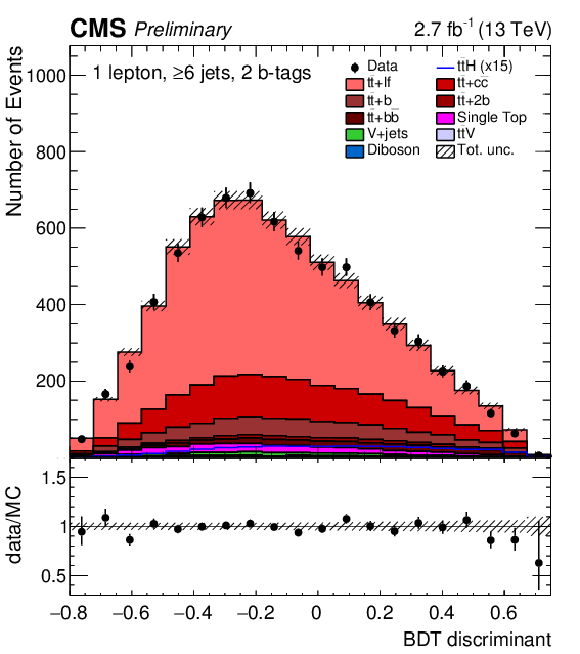
png pdf |
Figure 5-a:
Final discriminant shapes in the different analysis categories in the lepton+jets channel after the fit to data. The expected background contributions (filled histograms) are stacked, and the expected signal distribution (line) for a Higgs-boson mass of $ {m_{H}}=$ 125 GeV is superimposed. Each contribution is normalized to an integrated luminosity of 2.7 fb$^{-1}$, and the signal contribution is additionally scaled by a factor of 15 for better readability. The distributions in data (markers) are also shown. In the top row the (5 jets 4 b-tags) with low BDT output, the (5 jets, 4 b-tags) category with high BDT output, and the 6 jets category with low BDT output is shown. Below are the (6 jets, 4 b-tags) category with high BDT output, and the boosted category. |
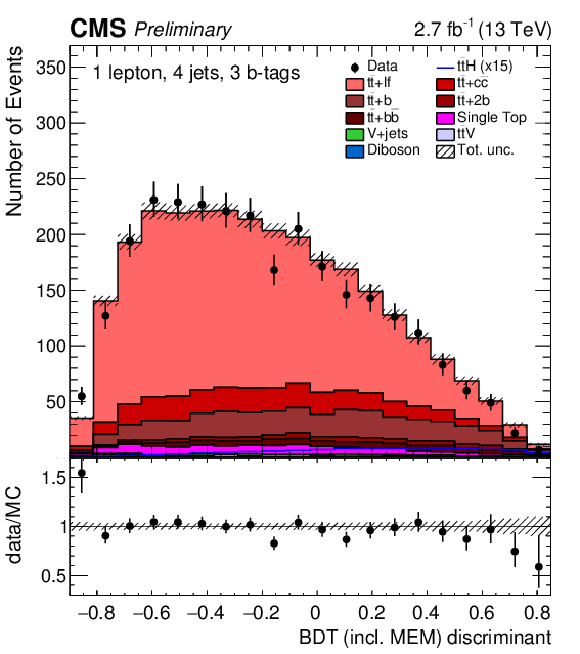
png pdf |
Figure 5-b:
Final discriminant shapes in the different analysis categories in the lepton+jets channel after the fit to data. The expected background contributions (filled histograms) are stacked, and the expected signal distribution (line) for a Higgs-boson mass of $ {m_{H}}=$ 125 GeV is superimposed. Each contribution is normalized to an integrated luminosity of 2.7 fb$^{-1}$, and the signal contribution is additionally scaled by a factor of 15 for better readability. The distributions in data (markers) are also shown. In the top row the (5 jets 4 b-tags) with low BDT output, the (5 jets, 4 b-tags) category with high BDT output, and the 6 jets category with low BDT output is shown. Below are the (6 jets, 4 b-tags) category with high BDT output, and the boosted category. |
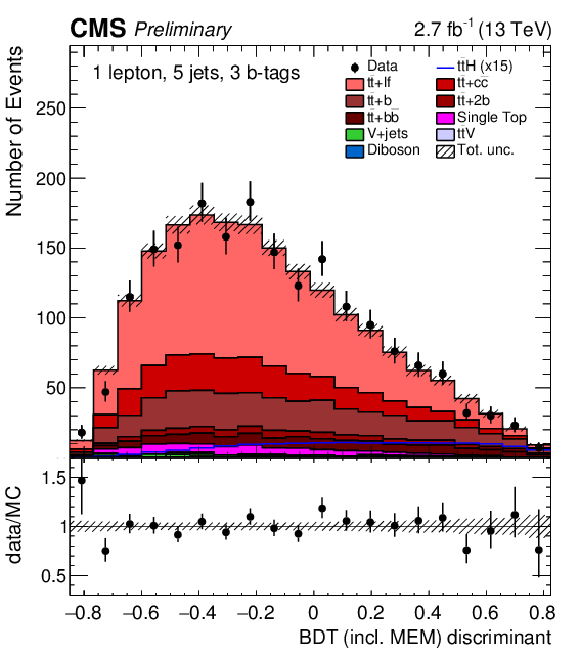
png pdf |
Figure 5-c:
Final discriminant shapes in the different analysis categories in the lepton+jets channel after the fit to data. The expected background contributions (filled histograms) are stacked, and the expected signal distribution (line) for a Higgs-boson mass of $ {m_{H}}=$ 125 GeV is superimposed. Each contribution is normalized to an integrated luminosity of 2.7 fb$^{-1}$, and the signal contribution is additionally scaled by a factor of 15 for better readability. The distributions in data (markers) are also shown. In the top row the (5 jets 4 b-tags) with low BDT output, the (5 jets, 4 b-tags) category with high BDT output, and the 6 jets category with low BDT output is shown. Below are the (6 jets, 4 b-tags) category with high BDT output, and the boosted category. |
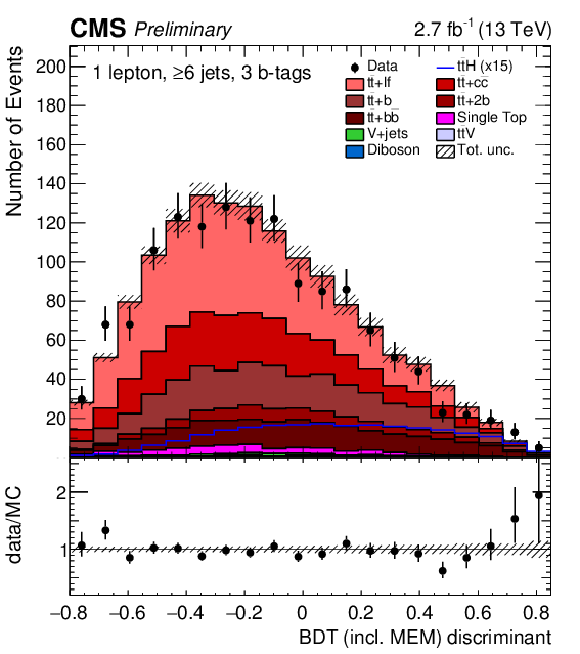
png pdf |
Figure 5-d:
Final discriminant shapes in the different analysis categories in the lepton+jets channel after the fit to data. The expected background contributions (filled histograms) are stacked, and the expected signal distribution (line) for a Higgs-boson mass of $ {m_{H}}=$ 125 GeV is superimposed. Each contribution is normalized to an integrated luminosity of 2.7 fb$^{-1}$, and the signal contribution is additionally scaled by a factor of 15 for better readability. The distributions in data (markers) are also shown. In the top row the (5 jets 4 b-tags) with low BDT output, the (5 jets, 4 b-tags) category with high BDT output, and the 6 jets category with low BDT output is shown. Below are the (6 jets, 4 b-tags) category with high BDT output, and the boosted category. |

png pdf |
Figure 5-e:
Final discriminant shapes in the different analysis categories in the lepton+jets channel after the fit to data. The expected background contributions (filled histograms) are stacked, and the expected signal distribution (line) for a Higgs-boson mass of $ {m_{H}}=$ 125 GeV is superimposed. Each contribution is normalized to an integrated luminosity of 2.7 fb$^{-1}$, and the signal contribution is additionally scaled by a factor of 15 for better readability. The distributions in data (markers) are also shown. In the top row the (5 jets 4 b-tags) with low BDT output, the (5 jets, 4 b-tags) category with high BDT output, and the 6 jets category with low BDT output is shown. Below are the (6 jets, 4 b-tags) category with high BDT output, and the boosted category. |
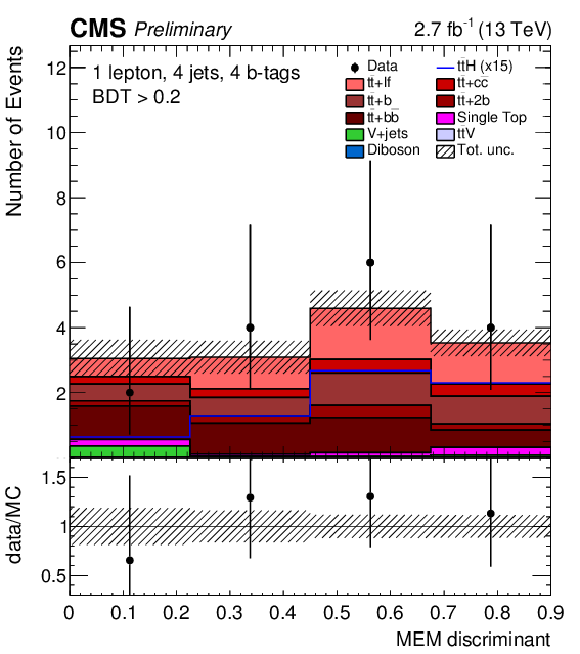
png pdf |
Figure 5-f:
Final discriminant shapes in the different analysis categories in the lepton+jets channel after the fit to data. The expected background contributions (filled histograms) are stacked, and the expected signal distribution (line) for a Higgs-boson mass of $ {m_{H}}=$ 125 GeV is superimposed. Each contribution is normalized to an integrated luminosity of 2.7 fb$^{-1}$, and the signal contribution is additionally scaled by a factor of 15 for better readability. The distributions in data (markers) are also shown. In the top row the (5 jets 4 b-tags) with low BDT output, the (5 jets, 4 b-tags) category with high BDT output, and the 6 jets category with low BDT output is shown. Below are the (6 jets, 4 b-tags) category with high BDT output, and the boosted category. |
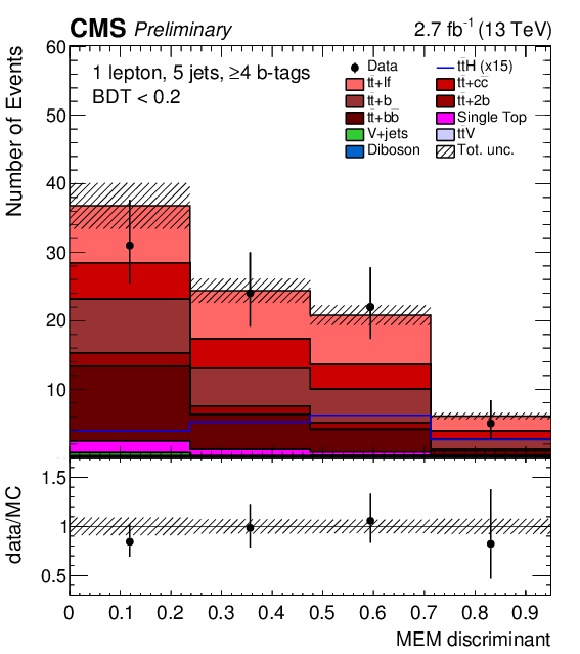
png pdf |
Figure 6-a:
Final discriminant shapes in the different analysis categories in the lepton+jets channel after the fit to data. The expected background contributions (filled histograms) are stacked, and the expected signal distribution (line) for a Higgs-boson mass of $ {m_{H}}=$ 125 GeV is superimposed. Each contribution is normalized to an integrated luminosity of 2.7 fb$^{-1}$, and the signal contribution is additionally scaled by a factor of 15 for better readability. The distributions in data (markers) are also shown. In the top row the (5 jets, 4 b-tags) with low BDT output, the (5 jets, 4 b-tags) category with high BDT output, and the 6 jets category with low BDT output is shown. Below are the (6 jets, 4 b-tags) category with high BDT output, and the boosted category. |
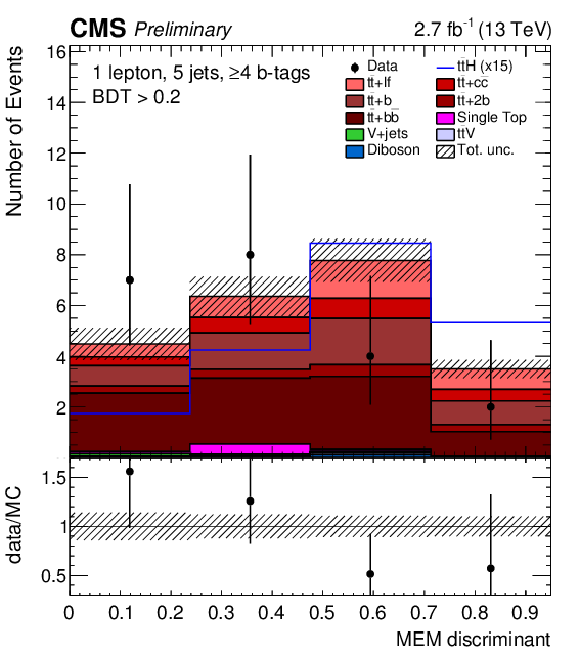
png pdf |
Figure 6-b:
Final discriminant shapes in the different analysis categories in the lepton+jets channel after the fit to data. The expected background contributions (filled histograms) are stacked, and the expected signal distribution (line) for a Higgs-boson mass of $ {m_{H}}=$ 125 GeV is superimposed. Each contribution is normalized to an integrated luminosity of 2.7 fb$^{-1}$, and the signal contribution is additionally scaled by a factor of 15 for better readability. The distributions in data (markers) are also shown. In the top row the (5 jets, 4 b-tags) with low BDT output, the (5 jets, 4 b-tags) category with high BDT output, and the 6 jets category with low BDT output is shown. Below are the (6 jets, 4 b-tags) category with high BDT output, and the boosted category. |
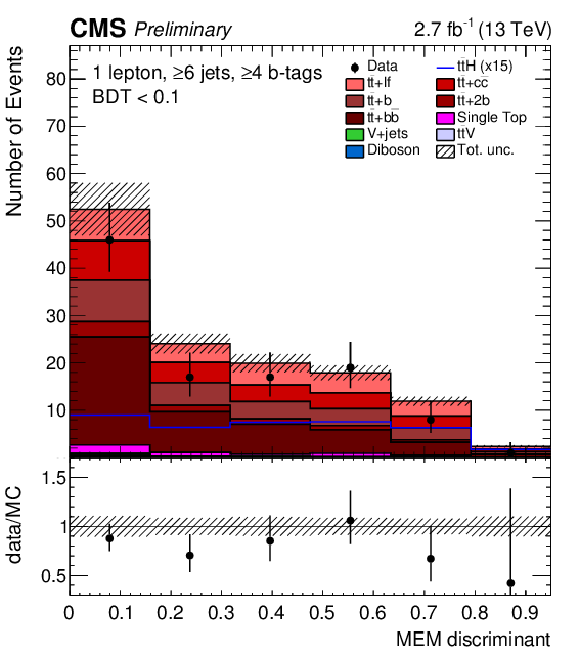
png pdf |
Figure 6-c:
Final discriminant shapes in the different analysis categories in the lepton+jets channel after the fit to data. The expected background contributions (filled histograms) are stacked, and the expected signal distribution (line) for a Higgs-boson mass of $ {m_{H}}=$ 125 GeV is superimposed. Each contribution is normalized to an integrated luminosity of 2.7 fb$^{-1}$, and the signal contribution is additionally scaled by a factor of 15 for better readability. The distributions in data (markers) are also shown. In the top row the (5 jets, 4 b-tags) with low BDT output, the (5 jets, 4 b-tags) category with high BDT output, and the 6 jets category with low BDT output is shown. Below are the (6 jets, 4 b-tags) category with high BDT output, and the boosted category. |
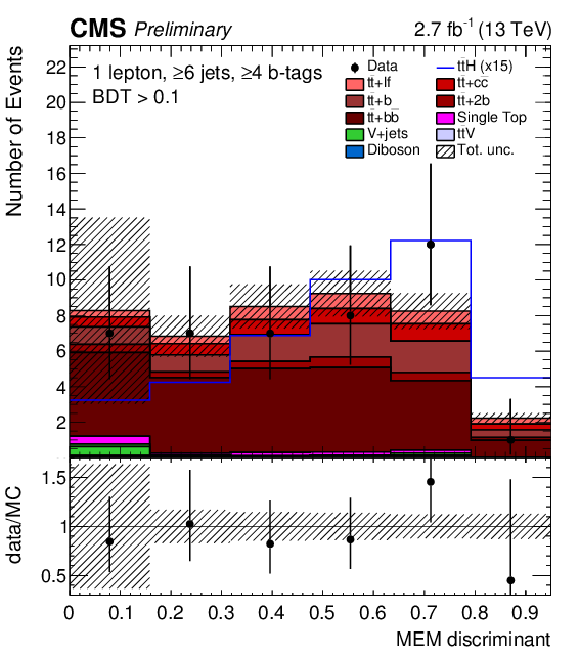
png pdf |
Figure 6-d:
Final discriminant shapes in the different analysis categories in the lepton+jets channel after the fit to data. The expected background contributions (filled histograms) are stacked, and the expected signal distribution (line) for a Higgs-boson mass of $ {m_{H}}=$ 125 GeV is superimposed. Each contribution is normalized to an integrated luminosity of 2.7 fb$^{-1}$, and the signal contribution is additionally scaled by a factor of 15 for better readability. The distributions in data (markers) are also shown. In the top row the (5 jets, 4 b-tags) with low BDT output, the (5 jets, 4 b-tags) category with high BDT output, and the 6 jets category with low BDT output is shown. Below are the (6 jets, 4 b-tags) category with high BDT output, and the boosted category. |
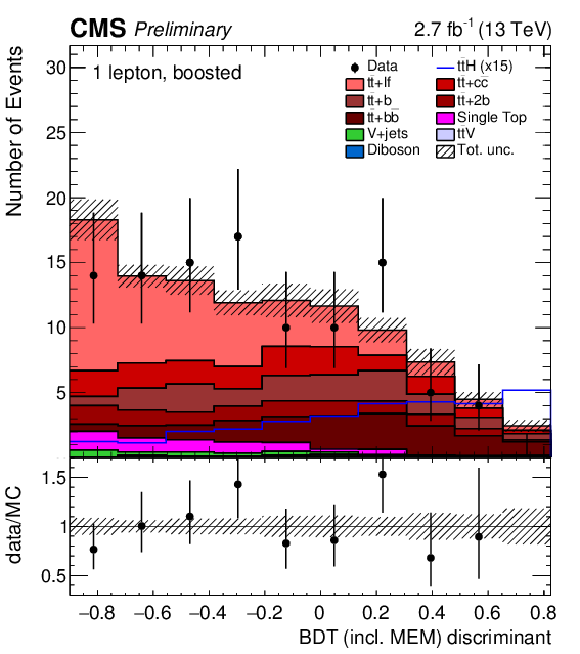
png pdf |
Figure 6-e:
Final discriminant shapes in the different analysis categories in the lepton+jets channel after the fit to data. The expected background contributions (filled histograms) are stacked, and the expected signal distribution (line) for a Higgs-boson mass of $ {m_{H}}=$ 125 GeV is superimposed. Each contribution is normalized to an integrated luminosity of 2.7 fb$^{-1}$, and the signal contribution is additionally scaled by a factor of 15 for better readability. The distributions in data (markers) are also shown. In the top row the (5 jets, 4 b-tags) with low BDT output, the (5 jets, 4 b-tags) category with high BDT output, and the 6 jets category with low BDT output is shown. Below are the (6 jets, 4 b-tags) category with high BDT output, and the boosted category. |
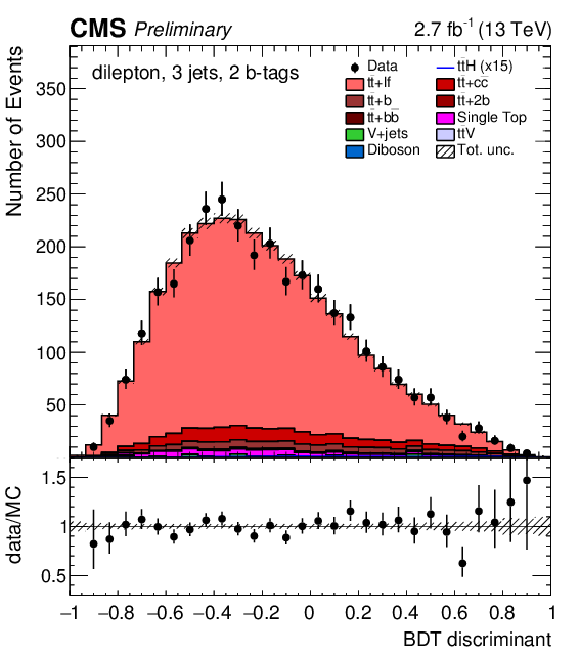
png pdf |
Figure 7-a:
Final discriminant shapes in all analysis categories in the dilepton channel after the fit to data. In the top row the (3 jets, 2 b-tags), (3 jets, 3 b-tags), and ($\geq$ 4 jets, 2 b-tags) are shown. Below are the ($\geq$ 4 jets, 3 b-tags) and ($\geq$ 4 jets, $\geq$ 4 b-tags) categories. The expected background contributions (filled histograms) are stacked, and the expected signal distribution (line) for a Higgs-boson mass of $ {m_{H}}=$ 125 GeV is superimposed. Each contribution is normalized to an integrated luminosity of 2.7 fb$^{-1}$, and the signal contribution is additionally scaled by a factor of 15 for better readability. The distributions in data (markers) are also shown. |
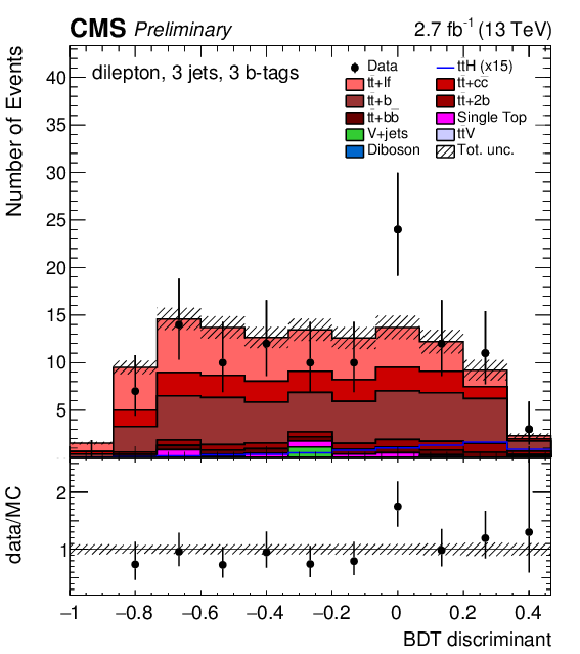
png pdf |
Figure 7-b:
Final discriminant shapes in all analysis categories in the dilepton channel after the fit to data. In the top row the (3 jets, 2 b-tags), (3 jets, 3 b-tags), and ($\geq$ 4 jets, 2 b-tags) are shown. Below are the ($\geq$ 4 jets, 3 b-tags) and ($\geq$ 4 jets, $\geq$ 4 b-tags) categories. The expected background contributions (filled histograms) are stacked, and the expected signal distribution (line) for a Higgs-boson mass of $ {m_{H}}=$ 125 GeV is superimposed. Each contribution is normalized to an integrated luminosity of 2.7 fb$^{-1}$, and the signal contribution is additionally scaled by a factor of 15 for better readability. The distributions in data (markers) are also shown. |
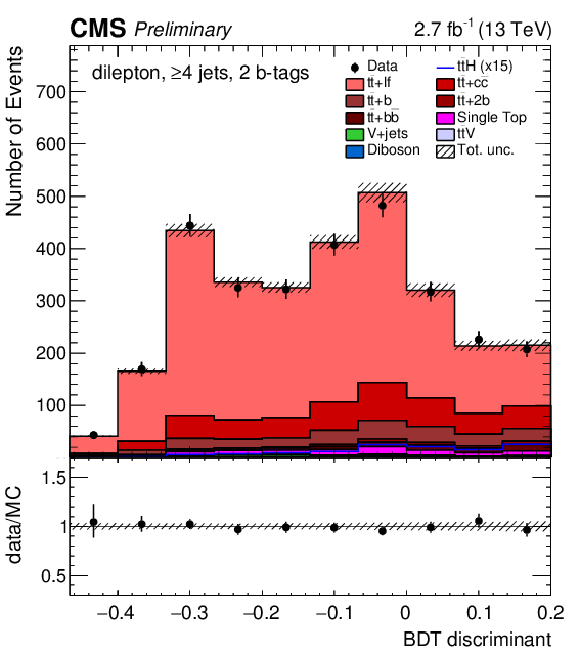
png pdf |
Figure 7-c:
Final discriminant shapes in all analysis categories in the dilepton channel after the fit to data. In the top row the (3 jets, 2 b-tags), (3 jets, 3 b-tags), and ($\geq$ 4 jets, 2 b-tags) are shown. Below are the ($\geq$ 4 jets, 3 b-tags) and ($\geq$ 4 jets, $\geq$ 4 b-tags) categories. The expected background contributions (filled histograms) are stacked, and the expected signal distribution (line) for a Higgs-boson mass of $ {m_{H}}=$ 125 GeV is superimposed. Each contribution is normalized to an integrated luminosity of 2.7 fb$^{-1}$, and the signal contribution is additionally scaled by a factor of 15 for better readability. The distributions in data (markers) are also shown. |

png pdf |
Figure 7-d:
Final discriminant shapes in all analysis categories in the dilepton channel after the fit to data. In the top row the (3 jets, 2 b-tags), (3 jets, 3 b-tags), and ($\geq$ 4 jets, 2 b-tags) are shown. Below are the ($\geq$ 4 jets, 3 b-tags) and ($\geq$ 4 jets, $\geq$ 4 b-tags) categories. The expected background contributions (filled histograms) are stacked, and the expected signal distribution (line) for a Higgs-boson mass of $ {m_{H}}=$ 125 GeV is superimposed. Each contribution is normalized to an integrated luminosity of 2.7 fb$^{-1}$, and the signal contribution is additionally scaled by a factor of 15 for better readability. The distributions in data (markers) are also shown. |
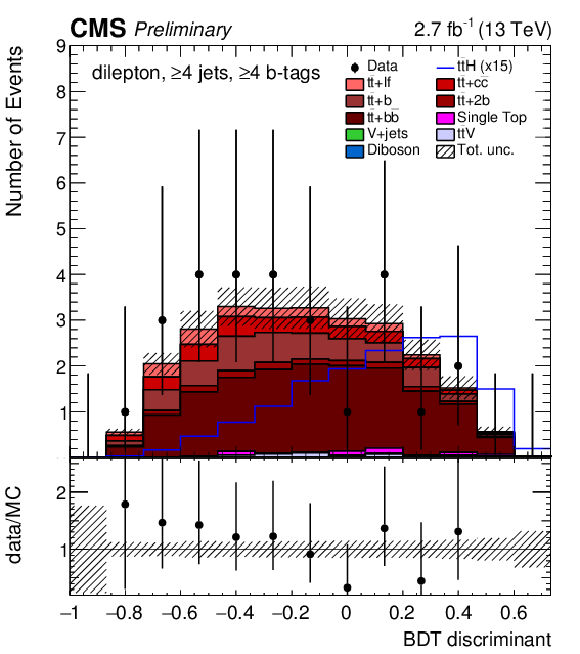
png pdf |
Figure 7-e:
Final discriminant shapes in all analysis categories in the dilepton channel after the fit to data. In the top row the (3 jets, 2 b-tags), (3 jets, 3 b-tags), and ($\geq$ 4 jets, 2 b-tags) are shown. Below are the ($\geq$ 4 jets, 3 b-tags) and ($\geq$ 4 jets, $\geq$ 4 b-tags) categories. The expected background contributions (filled histograms) are stacked, and the expected signal distribution (line) for a Higgs-boson mass of $ {m_{H}}=$ 125 GeV is superimposed. Each contribution is normalized to an integrated luminosity of 2.7 fb$^{-1}$, and the signal contribution is additionally scaled by a factor of 15 for better readability. The distributions in data (markers) are also shown. |
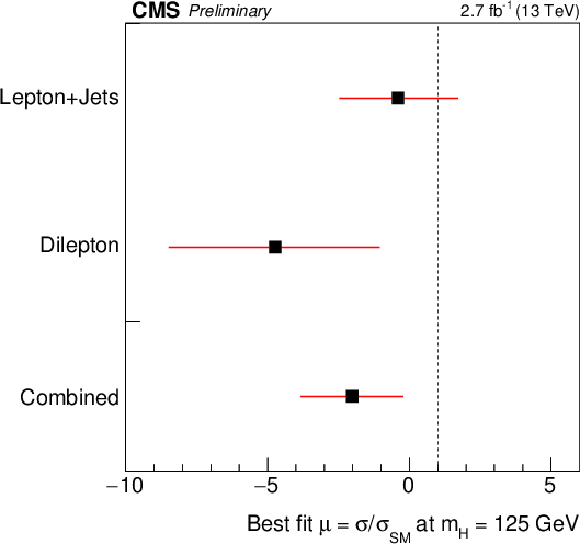
png pdf |
Figure 8-a:
(a) Best-fit values of the signal strength modifiers $\mu $ with their $\pm 1\sigma $ confidence intervals. (b) Median expected and observed 95% CL upper limits on $\mu $. The expected limits are displayed together with $\pm 1\sigma $ and $\pm 2\sigma $ confidence intervals. |
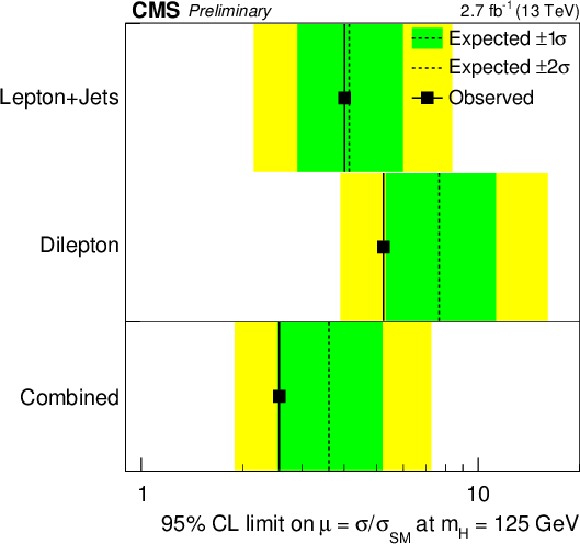
png pdf |
Figure 8-b:
(a) Best-fit values of the signal strength modifiers $\mu $ with their $\pm 1\sigma $ confidence intervals. (b) Median expected and observed 95% CL upper limits on $\mu $. The expected limits are displayed together with $\pm 1\sigma $ and $\pm 2\sigma $ confidence intervals. |
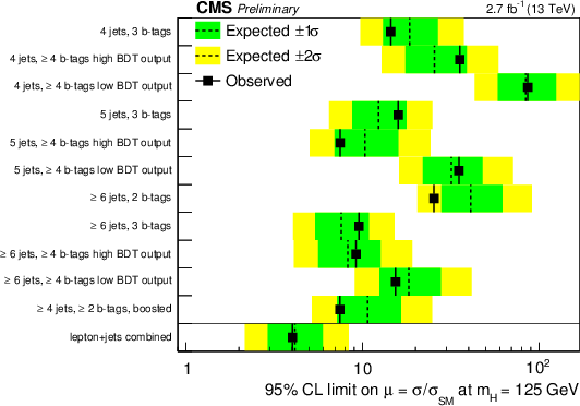
png pdf |
Figure 9:
Visualisation of 95% CL upper limits on $\mu $ in the lepton+jets channel. The limits are calculated with the asymptotic method and displayed as the median and the $\pm 1\sigma $ and $\pm 2\sigma $ confidence intervals. |

png pdf |
Figure 10:
Visualisation of 95% CL upper limits on $\mu $ in the dilepton channel. The limits are calculated with the asymptotic method and displayed as the median and the $\pm 1\sigma $ and $\pm 2\sigma $ confidence intervals. |
| Tables | |
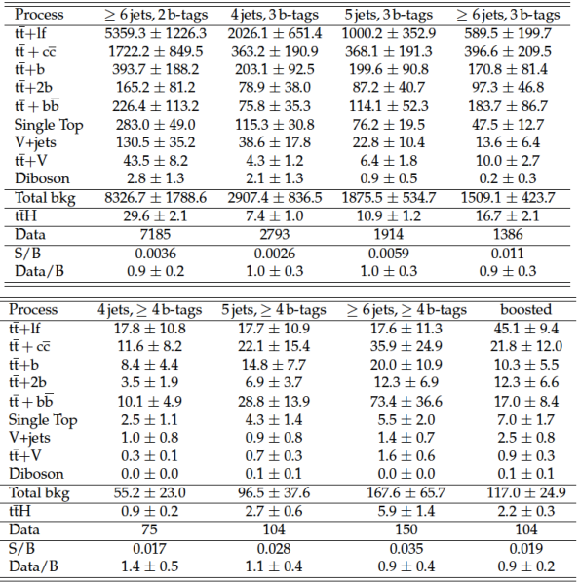
png pdf |
Table 1:
$ \mathrm{ t \bar{t} H } $ and background event yields for the lepton+jets categories. The processes and the separation of the $ \mathrm{ t \bar{t} } $+jets sample are described in Section 3. |

png pdf |
Table 2:
$ \mathrm{ t \bar{t} H } $ and background event yields for dilepton categories. The processes and the separation of the $ \mathrm{ t \bar{t} } $+jets sample are described in Section 3. |

png pdf |
Table 3:
Systematic uncertainties considered in the analysis. |

png pdf |
Table 4:
Specific effect of systematic uncertainties that affect the discriminant shape on the predicted background and signal yields for events in the 6 jets, 3 b-tags category of the lepton+jets channel. Here, only the sum of the largest background processes, $ \mathrm{ t \bar{t} }$+lf, $ \mathrm{ t \bar{t} } $+b, t $ \mathrm{ t \bar{t} } $+2b, $ \mathrm{ t \bar{t} } $+$\mathrm{ b \bar{b} }$, and $ \mathrm{ t \bar{t} } $+$\mathrm{ c \bar{c} }$, are considered. |
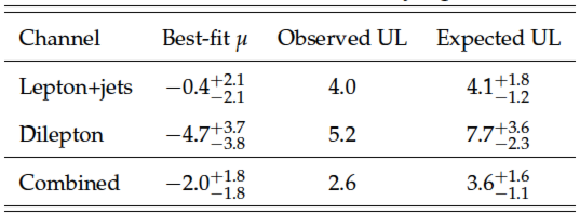
png pdf |
Table 5:
Best-fit value of the signal strength modifier $\mu $ and expected and observed 95% CL upper limits (UL) in the lepton+jets and dilepton channels as well as the combined results. The one standard deviation ($\pm 1\sigma $) confidence intervals of the best-fit value and the expected limit is also quoted. Expected limits are calculated with the asymptotic method [73]. |
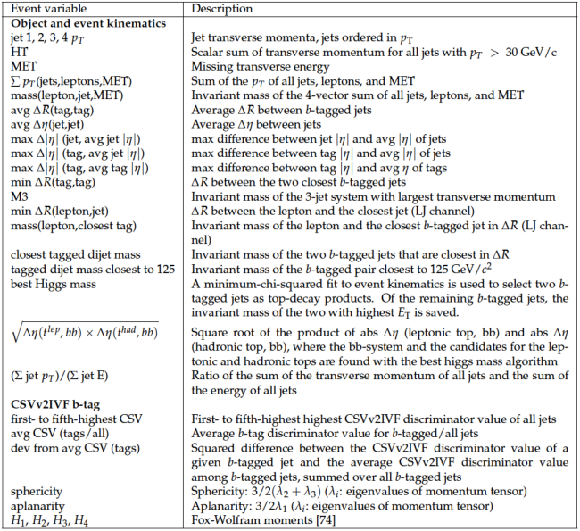
png pdf |
Table 6:
Variables used in the BDT training in the lepton+jets channel (continued in Table 7. |

png pdf |
Table 7:
continued from Table 6. |
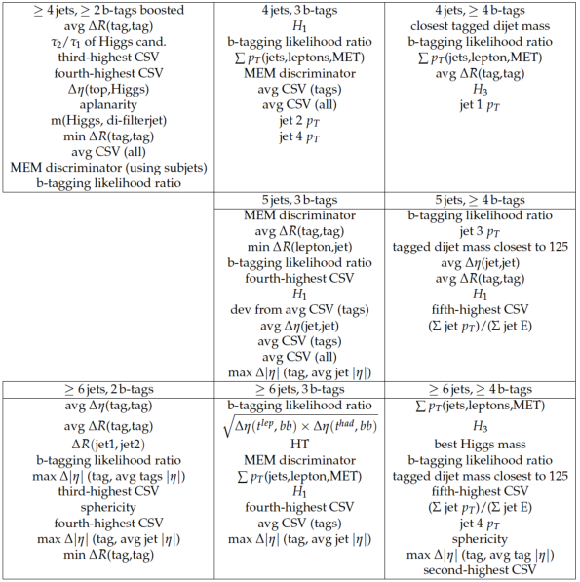
png pdf |
Table 8:
BDT input variable assignment per category in the lepton+jets channel. |
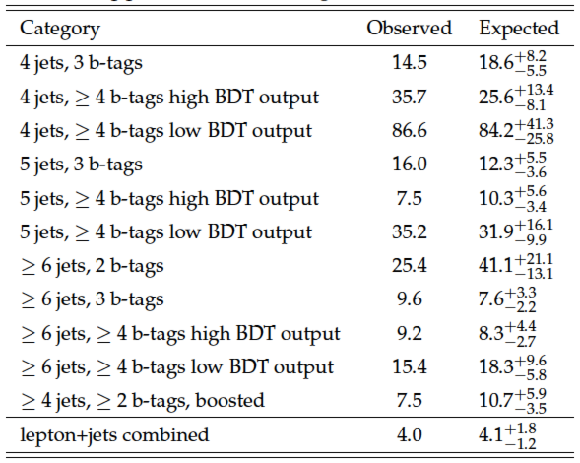
png pdf |
Table 9:
Median expected 95% CLs upper limits on $\mu $ in the lepton+jets channel, calculated with the asymptotic method. The upper and lower range of one standard deviation is also quoted. |
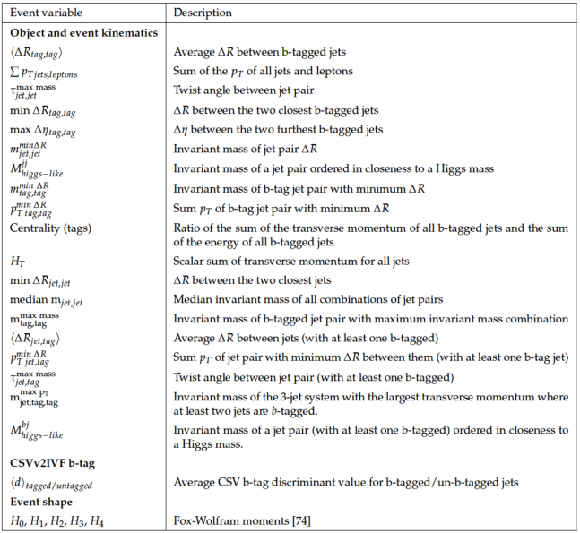
png pdf |
Table 10:
Variables used in the BDT training in the dilepton channel. |
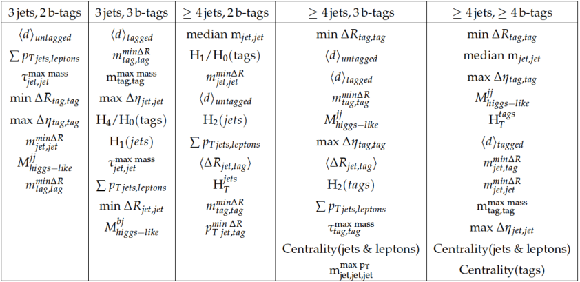
png pdf |
Table 11:
BDT input variable assignment per category in the dilepton channel. |

png pdf |
Table 12:
Median expected 95% CLs upper limits on $\mu $ in the dilepton channel, calculated with the asymptotic method. The upper and lower range of one standard deviation is also quoted. |
| Additional Figures | |

png pdf |
Additional Figure 1:
Fraction of processes contributing in the dilepton analysis categories. |
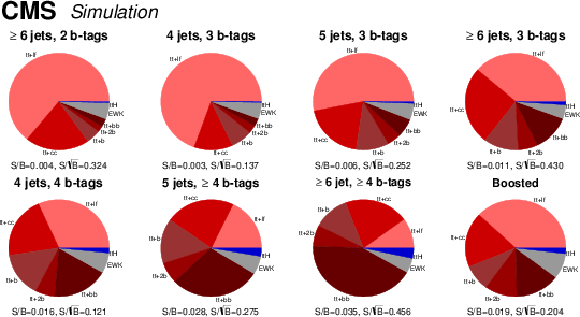
png pdf |
Additional Figure 2:
Fraction of processes contributing in the lepton+jets analysis categories. |
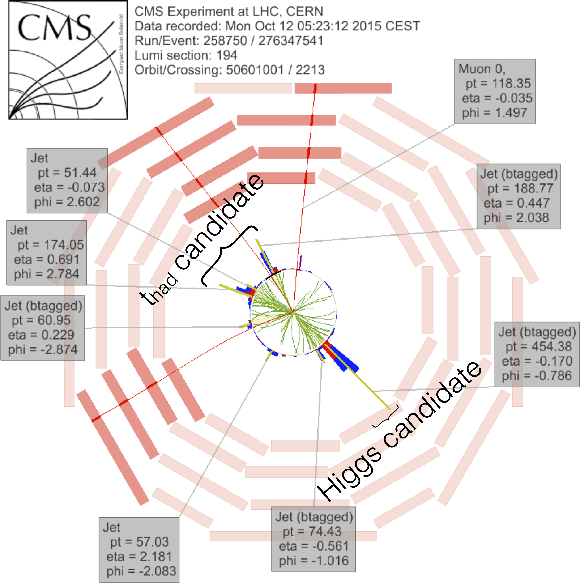
png |
Additional Figure 3:
Visualization of the detector signature of an event passing the single muon trigger, the lepton+jets boosted selection and the lepton+jets $\geq $ 6 jets, $\geq $ 4 b-tags selection. The properties of jets clustered with the anti-$k_{\mathrm{T}}$ algorithm are shown in the boxes. In addition, the candidates for the hadronically decaying top quark ($\mathrm{t}_{had}$) and the Higgs boson as identified by the boosted event reconstruction are marked. |
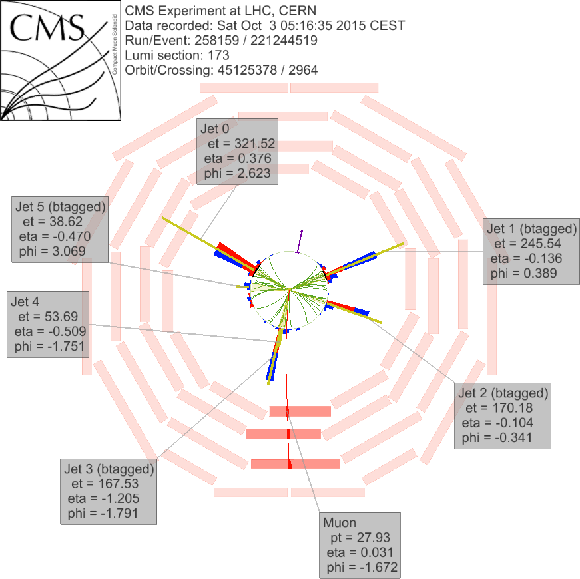
png |
Additional Figure 4:
Visualization of the detector signature of an event passing the single muon trigger and the lepton+jets $\geq $ 6 jets, $\geq $ 4 b-tags selection. The properties of jets clustered with the anti-$k_{\mathrm{T}}$ algorithm are shown in the boxes. |
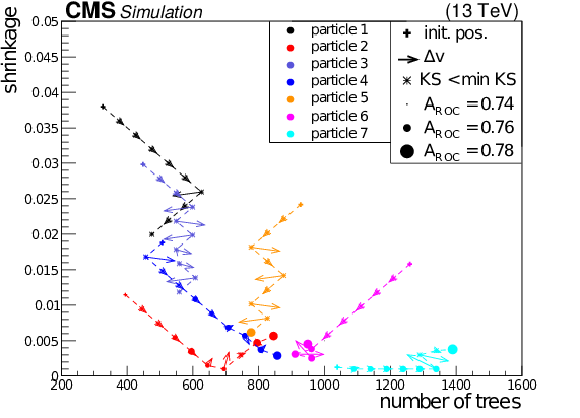
png pdf |
Additional Figure 5:
Illustration of the particle swarm based algorithm used for optimization of the boosted decision trees (BDT). Shown are the paths of BDT candidates (particles 1 to 7) in the plane spanned by the BDT parameters ``number of trees'' and ``shrinkage'' during the first 10 iterations of the algorithm. The parameter ``number of trees'' describes the number of trees in the current BDT configuration while the ``shrinkage'' parameter controls the learning rate of the BDT. At each position the combination of input variables of each BDT candidate is varied to optimize the area under the receiver-operator-curve while maintaining a minimal Kolmogorov-Smirnov probability between test and training distributions. After each iteration, the candidates move to new points in parameter space, dependent upon their own and the swarms best previous positions. The cross shaped markers indicate the positions of the particles at the first iteration. The sizes of the circular markers indicate the areas under the best receiver-operator-curves $\text {A}_{\text {ROC}}$ at the positions while the arrows indicate the change in velocity $\Delta \text {v}$ of the particles. Star shaped markers indicate that the best result at this point has a Kolmogorov-Smirnov probability below the threshold. For better visibility, only a subset of BDT candidates is shown. The BDTs were trained using simulated $\mathrm{ t \bar{t} H ( H\rightarrow b \bar{b} ) } $ events as signal and $\mathrm{ t \bar{t} }$ events as background. |
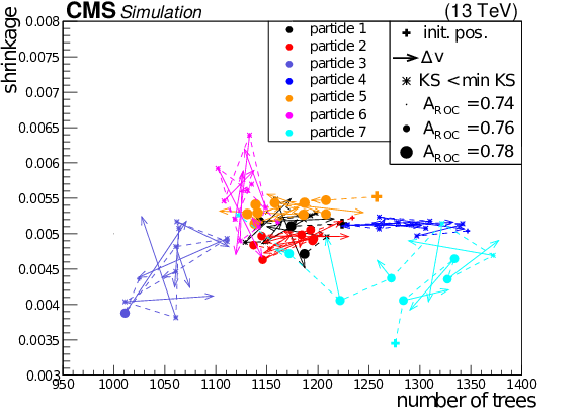
png pdf |
Additional Figure 6:
Same as Fig. 5, but for the iterations 50 to 60 of the algorithm. The candidates have now converged to a smaller region in parameter space. |
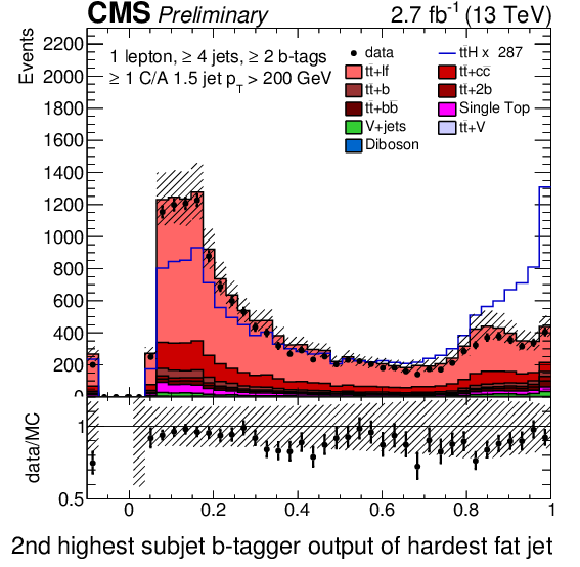
png pdf |
Additional Figure 7:
Discriminant for the identification of boosted Higgs bosons in data and simulation in an inclusive control region requiring exactly one tight lepton, at least 4 jets, and 2 b-tags. The discriminant is given by the second highest b-tagger output among the three subjets with the highest transverse momentum of a selected Higgs-boson candidate fat jet. The subjets are derived by applying the subjet filterjet algorithm which uses a mass drop requirement and a filtering technique on the selected Higgs-boson candidate C/A 1.5 fat jet. |
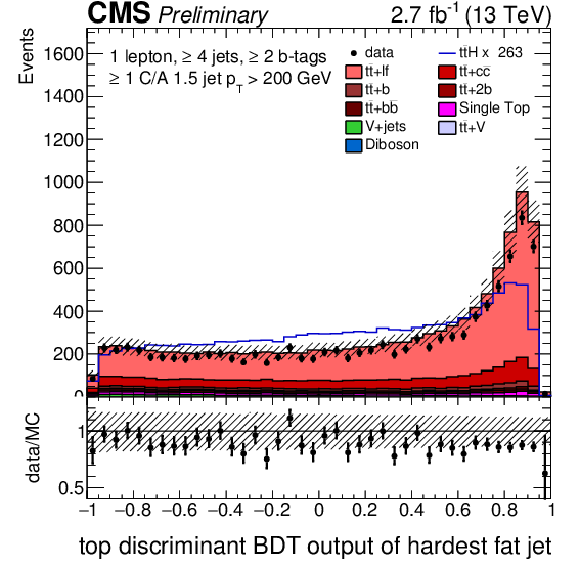
png pdf |
Additional Figure 8:
Output distribution of the BDT used to identify boosted top quarks in data and simulation in an inclusive control region requiring exactly one tight lepton, at least 4 jets, and 2 b-tags. The BDT is trained on fat jets from simulated $\mathrm{ t \bar{t} }$ events using subjets and further substructure information provided by the HEP Top Tagger Algorithm V2 as input variables |
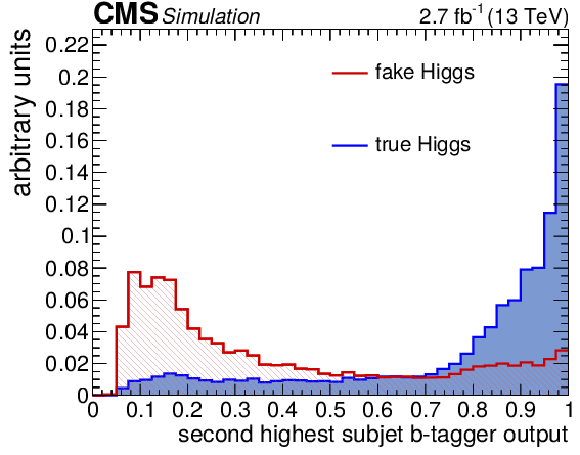
png pdf |
Additional Figure 9:
Discriminant for the identification of boosted Higgs bosons evaluated for "true" and "fake" Higgs-boson candidate fat jets in simulated $\mathrm{ t \bar{t} H (H \rightarrow b \bar{b} )}$ events with at least 4 jets, and 2 b-tags. The discriminant is given by the second highest b-tagger output among the three subjets with the highest transverse momentum of a selected Higgs-boson candidate fat jet. The subjets are derived by applying a substructure algorithm including a mass drop requirement and a filtering technique on the selected Higgs-boson candidate fat jet clustered with the Cambridge/Aachen algorithm. The distinction between ``true'' and ``fake'' fat jets is given by an angular matching of reconstructed fat jets to the generated Higgs boson. |
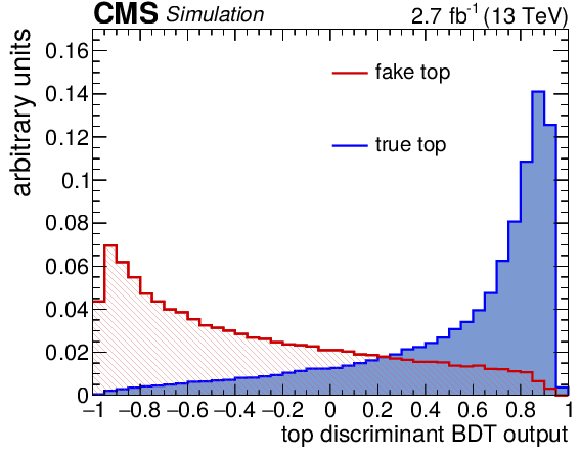
png pdf |
Additional Figure 10:
Discriminant for the identification of boosted hadronically decaying top quarks evaluated for ``true'' and ``fake'' hadronic top-quark candidate fat jets in simulated $\mathrm{ t \bar{t} }$ events with at least 4 jets, and 2 b-tags. The discriminant is given by a BDT trained on fat jets from simulated $\mathrm{ t \bar{t} }$ events using subjets and further substructure information provided by the HEP Top Tagger Algorithm V2 as input variables. The distinction between ``true'' and ``fake'' fat jets is given by an angular matching of reconstructed fat jets to generated hadronically decaying top quarks. |
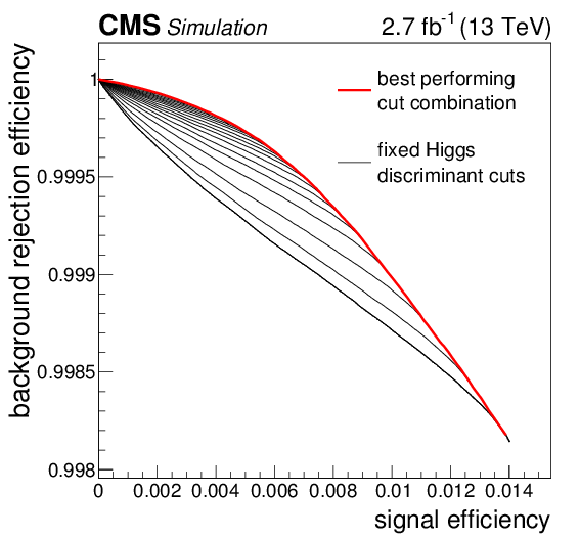
png pdf |
Additional Figure 11:
Receiver-operator-characteristics describing the selection efficiencies of signal and background events for different combinations of cuts on the boosted Higgs boson and top discriminant outputs. A set of receiver-operator-characteristics for different cuts on the boosted top discriminant and for fixed cuts on the boosted Higgs boson discriminant are shown in black. The cut combinations with the highest background rejection for a given signal efficiency are given by the top-most (red) curve. The curves were generated with simulated $\mathrm{ t \bar{t} H (H \rightarrow b \bar{b} )}$ events as signal and semileponically decaying $\mathrm{ t \bar{t} }$ events as background. |
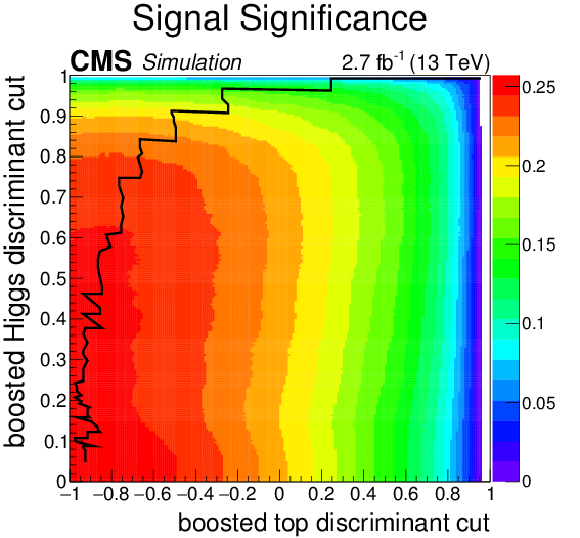
png pdf |
Additional Figure 12:
Signal significance of the boosted event selection for different combinations of cuts on the boosted Higgs boson and BDT top tagger discriminant outputs. The significance was evaluated using simulated $\mathrm{ t \bar{t} H (H \rightarrow b \bar{b} )}$ events as signal and semileponically decaying $\mathrm{ t \bar{t} }$ events as background. The black line indicates the cut combination with the highest background rejection for a given signal efficiency. |
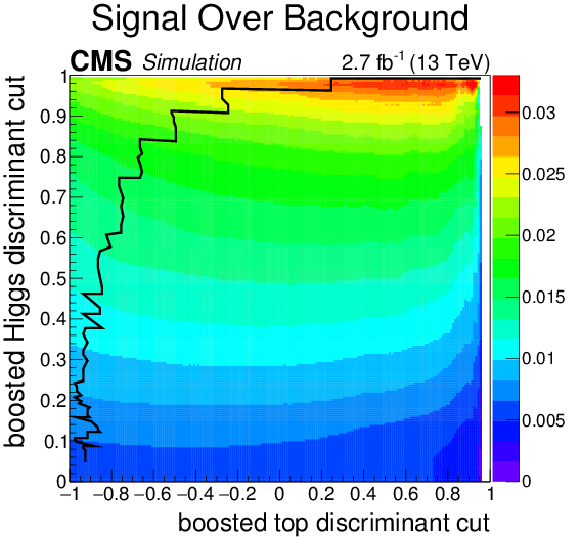
png pdf |
Additional Figure 13:
Ratio of the signal and background event selection efficiency of the boosted event selection for different combinations of cuts on the boosted Higgs boson and BDT top tagger discriminant outputs. The efficiencies were determined using simulated $\mathrm{ t \bar{t} H (H \rightarrow b \bar{b} )}$ events as signal and semileponically decaying $\mathrm{ t \bar{t} }$ events as background. The black line indicates the cut combination with the highest background rejection for a given signal efficiency. |
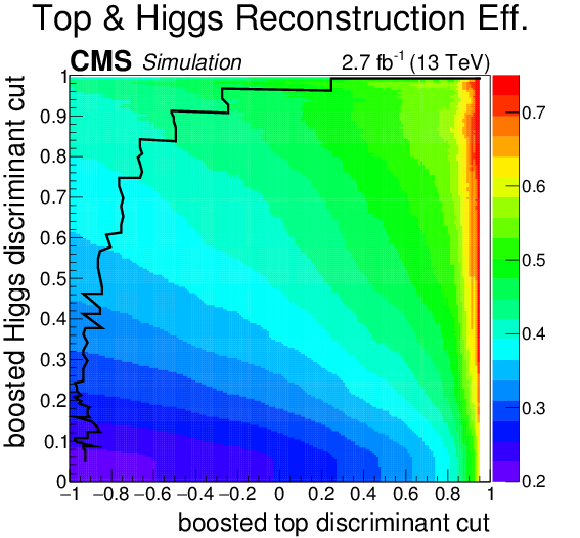
png pdf |
Additional Figure 14:
Efficiency of correctly reconstructing the Higgs boson and the hadronically top quark for different combinations of cuts on the boosted Higgs boson and BDT top tagger discriminant outputs. A boosted event is considered as correctly reconstructed if the Higgs boson candidate and the candidate for the hadronically decaying top quark can be matched to the respective generated particles within an angular distance of $\Delta R<$ 0.5. The efficiencies were determined using simulated $\mathrm{ t \bar{t} H (H \rightarrow b \bar{b} )}$ events as signal and semileponically decaying $\mathrm{ t \bar{t} }$ events as background. The black line indicates the cut combination with the highest background rejection for a given signal efficiency. |
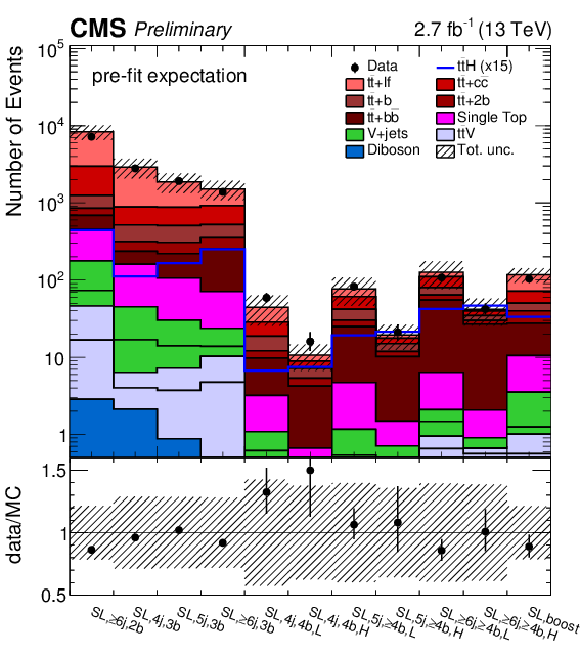
png pdf |
Additional Figure 15:
Predicted (histograms) and observed (markers) event yields per analysis category in the lepton+jets channel before the fit to data, corresponding to an integrated luminosity of 2.7 fb$^{-1}$. The expected contributions of the different background processes (filled histograms) are stacked, and the expected signal distribution (line) for a Higgs-boson mass of $m_{\mathrm{H}} =$ 125 GeV is superimposed and scaled by a factor of 15 for better visibility. |
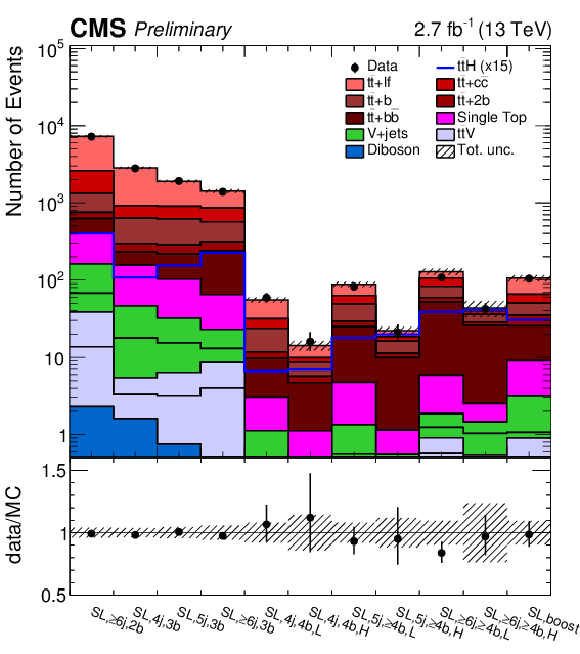
png pdf |
Additional Figure 16:
Event yields per analysis category in the lepton+jets channel after the fit to data (markers), corresponding to an integrated luminosity of 2.7 fb$^{-1}$. The fitted contributions of the different $\mathrm{ t \bar{t} }$+jets and other background processes (filled histograms) are stacked, and the expected signal distribution (line) for a Higgs-boson mass of $m_{\mathrm{H}} =$ 125 GeV is superimposed and scaled by a factor of 15 for better visibility. |
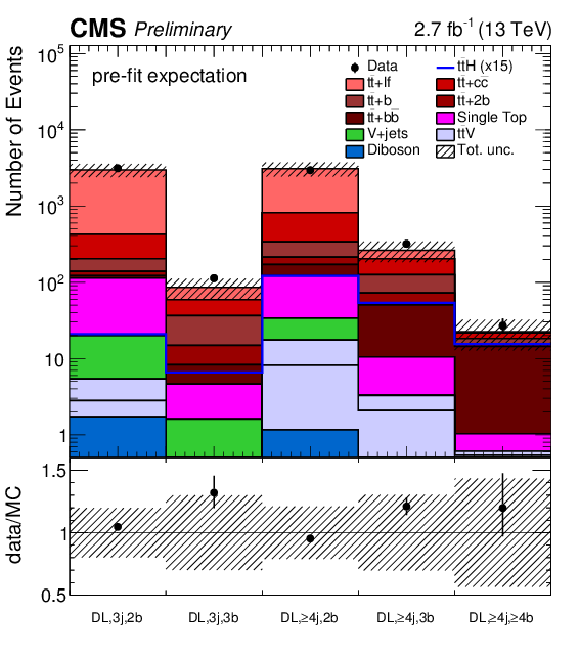
png pdf |
Additional Figure 17:
Predicted (histograms) and observed (markers) event yields per analysis category in the dilepton channel before the fit to data, corresponding to an integrated luminosity of 2.7 fb$^{-1}$. The expected contributions of the different background processes (filled histograms) are stacked, and the expected signal distribution (line) for a Higgs-boson mass of $m_{\mathrm{H}} =$ 125 GeV is superimposed and scaled by a factor of 15 for better visibility. |
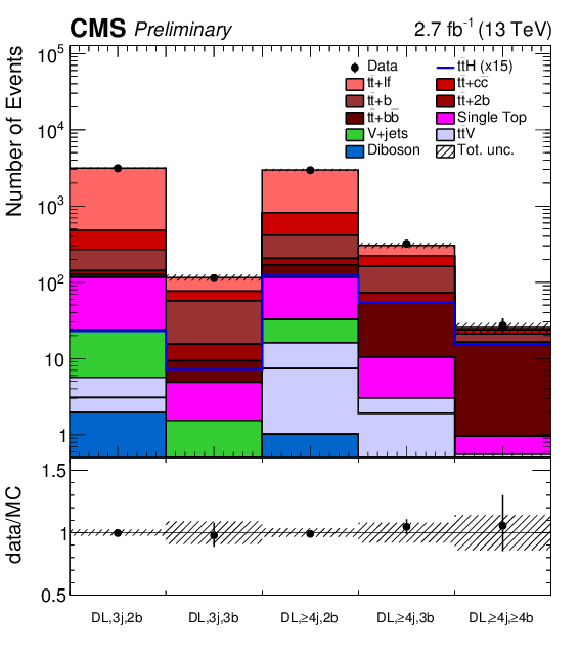
png pdf |
Additional Figure 18:
Event yields per analysis category in the dilepton channel after the fit to data (markers), corresponding to an integrated luminosity of 2.7 fb$^{-1}$. The fitted contributions of the different $\mathrm{ t \bar{t} }$+jets and other background processes (filled histograms) are stacked, and the expected signal distribution (line) for a Higgs-boson mass of $m_{\mathrm{H}} =$ 125 GeV is superimposed and scaled by a factor of 15 for better visibility. |

png pdf |
Additional Figure 19-a:
Data-to-simulation comparison of the BDT input distributions in the 4 jets, 3 b-tags category of the lepton+jets channel corresponding to an integrated luminosity of 2.7 fb$^{-1}$. The expected contributions of the different background processes (filled histograms) are stacked. The expected signal distribution (line) for a Higgs-boson mass of $m_{\mathrm{H}} =$ 125 GeV is superimposed; it has been normalized to the sum of backgrounds for better visibility. |

png pdf |
Additional Figure 19-b:
Data-to-simulation comparison of the BDT input distributions in the 4 jets, 3 b-tags category of the lepton+jets channel corresponding to an integrated luminosity of 2.7 fb$^{-1}$. The expected contributions of the different background processes (filled histograms) are stacked. The expected signal distribution (line) for a Higgs-boson mass of $m_{\mathrm{H}} =$ 125 GeV is superimposed; it has been normalized to the sum of backgrounds for better visibility. |

png pdf |
Additional Figure 19-c:
Data-to-simulation comparison of the BDT input distributions in the 4 jets, 3 b-tags category of the lepton+jets channel corresponding to an integrated luminosity of 2.7 fb$^{-1}$. The expected contributions of the different background processes (filled histograms) are stacked. The expected signal distribution (line) for a Higgs-boson mass of $m_{\mathrm{H}} =$ 125 GeV is superimposed; it has been normalized to the sum of backgrounds for better visibility. |

png pdf |
Additional Figure 19-d:
Data-to-simulation comparison of the BDT input distributions in the 4 jets, 3 b-tags category of the lepton+jets channel corresponding to an integrated luminosity of 2.7 fb$^{-1}$. The expected contributions of the different background processes (filled histograms) are stacked. The expected signal distribution (line) for a Higgs-boson mass of $m_{\mathrm{H}} =$ 125 GeV is superimposed; it has been normalized to the sum of backgrounds for better visibility. |
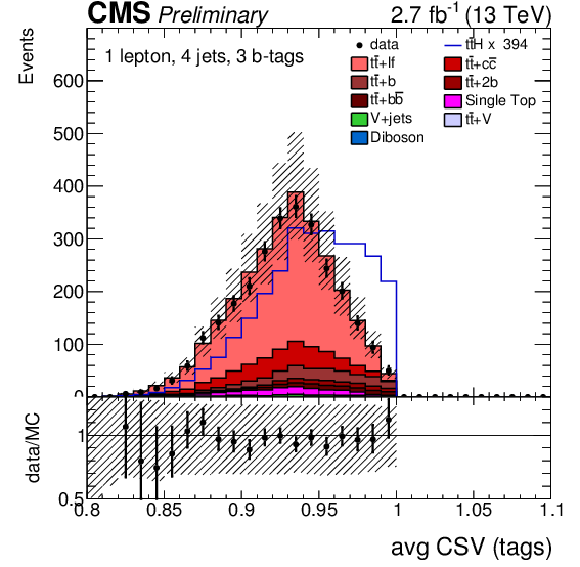
png pdf |
Additional Figure 19-e:
Data-to-simulation comparison of the BDT input distributions in the 4 jets, 3 b-tags category of the lepton+jets channel corresponding to an integrated luminosity of 2.7 fb$^{-1}$. The expected contributions of the different background processes (filled histograms) are stacked. The expected signal distribution (line) for a Higgs-boson mass of $m_{\mathrm{H}} =$ 125 GeV is superimposed; it has been normalized to the sum of backgrounds for better visibility. |
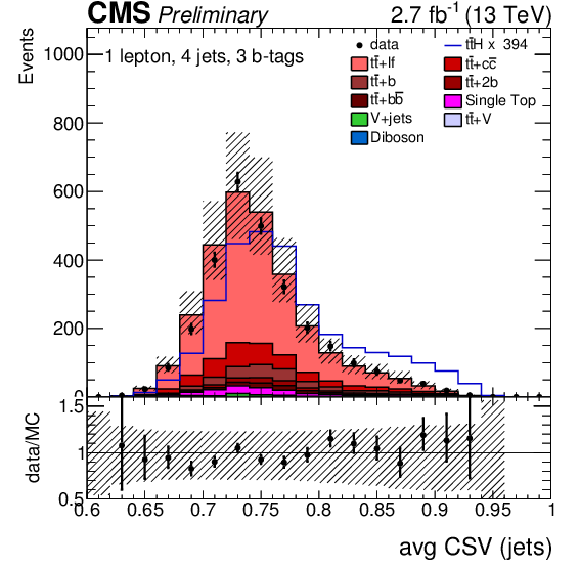
png pdf |
Additional Figure 19-f:
Data-to-simulation comparison of the BDT input distributions in the 4 jets, 3 b-tags category of the lepton+jets channel corresponding to an integrated luminosity of 2.7 fb$^{-1}$. The expected contributions of the different background processes (filled histograms) are stacked. The expected signal distribution (line) for a Higgs-boson mass of $m_{\mathrm{H}} =$ 125 GeV is superimposed; it has been normalized to the sum of backgrounds for better visibility. |

png pdf |
Additional Figure 19-g:
Data-to-simulation comparison of the BDT input distributions in the 4 jets, 3 b-tags category of the lepton+jets channel corresponding to an integrated luminosity of 2.7 fb$^{-1}$. The expected contributions of the different background processes (filled histograms) are stacked. The expected signal distribution (line) for a Higgs-boson mass of $m_{\mathrm{H}} =$ 125 GeV is superimposed; it has been normalized to the sum of backgrounds for better visibility. |
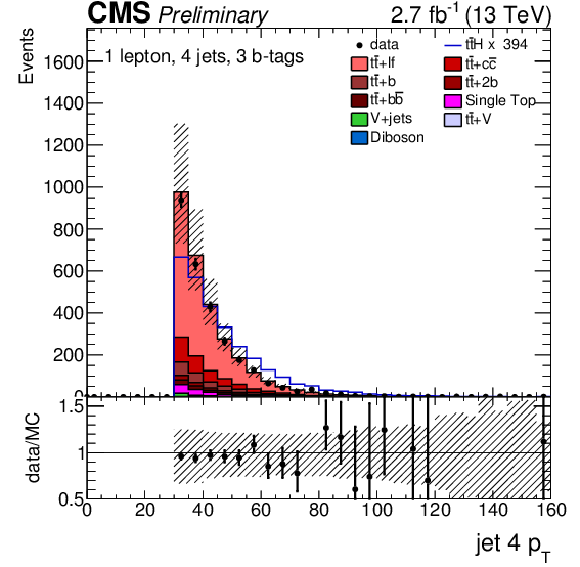
png pdf |
Additional Figure 19-h:
Data-to-simulation comparison of the BDT input distributions in the 4 jets, 3 b-tags category of the lepton+jets channel corresponding to an integrated luminosity of 2.7 fb$^{-1}$. The expected contributions of the different background processes (filled histograms) are stacked. The expected signal distribution (line) for a Higgs-boson mass of $m_{\mathrm{H}} =$ 125 GeV is superimposed; it has been normalized to the sum of backgrounds for better visibility. |
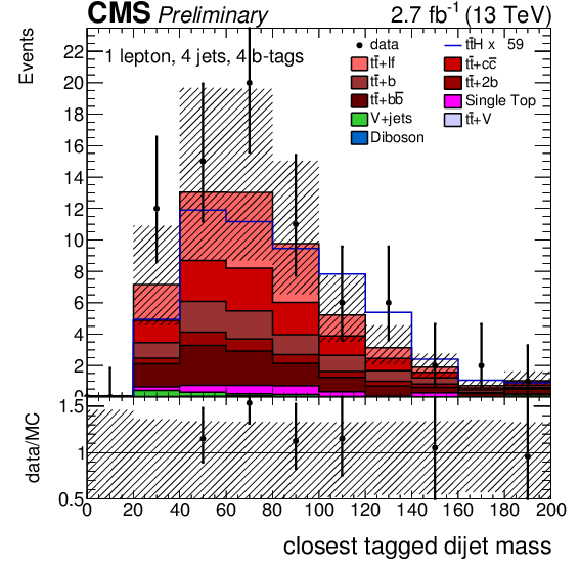
png pdf |
Additional Figure 20-a:
Data-to-simulation comparison of the BDT input distributions in the 4 jets 4 b-tags category of the lepton+jets channel corresponding to an integrated luminosity of 2.7 fb$^{-1}$. The expected contributions of the different background processes (filled histograms) are stacked. The expected signal distribution (line) for a Higgs-boson mass of $m_{\mathrm{H}} =$ 125 GeV is superimposed; it has been normalized to the sum of backgrounds for better visibility. |
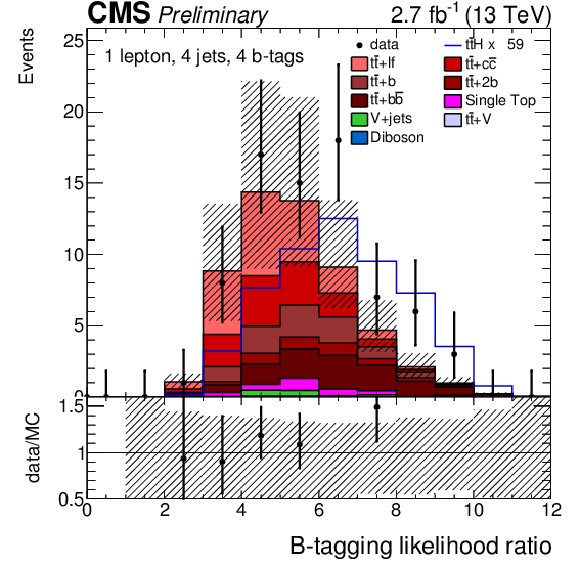
png pdf |
Additional Figure 20-b:
Data-to-simulation comparison of the BDT input distributions in the 4 jets 4 b-tags category of the lepton+jets channel corresponding to an integrated luminosity of 2.7 fb$^{-1}$. The expected contributions of the different background processes (filled histograms) are stacked. The expected signal distribution (line) for a Higgs-boson mass of $m_{\mathrm{H}} =$ 125 GeV is superimposed; it has been normalized to the sum of backgrounds for better visibility. |
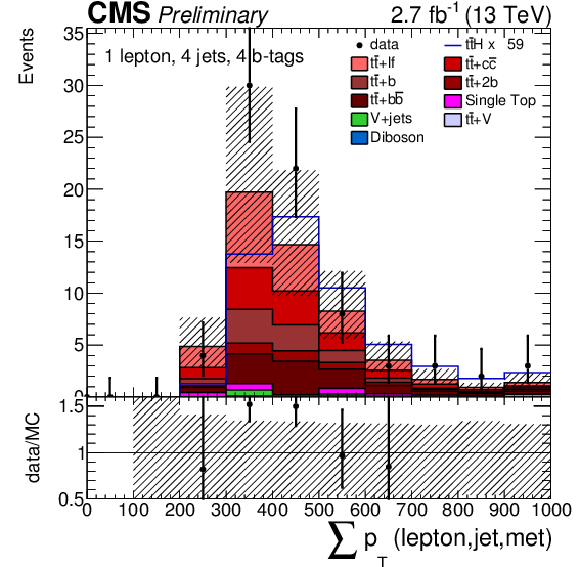
png pdf |
Additional Figure 20-c:
Data-to-simulation comparison of the BDT input distributions in the 4 jets 4 b-tags category of the lepton+jets channel corresponding to an integrated luminosity of 2.7 fb$^{-1}$. The expected contributions of the different background processes (filled histograms) are stacked. The expected signal distribution (line) for a Higgs-boson mass of $m_{\mathrm{H}} =$ 125 GeV is superimposed; it has been normalized to the sum of backgrounds for better visibility. |
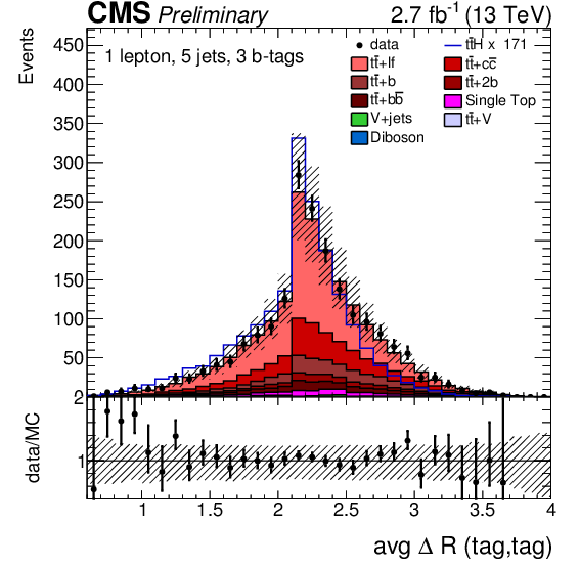
png pdf |
Additional Figure 20-d:
Data-to-simulation comparison of the BDT input distributions in the 4 jets 4 b-tags category of the lepton+jets channel corresponding to an integrated luminosity of 2.7 fb$^{-1}$. The expected contributions of the different background processes (filled histograms) are stacked. The expected signal distribution (line) for a Higgs-boson mass of $m_{\mathrm{H}} =$ 125 GeV is superimposed; it has been normalized to the sum of backgrounds for better visibility. |
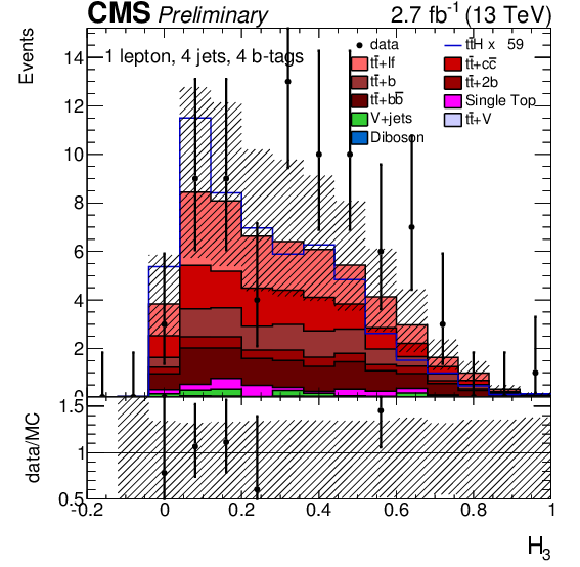
png pdf |
Additional Figure 20-e:
Data-to-simulation comparison of the BDT input distributions in the 4 jets 4 b-tags category of the lepton+jets channel corresponding to an integrated luminosity of 2.7 fb$^{-1}$. The expected contributions of the different background processes (filled histograms) are stacked. The expected signal distribution (line) for a Higgs-boson mass of $m_{\mathrm{H}} =$ 125 GeV is superimposed; it has been normalized to the sum of backgrounds for better visibility. |
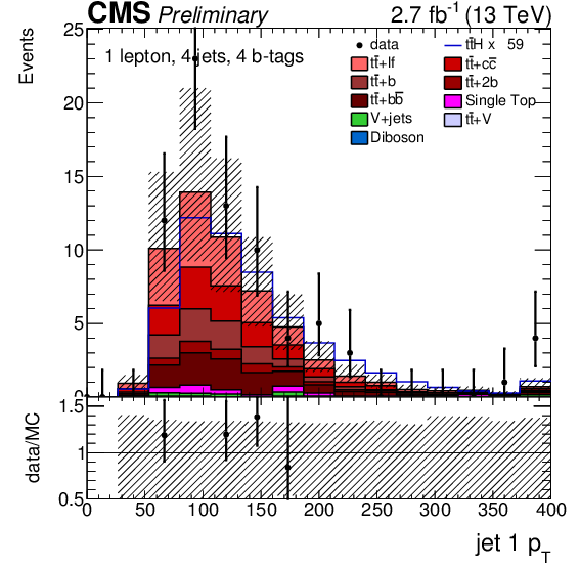
png pdf |
Additional Figure 20-f:
Data-to-simulation comparison of the BDT input distributions in the 4 jets 4 b-tags category of the lepton+jets channel corresponding to an integrated luminosity of 2.7 fb$^{-1}$. The expected contributions of the different background processes (filled histograms) are stacked. The expected signal distribution (line) for a Higgs-boson mass of $m_{\mathrm{H}} =$ 125 GeV is superimposed; it has been normalized to the sum of backgrounds for better visibility. |
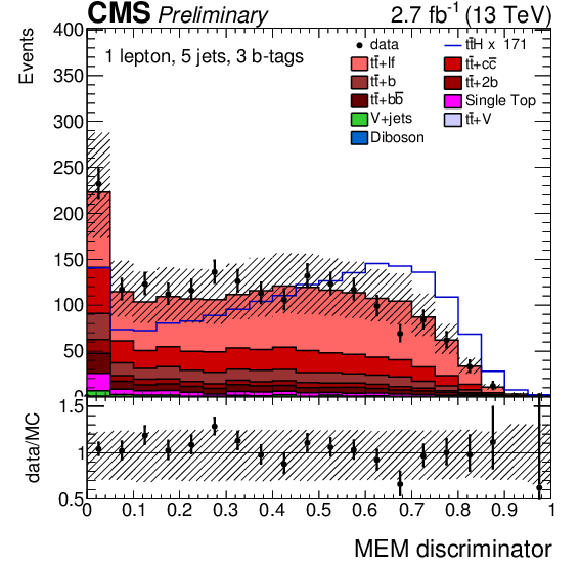
png pdf |
Additional Figure 21-a:
Data-to-simulation comparison of the BDT input distributions in the 5 jets, 3 b-tags category of the lepton+jets channel corresponding to an integrated luminosity of 2.7 fb$^{-1}$. The expected contributions of the different background processes (filled histograms) are stacked. The expected signal distribution (line) for a Higgs-boson mass of $m_{\mathrm{H}} =$ 125 GeV is superimposed; it has been normalized to the sum of backgrounds for better visibility. |

png pdf |
Additional Figure 21-b:
Data-to-simulation comparison of the BDT input distributions in the 5 jets, 3 b-tags category of the lepton+jets channel corresponding to an integrated luminosity of 2.7 fb$^{-1}$. The expected contributions of the different background processes (filled histograms) are stacked. The expected signal distribution (line) for a Higgs-boson mass of $m_{\mathrm{H}} =$ 125 GeV is superimposed; it has been normalized to the sum of backgrounds for better visibility. |
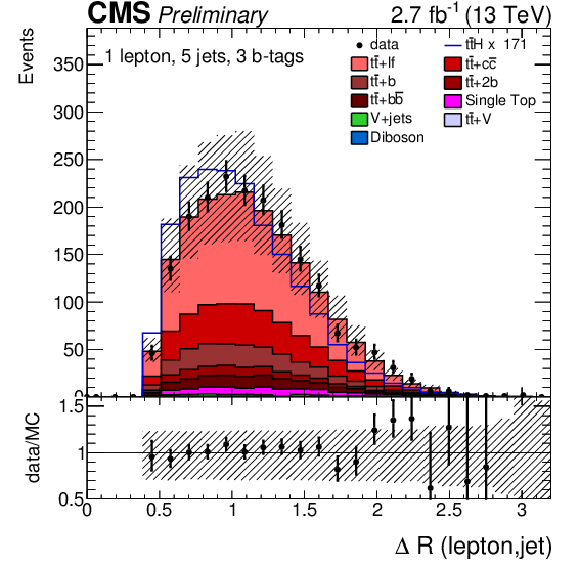
png pdf |
Additional Figure 21-c:
Data-to-simulation comparison of the BDT input distributions in the 5 jets, 3 b-tags category of the lepton+jets channel corresponding to an integrated luminosity of 2.7 fb$^{-1}$. The expected contributions of the different background processes (filled histograms) are stacked. The expected signal distribution (line) for a Higgs-boson mass of $m_{\mathrm{H}} =$ 125 GeV is superimposed; it has been normalized to the sum of backgrounds for better visibility. |
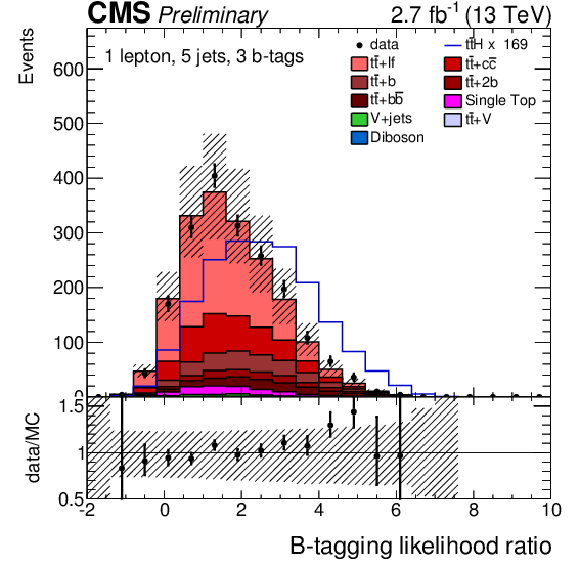
png pdf |
Additional Figure 21-d:
Data-to-simulation comparison of the BDT input distributions in the 5 jets, 3 b-tags category of the lepton+jets channel corresponding to an integrated luminosity of 2.7 fb$^{-1}$. The expected contributions of the different background processes (filled histograms) are stacked. The expected signal distribution (line) for a Higgs-boson mass of $m_{\mathrm{H}} =$ 125 GeV is superimposed; it has been normalized to the sum of backgrounds for better visibility. |
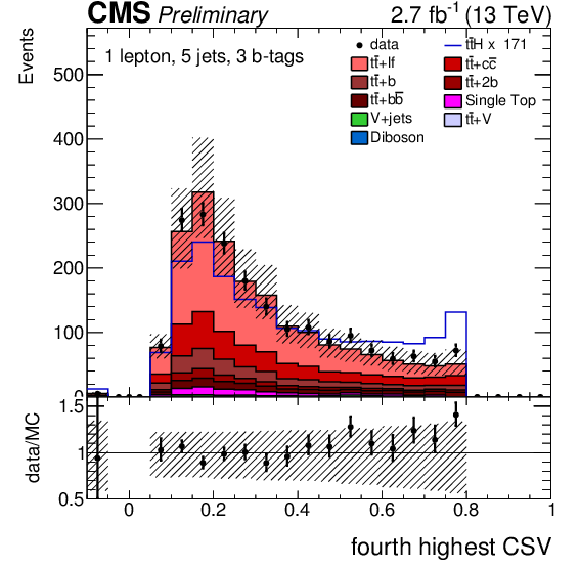
png pdf |
Additional Figure 21-e:
Data-to-simulation comparison of the BDT input distributions in the 5 jets, 3 b-tags category of the lepton+jets channel corresponding to an integrated luminosity of 2.7 fb$^{-1}$. The expected contributions of the different background processes (filled histograms) are stacked. The expected signal distribution (line) for a Higgs-boson mass of $m_{\mathrm{H}} =$ 125 GeV is superimposed; it has been normalized to the sum of backgrounds for better visibility. |

png pdf |
Additional Figure 21-f:
Data-to-simulation comparison of the BDT input distributions in the 5 jets, 3 b-tags category of the lepton+jets channel corresponding to an integrated luminosity of 2.7 fb$^{-1}$. The expected contributions of the different background processes (filled histograms) are stacked. The expected signal distribution (line) for a Higgs-boson mass of $m_{\mathrm{H}} =$ 125 GeV is superimposed; it has been normalized to the sum of backgrounds for better visibility. |
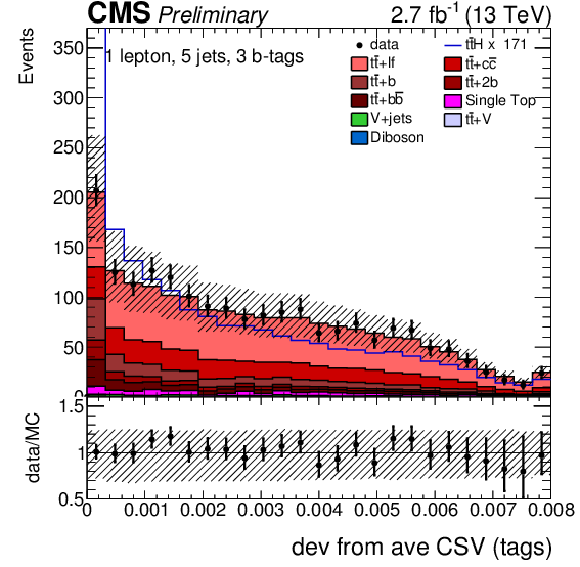
png pdf |
Additional Figure 21-g:
Data-to-simulation comparison of the BDT input distributions in the 5 jets, 3 b-tags category of the lepton+jets channel corresponding to an integrated luminosity of 2.7 fb$^{-1}$. The expected contributions of the different background processes (filled histograms) are stacked. The expected signal distribution (line) for a Higgs-boson mass of $m_{\mathrm{H}} =$ 125 GeV is superimposed; it has been normalized to the sum of backgrounds for better visibility. |
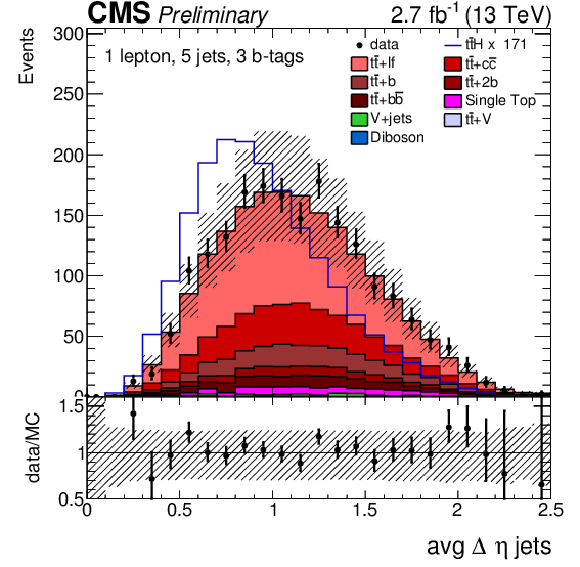
png pdf |
Additional Figure 21-h:
Data-to-simulation comparison of the BDT input distributions in the 5 jets, 3 b-tags category of the lepton+jets channel corresponding to an integrated luminosity of 2.7 fb$^{-1}$. The expected contributions of the different background processes (filled histograms) are stacked. The expected signal distribution (line) for a Higgs-boson mass of $m_{\mathrm{H}} =$ 125 GeV is superimposed; it has been normalized to the sum of backgrounds for better visibility. |
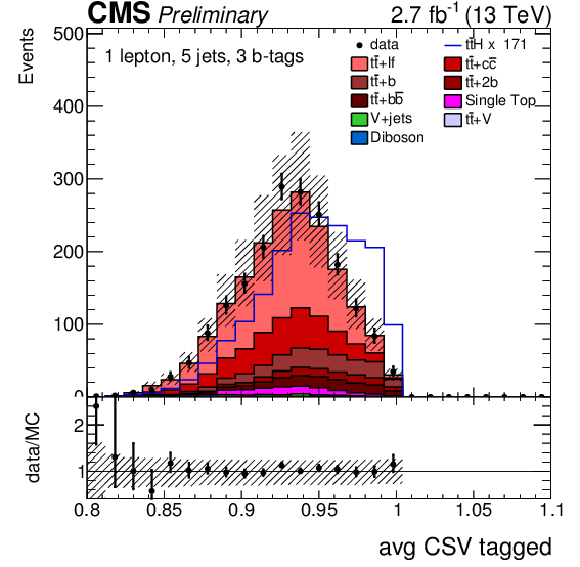
png pdf |
Additional Figure 21-i:
Data-to-simulation comparison of the BDT input distributions in the 5 jets, 3 b-tags category of the lepton+jets channel corresponding to an integrated luminosity of 2.7 fb$^{-1}$. The expected contributions of the different background processes (filled histograms) are stacked. The expected signal distribution (line) for a Higgs-boson mass of $m_{\mathrm{H}} =$ 125 GeV is superimposed; it has been normalized to the sum of backgrounds for better visibility. |

png pdf |
Additional Figure 21-j:
Data-to-simulation comparison of the BDT input distributions in the 5 jets, 3 b-tags category of the lepton+jets channel corresponding to an integrated luminosity of 2.7 fb$^{-1}$. The expected contributions of the different background processes (filled histograms) are stacked. The expected signal distribution (line) for a Higgs-boson mass of $m_{\mathrm{H}} =$ 125 GeV is superimposed; it has been normalized to the sum of backgrounds for better visibility. |
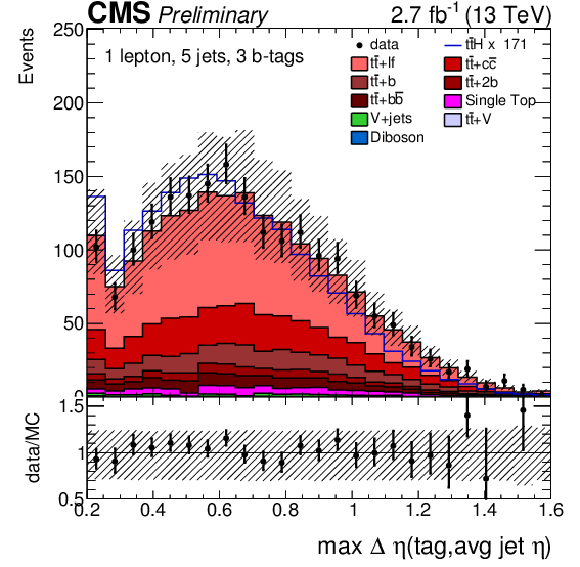
png pdf |
Additional Figure 21-k:
Data-to-simulation comparison of the BDT input distributions in the 5 jets, 3 b-tags category of the lepton+jets channel corresponding to an integrated luminosity of 2.7 fb$^{-1}$. The expected contributions of the different background processes (filled histograms) are stacked. The expected signal distribution (line) for a Higgs-boson mass of $m_{\mathrm{H}} =$ 125 GeV is superimposed; it has been normalized to the sum of backgrounds for better visibility. |
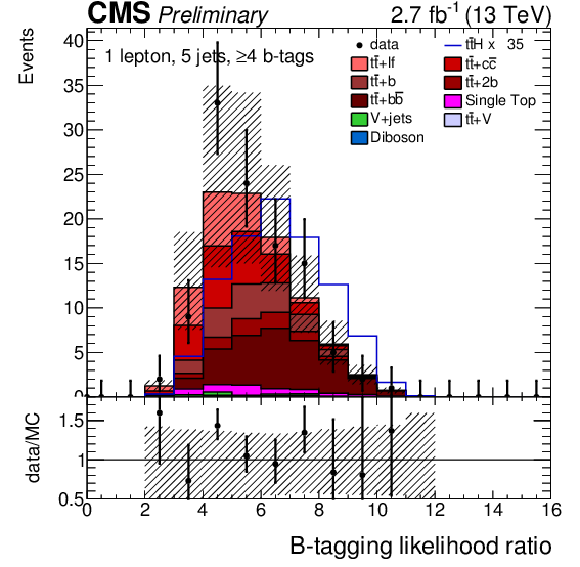
png pdf |
Additional Figure 22-a:
Data-to-simulation comparison of the BDT input distributions in the 5 jets, $\geq $ 4 b-tags category of the lepton+jets channel corresponding to an integrated luminosity of 2.7 fb$^{-1}$. The expected contributions of the different background processes (filled histograms) are stacked. The expected signal distribution (line) for a Higgs-boson mass of $m_{\mathrm{H}} =$ 125 GeV is superimposed; it has been normalized to the sum of backgrounds for better visibility. |
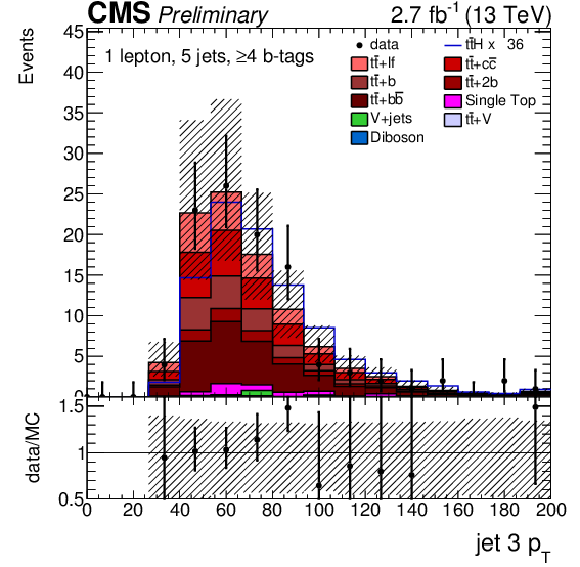
png pdf |
Additional Figure 22-b:
Data-to-simulation comparison of the BDT input distributions in the 5 jets, $\geq $ 4 b-tags category of the lepton+jets channel corresponding to an integrated luminosity of 2.7 fb$^{-1}$. The expected contributions of the different background processes (filled histograms) are stacked. The expected signal distribution (line) for a Higgs-boson mass of $m_{\mathrm{H}} =$ 125 GeV is superimposed; it has been normalized to the sum of backgrounds for better visibility. |

png pdf |
Additional Figure 22-c:
Data-to-simulation comparison of the BDT input distributions in the 5 jets, $\geq $ 4 b-tags category of the lepton+jets channel corresponding to an integrated luminosity of 2.7 fb$^{-1}$. The expected contributions of the different background processes (filled histograms) are stacked. The expected signal distribution (line) for a Higgs-boson mass of $m_{\mathrm{H}} =$ 125 GeV is superimposed; it has been normalized to the sum of backgrounds for better visibility. |

png pdf |
Additional Figure 22-d:
Data-to-simulation comparison of the BDT input distributions in the 5 jets, $\geq $ 4 b-tags category of the lepton+jets channel corresponding to an integrated luminosity of 2.7 fb$^{-1}$. The expected contributions of the different background processes (filled histograms) are stacked. The expected signal distribution (line) for a Higgs-boson mass of $m_{\mathrm{H}} =$ 125 GeV is superimposed; it has been normalized to the sum of backgrounds for better visibility. |
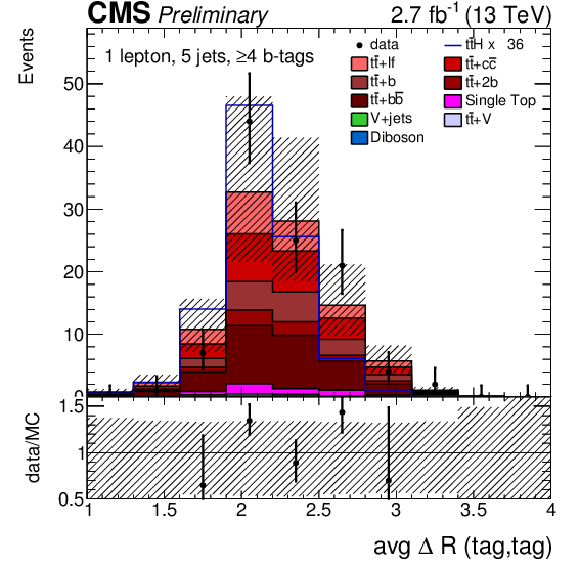
png pdf |
Additional Figure 22-e:
Data-to-simulation comparison of the BDT input distributions in the 5 jets, $\geq $ 4 b-tags category of the lepton+jets channel corresponding to an integrated luminosity of 2.7 fb$^{-1}$. The expected contributions of the different background processes (filled histograms) are stacked. The expected signal distribution (line) for a Higgs-boson mass of $m_{\mathrm{H}} =$ 125 GeV is superimposed; it has been normalized to the sum of backgrounds for better visibility. |

png pdf |
Additional Figure 22-f:
Data-to-simulation comparison of the BDT input distributions in the 5 jets, $\geq $ 4 b-tags category of the lepton+jets channel corresponding to an integrated luminosity of 2.7 fb$^{-1}$. The expected contributions of the different background processes (filled histograms) are stacked. The expected signal distribution (line) for a Higgs-boson mass of $m_{\mathrm{H}} =$ 125 GeV is superimposed; it has been normalized to the sum of backgrounds for better visibility. |
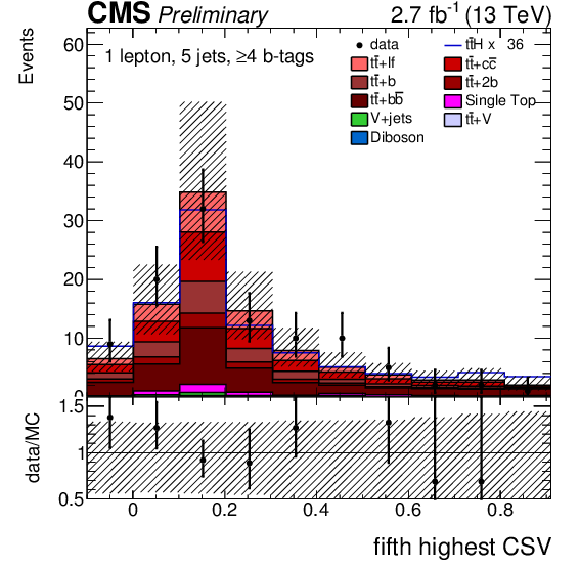
png pdf |
Additional Figure 22-g:
Data-to-simulation comparison of the BDT input distributions in the 5 jets, $\geq $ 4 b-tags category of the lepton+jets channel corresponding to an integrated luminosity of 2.7 fb$^{-1}$. The expected contributions of the different background processes (filled histograms) are stacked. The expected signal distribution (line) for a Higgs-boson mass of $m_{\mathrm{H}} =$ 125 GeV is superimposed; it has been normalized to the sum of backgrounds for better visibility. |
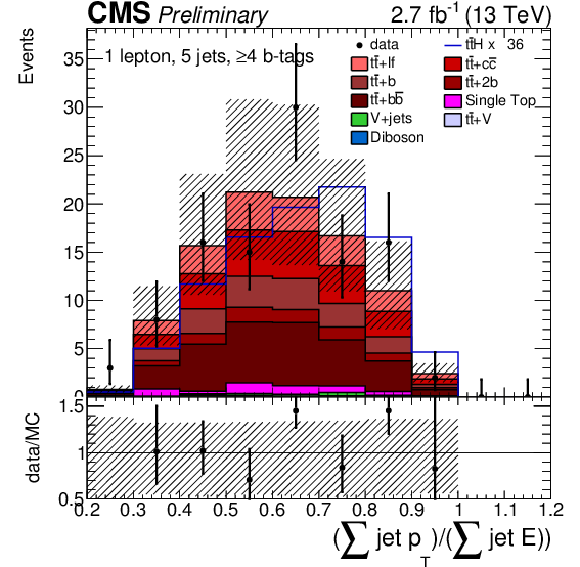
png pdf |
Additional Figure 22-h:
Data-to-simulation comparison of the BDT input distributions in the 5 jets, $\geq $ 4 b-tags category of the lepton+jets channel corresponding to an integrated luminosity of 2.7 fb$^{-1}$. The expected contributions of the different background processes (filled histograms) are stacked. The expected signal distribution (line) for a Higgs-boson mass of $m_{\mathrm{H}} =$ 125 GeV is superimposed; it has been normalized to the sum of backgrounds for better visibility. |
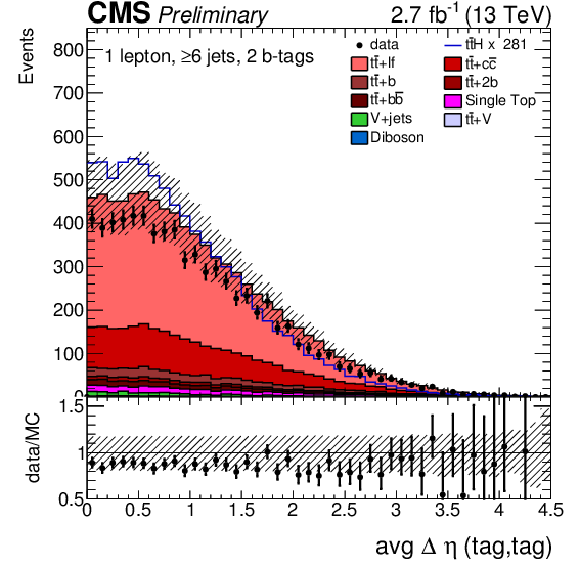
png pdf |
Additional Figure 23-a:
Data-to-simulation comparison of the BDT input distributions in the $\geq $ 6 jets, 2 b-tags category of the lepton+jets channel corresponding to an integrated luminosity of 2.7 fb$^{-1}$. The expected contributions of the different background processes (filled histograms) are stacked. The expected signal distribution (line) for a Higgs-boson mass of $m_{\mathrm{H}} =$ 125 GeV is superimposed; it has been normalized to the sum of backgrounds for better visibility. |
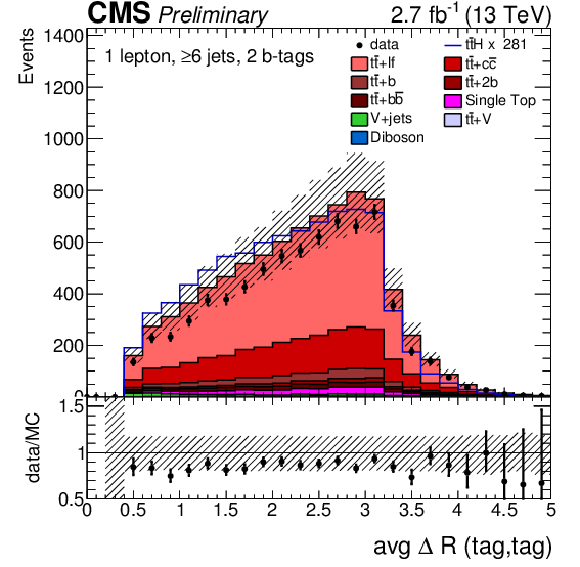
png pdf |
Additional Figure 23-b:
Data-to-simulation comparison of the BDT input distributions in the $\geq $ 6 jets, 2 b-tags category of the lepton+jets channel corresponding to an integrated luminosity of 2.7 fb$^{-1}$. The expected contributions of the different background processes (filled histograms) are stacked. The expected signal distribution (line) for a Higgs-boson mass of $m_{\mathrm{H}} =$ 125 GeV is superimposed; it has been normalized to the sum of backgrounds for better visibility. |
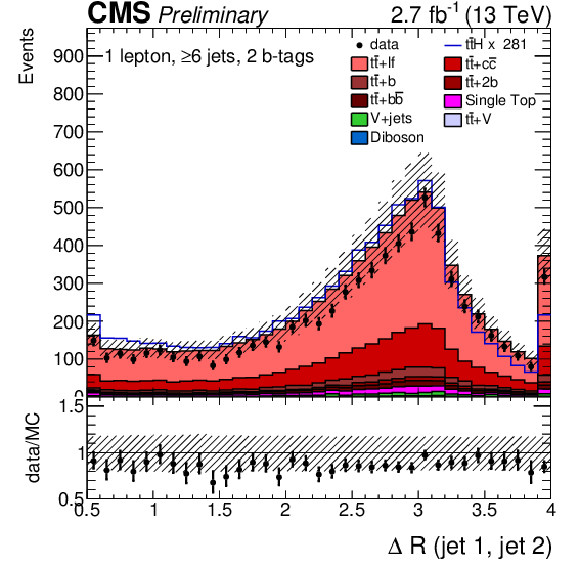
png pdf |
Additional Figure 23-c:
Data-to-simulation comparison of the BDT input distributions in the $\geq $ 6 jets, 2 b-tags category of the lepton+jets channel corresponding to an integrated luminosity of 2.7 fb$^{-1}$. The expected contributions of the different background processes (filled histograms) are stacked. The expected signal distribution (line) for a Higgs-boson mass of $m_{\mathrm{H}} =$ 125 GeV is superimposed; it has been normalized to the sum of backgrounds for better visibility. |

png pdf |
Additional Figure 23-d:
Data-to-simulation comparison of the BDT input distributions in the $\geq $ 6 jets, 2 b-tags category of the lepton+jets channel corresponding to an integrated luminosity of 2.7 fb$^{-1}$. The expected contributions of the different background processes (filled histograms) are stacked. The expected signal distribution (line) for a Higgs-boson mass of $m_{\mathrm{H}} =$ 125 GeV is superimposed; it has been normalized to the sum of backgrounds for better visibility. |
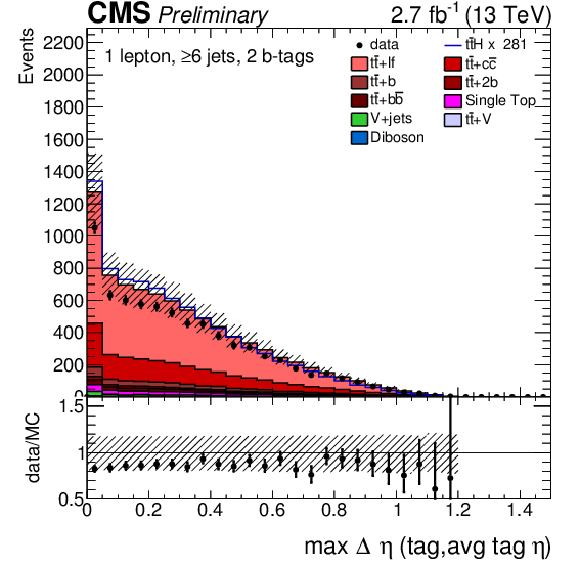
png pdf |
Additional Figure 23-e:
Data-to-simulation comparison of the BDT input distributions in the $\geq $ 6 jets, 2 b-tags category of the lepton+jets channel corresponding to an integrated luminosity of 2.7 fb$^{-1}$. The expected contributions of the different background processes (filled histograms) are stacked. The expected signal distribution (line) for a Higgs-boson mass of $m_{\mathrm{H}} =$ 125 GeV is superimposed; it has been normalized to the sum of backgrounds for better visibility. |
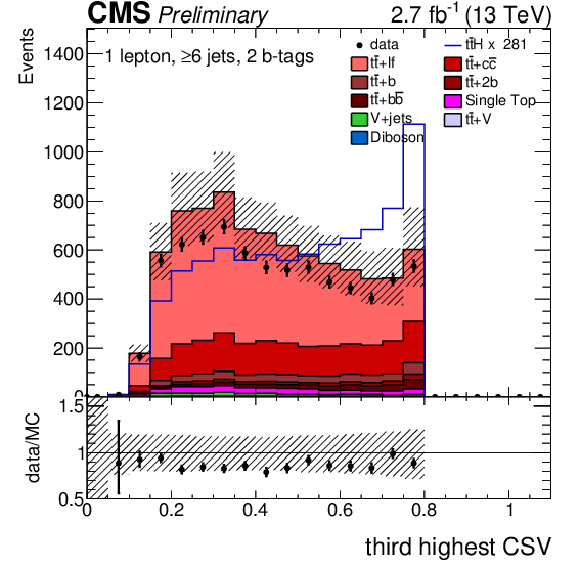
png pdf |
Additional Figure 23-f:
Data-to-simulation comparison of the BDT input distributions in the $\geq $ 6 jets, 2 b-tags category of the lepton+jets channel corresponding to an integrated luminosity of 2.7 fb$^{-1}$. The expected contributions of the different background processes (filled histograms) are stacked. The expected signal distribution (line) for a Higgs-boson mass of $m_{\mathrm{H}} =$ 125 GeV is superimposed; it has been normalized to the sum of backgrounds for better visibility. |

png pdf |
Additional Figure 23-g:
Data-to-simulation comparison of the BDT input distributions in the $\geq $ 6 jets, 2 b-tags category of the lepton+jets channel corresponding to an integrated luminosity of 2.7 fb$^{-1}$. The expected contributions of the different background processes (filled histograms) are stacked. The expected signal distribution (line) for a Higgs-boson mass of $m_{\mathrm{H}} =$ 125 GeV is superimposed; it has been normalized to the sum of backgrounds for better visibility. |
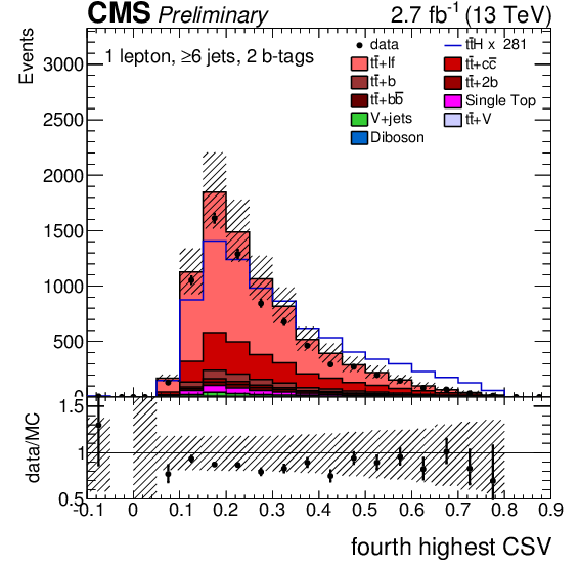
png pdf |
Additional Figure 23-h:
Data-to-simulation comparison of the BDT input distributions in the $\geq $ 6 jets, 2 b-tags category of the lepton+jets channel corresponding to an integrated luminosity of 2.7 fb$^{-1}$. The expected contributions of the different background processes (filled histograms) are stacked. The expected signal distribution (line) for a Higgs-boson mass of $m_{\mathrm{H}} =$ 125 GeV is superimposed; it has been normalized to the sum of backgrounds for better visibility. |
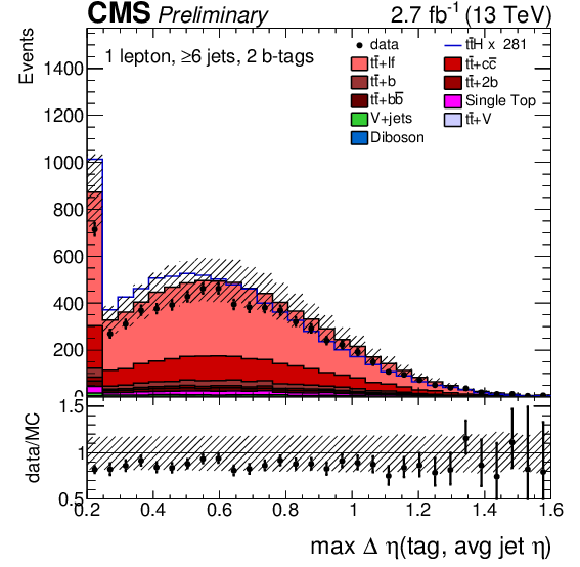
png pdf |
Additional Figure 23-i:
Data-to-simulation comparison of the BDT input distributions in the $\geq $ 6 jets, 2 b-tags category of the lepton+jets channel corresponding to an integrated luminosity of 2.7 fb$^{-1}$. The expected contributions of the different background processes (filled histograms) are stacked. The expected signal distribution (line) for a Higgs-boson mass of $m_{\mathrm{H}} =$ 125 GeV is superimposed; it has been normalized to the sum of backgrounds for better visibility. |
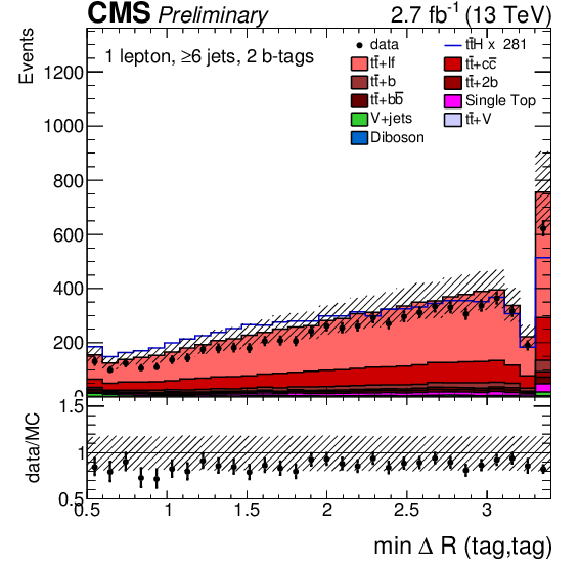
png pdf |
Additional Figure 23-j:
Data-to-simulation comparison of the BDT input distributions in the $\geq $ 6 jets, 2 b-tags category of the lepton+jets channel corresponding to an integrated luminosity of 2.7 fb$^{-1}$. The expected contributions of the different background processes (filled histograms) are stacked. The expected signal distribution (line) for a Higgs-boson mass of $m_{\mathrm{H}} =$ 125 GeV is superimposed; it has been normalized to the sum of backgrounds for better visibility. |

png pdf |
Additional Figure 24-a:
Data-to-simulation comparison of the BDT input distributions in the $\geq $ 6 jets, 3 b-tags category of the lepton+jets channel corresponding to an integrated luminosity of 2.7 fb$^{-1}$. The expected contributions of the different background processes (filled histograms) are stacked. The expected signal distribution (line) for a Higgs-boson mass of $m_{\mathrm{H}} =$ 125 GeV is superimposed; it has been normalized to the sum of backgrounds for better visibility. |

png pdf |
Additional Figure 24-b:
Data-to-simulation comparison of the BDT input distributions in the $\geq $ 6 jets, 3 b-tags category of the lepton+jets channel corresponding to an integrated luminosity of 2.7 fb$^{-1}$. The expected contributions of the different background processes (filled histograms) are stacked. The expected signal distribution (line) for a Higgs-boson mass of $m_{\mathrm{H}} =$ 125 GeV is superimposed; it has been normalized to the sum of backgrounds for better visibility. |
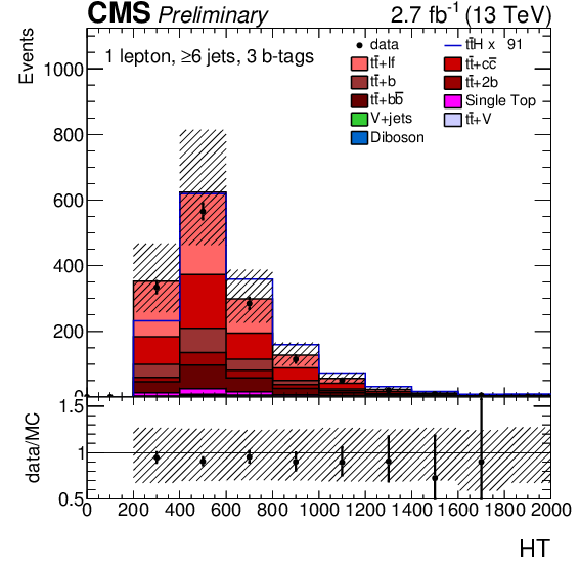
png pdf |
Additional Figure 24-c:
Data-to-simulation comparison of the BDT input distributions in the $\geq $ 6 jets, 3 b-tags category of the lepton+jets channel corresponding to an integrated luminosity of 2.7 fb$^{-1}$. The expected contributions of the different background processes (filled histograms) are stacked. The expected signal distribution (line) for a Higgs-boson mass of $m_{\mathrm{H}} =$ 125 GeV is superimposed; it has been normalized to the sum of backgrounds for better visibility. |
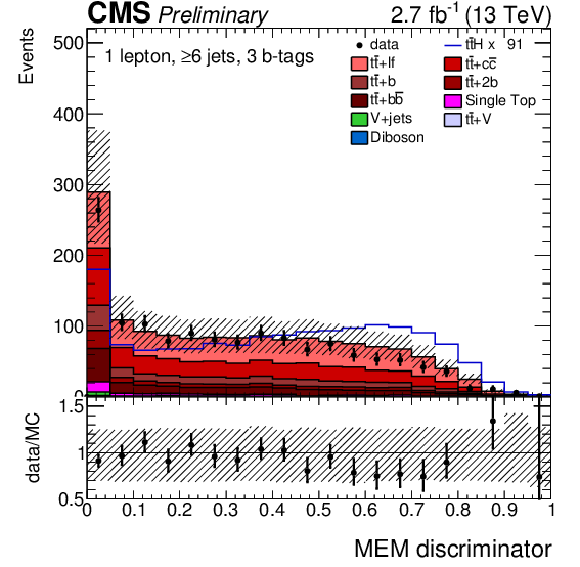
png pdf |
Additional Figure 24-d:
Data-to-simulation comparison of the BDT input distributions in the $\geq $ 6 jets, 3 b-tags category of the lepton+jets channel corresponding to an integrated luminosity of 2.7 fb$^{-1}$. The expected contributions of the different background processes (filled histograms) are stacked. The expected signal distribution (line) for a Higgs-boson mass of $m_{\mathrm{H}} =$ 125 GeV is superimposed; it has been normalized to the sum of backgrounds for better visibility. |

png pdf |
Additional Figure 24-e:
Data-to-simulation comparison of the BDT input distributions in the $\geq $ 6 jets, 3 b-tags category of the lepton+jets channel corresponding to an integrated luminosity of 2.7 fb$^{-1}$. The expected contributions of the different background processes (filled histograms) are stacked. The expected signal distribution (line) for a Higgs-boson mass of $m_{\mathrm{H}} =$ 125 GeV is superimposed; it has been normalized to the sum of backgrounds for better visibility. |
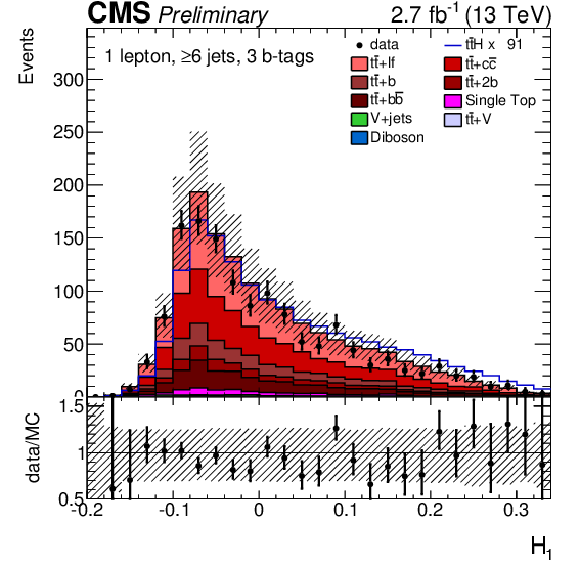
png pdf |
Additional Figure 24-f:
Data-to-simulation comparison of the BDT input distributions in the $\geq $ 6 jets, 3 b-tags category of the lepton+jets channel corresponding to an integrated luminosity of 2.7 fb$^{-1}$. The expected contributions of the different background processes (filled histograms) are stacked. The expected signal distribution (line) for a Higgs-boson mass of $m_{\mathrm{H}} =$ 125 GeV is superimposed; it has been normalized to the sum of backgrounds for better visibility. |

png pdf |
Additional Figure 24-g:
Data-to-simulation comparison of the BDT input distributions in the $\geq $ 6 jets, 3 b-tags category of the lepton+jets channel corresponding to an integrated luminosity of 2.7 fb$^{-1}$. The expected contributions of the different background processes (filled histograms) are stacked. The expected signal distribution (line) for a Higgs-boson mass of $m_{\mathrm{H}} =$ 125 GeV is superimposed; it has been normalized to the sum of backgrounds for better visibility. |
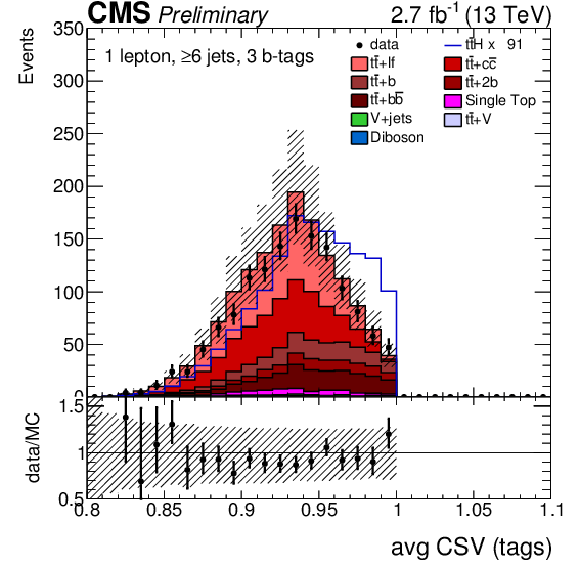
png pdf |
Additional Figure 24-h:
Data-to-simulation comparison of the BDT input distributions in the $\geq $ 6 jets, 3 b-tags category of the lepton+jets channel corresponding to an integrated luminosity of 2.7 fb$^{-1}$. The expected contributions of the different background processes (filled histograms) are stacked. The expected signal distribution (line) for a Higgs-boson mass of $m_{\mathrm{H}} =$ 125 GeV is superimposed; it has been normalized to the sum of backgrounds for better visibility. |
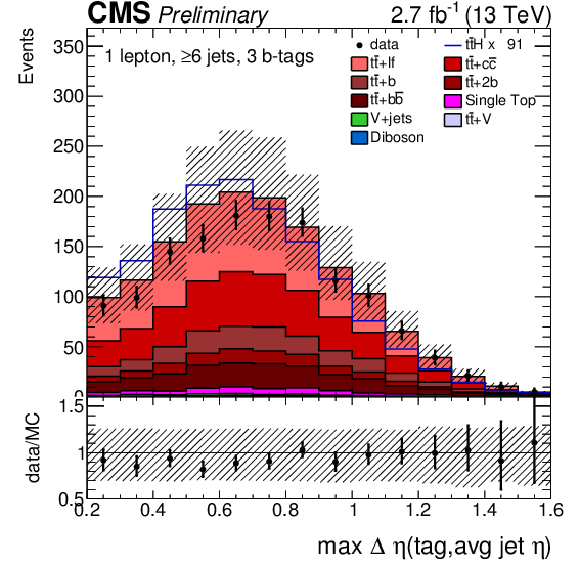
png pdf |
Additional Figure 24-i:
Data-to-simulation comparison of the BDT input distributions in the $\geq $ 6 jets, 3 b-tags category of the lepton+jets channel corresponding to an integrated luminosity of 2.7 fb$^{-1}$. The expected contributions of the different background processes (filled histograms) are stacked. The expected signal distribution (line) for a Higgs-boson mass of $m_{\mathrm{H}} =$ 125 GeV is superimposed; it has been normalized to the sum of backgrounds for better visibility. |
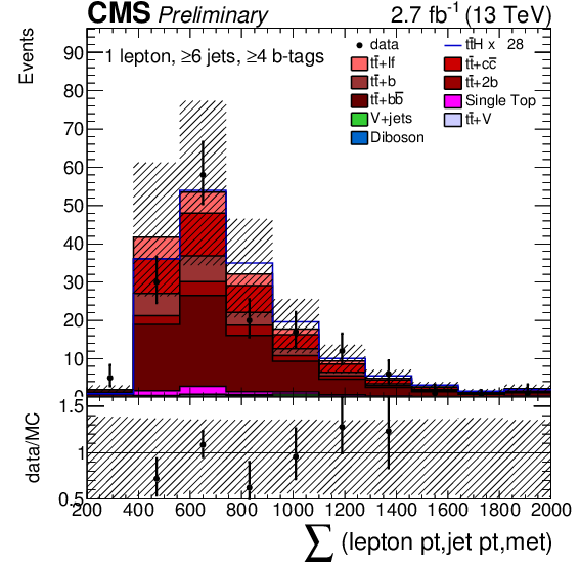
png pdf |
Additional Figure 25-a:
Data-to-simulation comparison of the BDT input distributions in the $\geq $ 6 jets, $\geq $ 4 b-tags category of the lepton+jets channel corresponding to an integrated luminosity of 2.7 fb$^{-1}$. The expected contributions of the different background processes (filled histograms) are stacked. The expected signal distribution (line) for a Higgs-boson mass of $m_{\mathrm{H}} =$ 125 GeV is superimposed; it has been normalized to the sum of backgrounds for better visibility. |
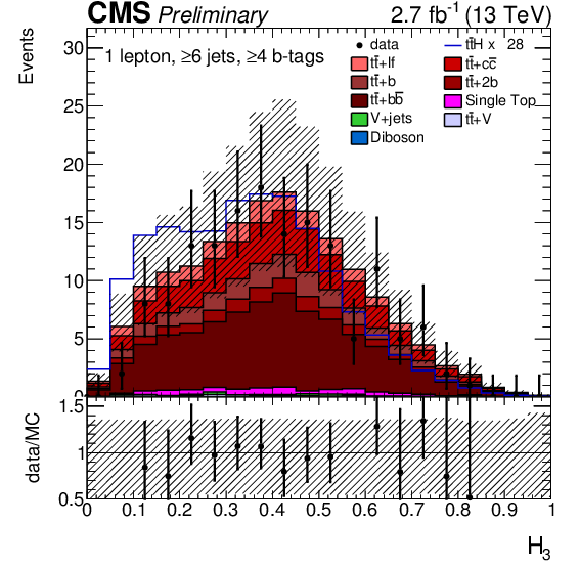
png pdf |
Additional Figure 25-b:
Data-to-simulation comparison of the BDT input distributions in the $\geq $ 6 jets, $\geq $ 4 b-tags category of the lepton+jets channel corresponding to an integrated luminosity of 2.7 fb$^{-1}$. The expected contributions of the different background processes (filled histograms) are stacked. The expected signal distribution (line) for a Higgs-boson mass of $m_{\mathrm{H}} =$ 125 GeV is superimposed; it has been normalized to the sum of backgrounds for better visibility. |

png pdf |
Additional Figure 25-c:
Data-to-simulation comparison of the BDT input distributions in the $\geq $ 6 jets, $\geq $ 4 b-tags category of the lepton+jets channel corresponding to an integrated luminosity of 2.7 fb$^{-1}$. The expected contributions of the different background processes (filled histograms) are stacked. The expected signal distribution (line) for a Higgs-boson mass of $m_{\mathrm{H}} =$ 125 GeV is superimposed; it has been normalized to the sum of backgrounds for better visibility. |
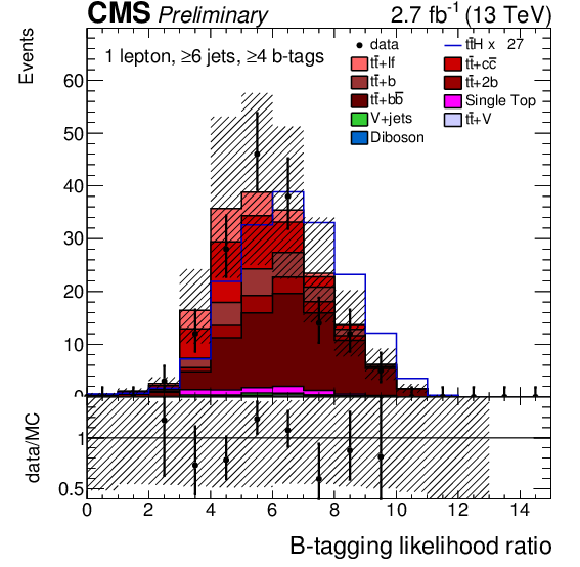
png pdf |
Additional Figure 25-d:
Data-to-simulation comparison of the BDT input distributions in the $\geq $ 6 jets, $\geq $ 4 b-tags category of the lepton+jets channel corresponding to an integrated luminosity of 2.7 fb$^{-1}$. The expected contributions of the different background processes (filled histograms) are stacked. The expected signal distribution (line) for a Higgs-boson mass of $m_{\mathrm{H}} =$ 125 GeV is superimposed; it has been normalized to the sum of backgrounds for better visibility. |
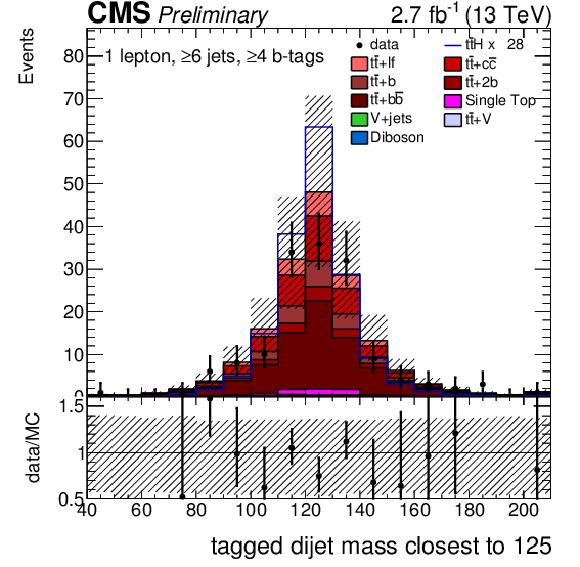
png pdf |
Additional Figure 25-e:
Data-to-simulation comparison of the BDT input distributions in the $\geq $ 6 jets, $\geq $ 4 b-tags category of the lepton+jets channel corresponding to an integrated luminosity of 2.7 fb$^{-1}$. The expected contributions of the different background processes (filled histograms) are stacked. The expected signal distribution (line) for a Higgs-boson mass of $m_{\mathrm{H}} =$ 125 GeV is superimposed; it has been normalized to the sum of backgrounds for better visibility. |
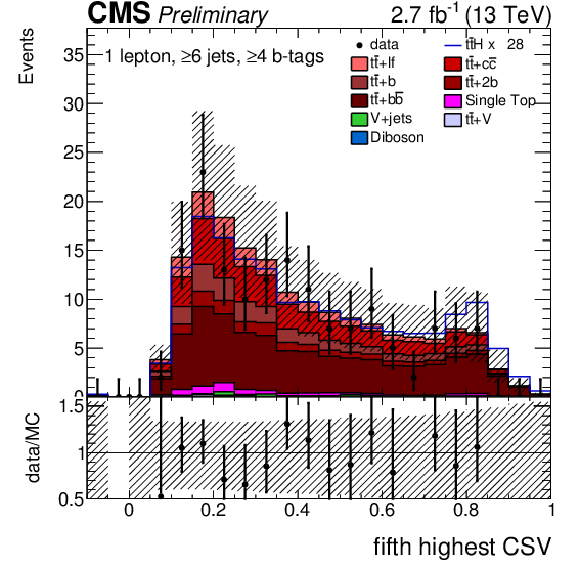
png pdf |
Additional Figure 25-f:
Data-to-simulation comparison of the BDT input distributions in the $\geq $ 6 jets, $\geq $ 4 b-tags category of the lepton+jets channel corresponding to an integrated luminosity of 2.7 fb$^{-1}$. The expected contributions of the different background processes (filled histograms) are stacked. The expected signal distribution (line) for a Higgs-boson mass of $m_{\mathrm{H}} =$ 125 GeV is superimposed; it has been normalized to the sum of backgrounds for better visibility. |
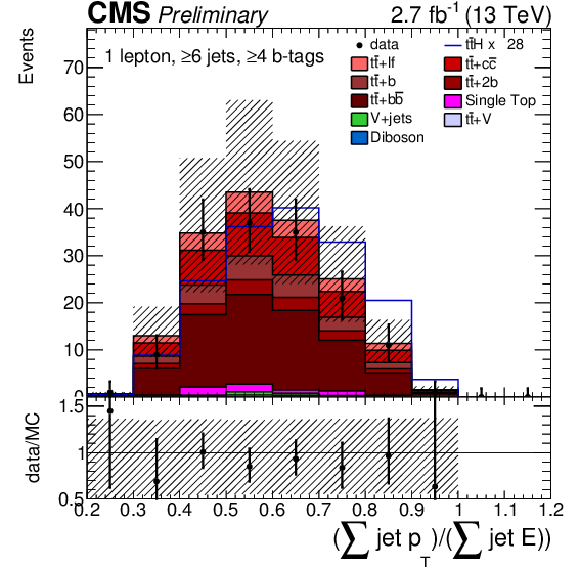
png pdf |
Additional Figure 25-g:
Data-to-simulation comparison of the BDT input distributions in the $\geq $ 6 jets, $\geq $ 4 b-tags category of the lepton+jets channel corresponding to an integrated luminosity of 2.7 fb$^{-1}$. The expected contributions of the different background processes (filled histograms) are stacked. The expected signal distribution (line) for a Higgs-boson mass of $m_{\mathrm{H}} =$ 125 GeV is superimposed; it has been normalized to the sum of backgrounds for better visibility. |
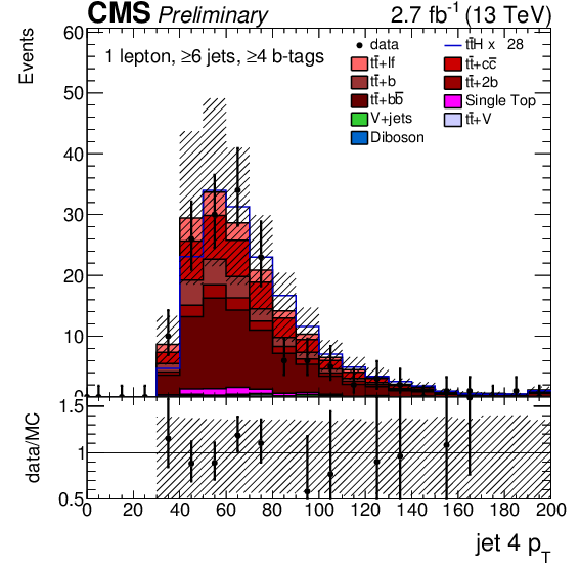
png pdf |
Additional Figure 25-h:
Data-to-simulation comparison of the BDT input distributions in the $\geq $ 6 jets, $\geq $ 4 b-tags category of the lepton+jets channel corresponding to an integrated luminosity of 2.7 fb$^{-1}$. The expected contributions of the different background processes (filled histograms) are stacked. The expected signal distribution (line) for a Higgs-boson mass of $m_{\mathrm{H}} =$ 125 GeV is superimposed; it has been normalized to the sum of backgrounds for better visibility. |

png pdf |
Additional Figure 25-i:
Data-to-simulation comparison of the BDT input distributions in the $\geq $ 6 jets, $\geq $ 4 b-tags category of the lepton+jets channel corresponding to an integrated luminosity of 2.7 fb$^{-1}$. The expected contributions of the different background processes (filled histograms) are stacked. The expected signal distribution (line) for a Higgs-boson mass of $m_{\mathrm{H}} =$ 125 GeV is superimposed; it has been normalized to the sum of backgrounds for better visibility. |

png pdf |
Additional Figure 25-j:
Data-to-simulation comparison of the BDT input distributions in the $\geq $ 6 jets, $\geq $ 4 b-tags category of the lepton+jets channel corresponding to an integrated luminosity of 2.7 fb$^{-1}$. The expected contributions of the different background processes (filled histograms) are stacked. The expected signal distribution (line) for a Higgs-boson mass of $m_{\mathrm{H}} =$ 125 GeV is superimposed; it has been normalized to the sum of backgrounds for better visibility. |

png pdf |
Additional Figure 25-k:
Data-to-simulation comparison of the BDT input distributions in the $\geq $ 6 jets, $\geq $ 4 b-tags category of the lepton+jets channel corresponding to an integrated luminosity of 2.7 fb$^{-1}$. The expected contributions of the different background processes (filled histograms) are stacked. The expected signal distribution (line) for a Higgs-boson mass of $m_{\mathrm{H}} =$ 125 GeV is superimposed; it has been normalized to the sum of backgrounds for better visibility. |
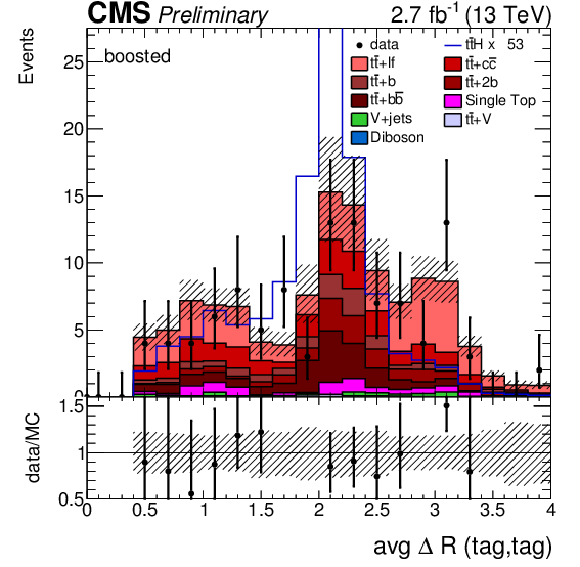
png pdf |
Additional Figure 26-a:
Data-to-simulation comparison of the BDT input distributions in the boosted category of the lepton+jets channel corresponding to an integrated luminosity of 2.7 fb$^{-1}$. The expected contributions of the different background processes (filled histograms) are stacked. The expected signal distribution (line) for a Higgs-boson mass of $m_{\mathrm{H}} =$ 125 GeV is superimposed; it has been normalized to the sum of backgrounds for better visibility. |
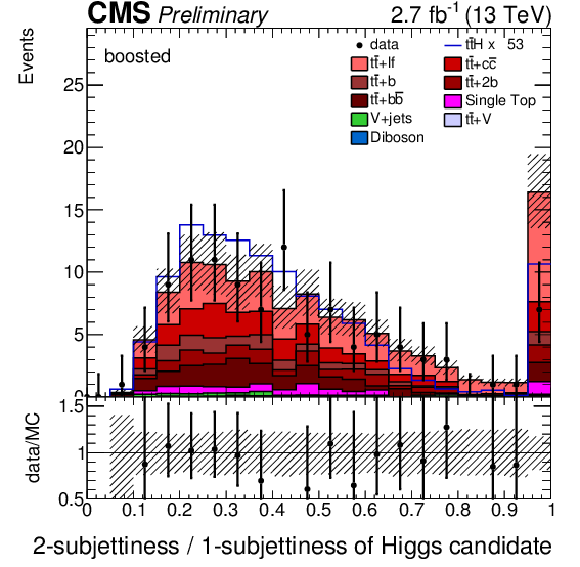
png pdf |
Additional Figure 26-b:
Data-to-simulation comparison of the BDT input distributions in the boosted category of the lepton+jets channel corresponding to an integrated luminosity of 2.7 fb$^{-1}$. The expected contributions of the different background processes (filled histograms) are stacked. The expected signal distribution (line) for a Higgs-boson mass of $m_{\mathrm{H}} =$ 125 GeV is superimposed; it has been normalized to the sum of backgrounds for better visibility. |
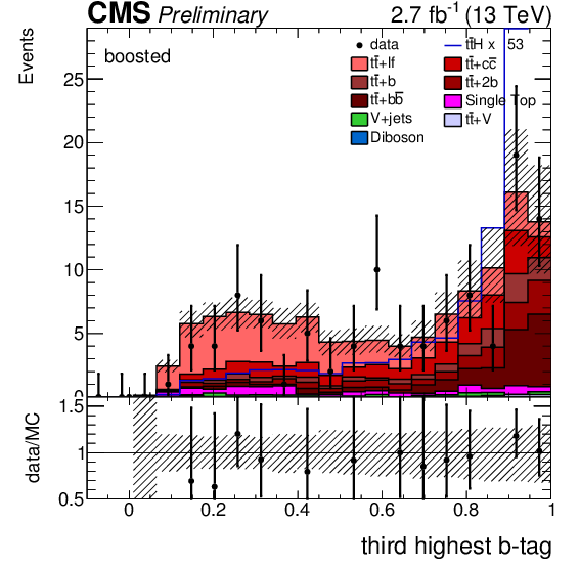
png pdf |
Additional Figure 26-c:
Data-to-simulation comparison of the BDT input distributions in the boosted category of the lepton+jets channel corresponding to an integrated luminosity of 2.7 fb$^{-1}$. The expected contributions of the different background processes (filled histograms) are stacked. The expected signal distribution (line) for a Higgs-boson mass of $m_{\mathrm{H}} =$ 125 GeV is superimposed; it has been normalized to the sum of backgrounds for better visibility. |
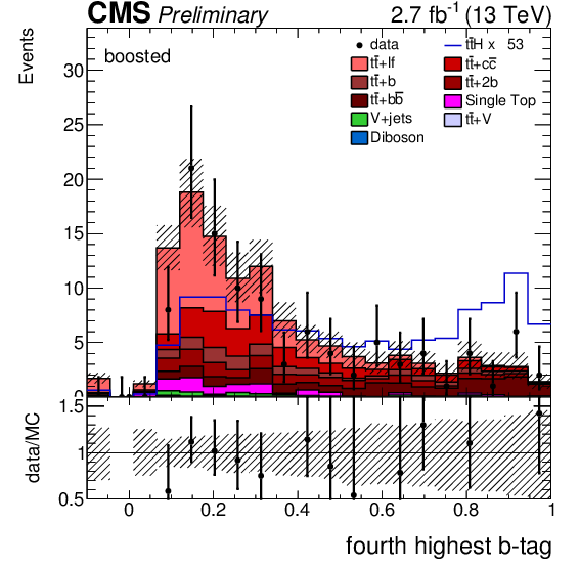
png pdf |
Additional Figure 26-d:
Data-to-simulation comparison of the BDT input distributions in the boosted category of the lepton+jets channel corresponding to an integrated luminosity of 2.7 fb$^{-1}$. The expected contributions of the different background processes (filled histograms) are stacked. The expected signal distribution (line) for a Higgs-boson mass of $m_{\mathrm{H}} =$ 125 GeV is superimposed; it has been normalized to the sum of backgrounds for better visibility. |
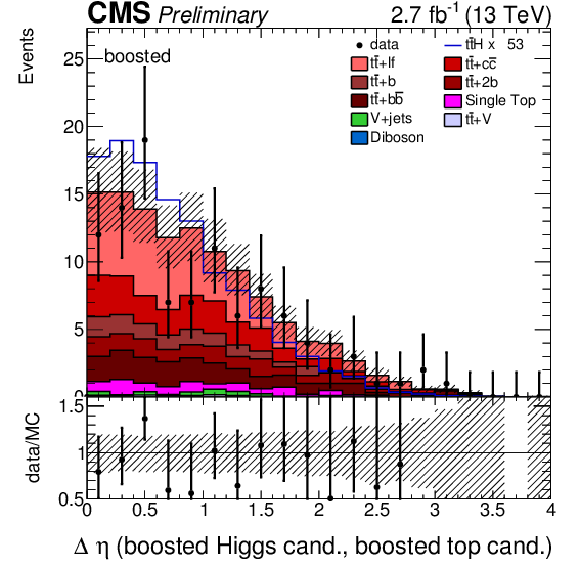
png pdf |
Additional Figure 26-e:
Data-to-simulation comparison of the BDT input distributions in the boosted category of the lepton+jets channel corresponding to an integrated luminosity of 2.7 fb$^{-1}$. The expected contributions of the different background processes (filled histograms) are stacked. The expected signal distribution (line) for a Higgs-boson mass of $m_{\mathrm{H}} =$ 125 GeV is superimposed; it has been normalized to the sum of backgrounds for better visibility. |
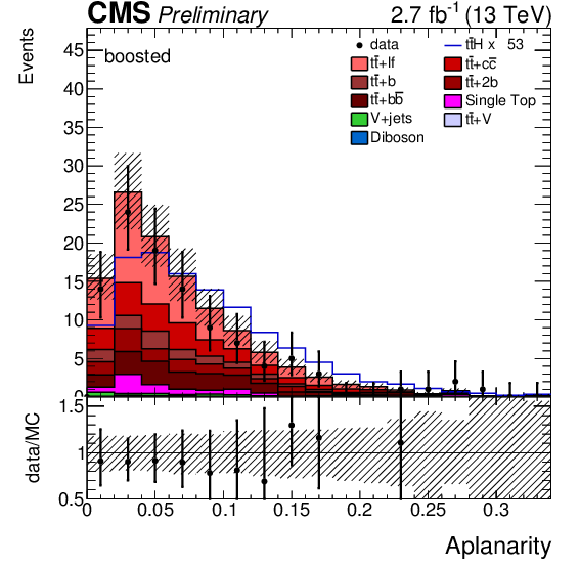
png pdf |
Additional Figure 26-f:
Data-to-simulation comparison of the BDT input distributions in the boosted category of the lepton+jets channel corresponding to an integrated luminosity of 2.7 fb$^{-1}$. The expected contributions of the different background processes (filled histograms) are stacked. The expected signal distribution (line) for a Higgs-boson mass of $m_{\mathrm{H}} =$ 125 GeV is superimposed; it has been normalized to the sum of backgrounds for better visibility. |
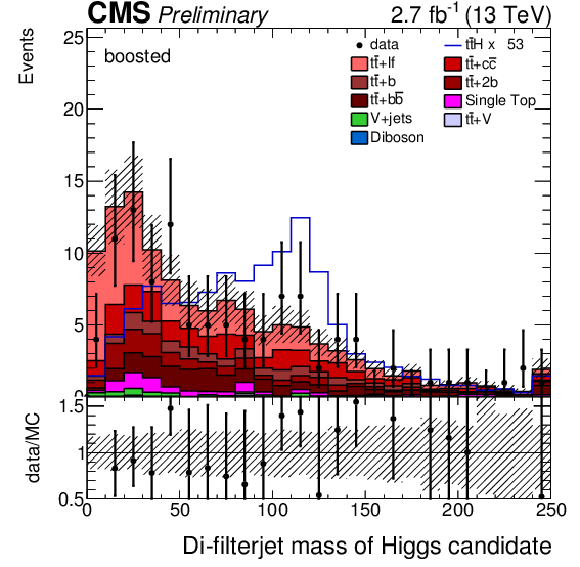
png pdf |
Additional Figure 26-g:
Data-to-simulation comparison of the BDT input distributions in the boosted category of the lepton+jets channel corresponding to an integrated luminosity of 2.7 fb$^{-1}$. The expected contributions of the different background processes (filled histograms) are stacked. The expected signal distribution (line) for a Higgs-boson mass of $m_{\mathrm{H}} =$ 125 GeV is superimposed; it has been normalized to the sum of backgrounds for better visibility. |
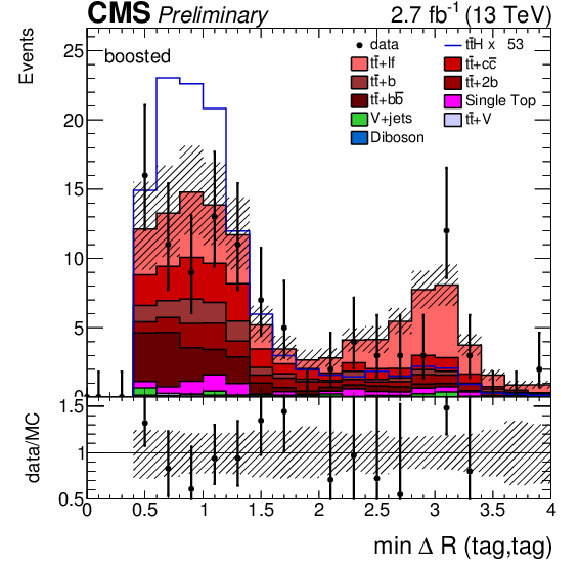
png pdf |
Additional Figure 26-h:
Data-to-simulation comparison of the BDT input distributions in the boosted category of the lepton+jets channel corresponding to an integrated luminosity of 2.7 fb$^{-1}$. The expected contributions of the different background processes (filled histograms) are stacked. The expected signal distribution (line) for a Higgs-boson mass of $m_{\mathrm{H}} =$ 125 GeV is superimposed; it has been normalized to the sum of backgrounds for better visibility. |
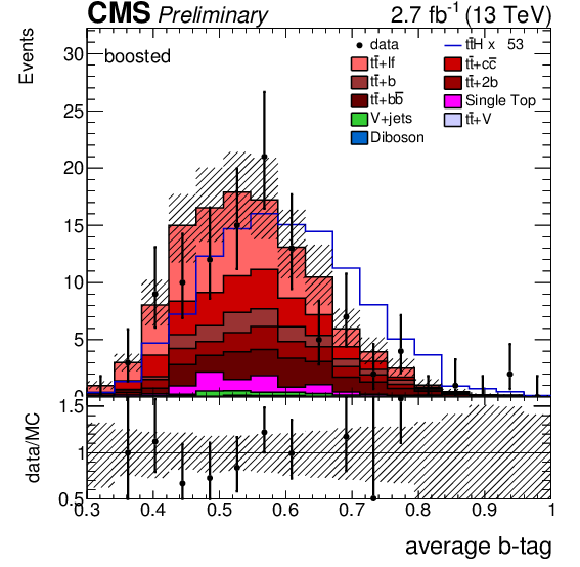
png pdf |
Additional Figure 26-i:
Data-to-simulation comparison of the BDT input distributions in the boosted category of the lepton+jets channel corresponding to an integrated luminosity of 2.7 fb$^{-1}$. The expected contributions of the different background processes (filled histograms) are stacked. The expected signal distribution (line) for a Higgs-boson mass of $m_{\mathrm{H}} =$ 125 GeV is superimposed; it has been normalized to the sum of backgrounds for better visibility. |

png pdf |
Additional Figure 26-j:
Data-to-simulation comparison of the BDT input distributions in the boosted category of the lepton+jets channel corresponding to an integrated luminosity of 2.7 fb$^{-1}$. The expected contributions of the different background processes (filled histograms) are stacked. The expected signal distribution (line) for a Higgs-boson mass of $m_{\mathrm{H}} =$ 125 GeV is superimposed; it has been normalized to the sum of backgrounds for better visibility. |
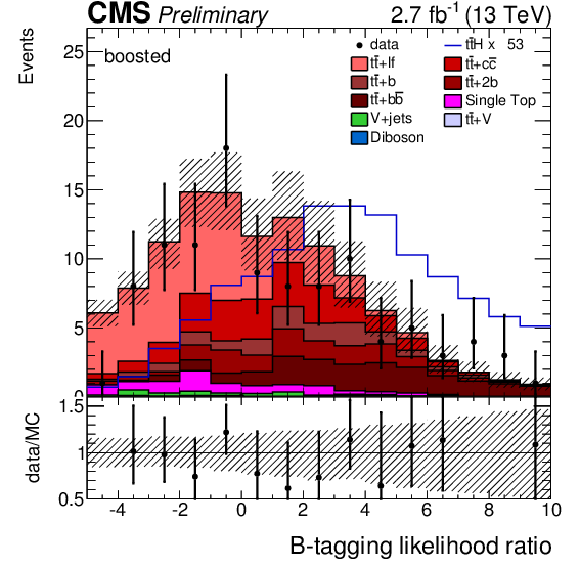
png pdf |
Additional Figure 26-k:
Data-to-simulation comparison of the BDT input distributions in the boosted category of the lepton+jets channel corresponding to an integrated luminosity of 2.7 fb$^{-1}$. The expected contributions of the different background processes (filled histograms) are stacked. The expected signal distribution (line) for a Higgs-boson mass of $m_{\mathrm{H}} =$ 125 GeV is superimposed; it has been normalized to the sum of backgrounds for better visibility. |
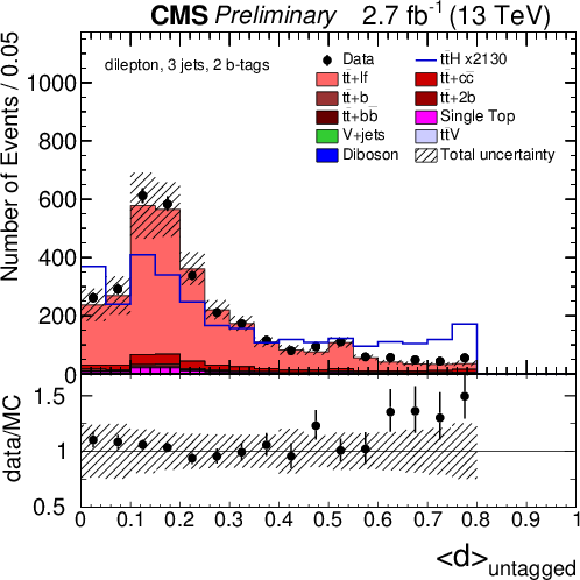
png pdf |
Additional Figure 27-a:
Data-to-simulation comparison of the BDT input distributions in the 3 jets, 2 b-tags category of the dilepton channel corresponding to an integrated luminosity of 2.7 fb$^{-1}$. The expected contributions of the different background processes (filled histograms) are stacked. The expected signal distribution (line) for a Higgs-boson mass of $m_{\mathrm{H}} =$ 125 GeV is superimposed; it has been normalized to the sum of backgrounds for better visibility. |

png pdf |
Additional Figure 27-b:
Data-to-simulation comparison of the BDT input distributions in the 3 jets, 2 b-tags category of the dilepton channel corresponding to an integrated luminosity of 2.7 fb$^{-1}$. The expected contributions of the different background processes (filled histograms) are stacked. The expected signal distribution (line) for a Higgs-boson mass of $m_{\mathrm{H}} =$ 125 GeV is superimposed; it has been normalized to the sum of backgrounds for better visibility. |
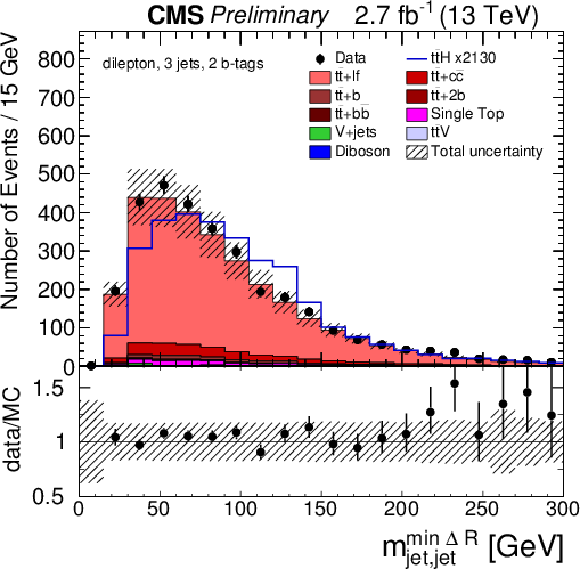
png pdf |
Additional Figure 27-c:
Data-to-simulation comparison of the BDT input distributions in the 3 jets, 2 b-tags category of the dilepton channel corresponding to an integrated luminosity of 2.7 fb$^{-1}$. The expected contributions of the different background processes (filled histograms) are stacked. The expected signal distribution (line) for a Higgs-boson mass of $m_{\mathrm{H}} =$ 125 GeV is superimposed; it has been normalized to the sum of backgrounds for better visibility. |
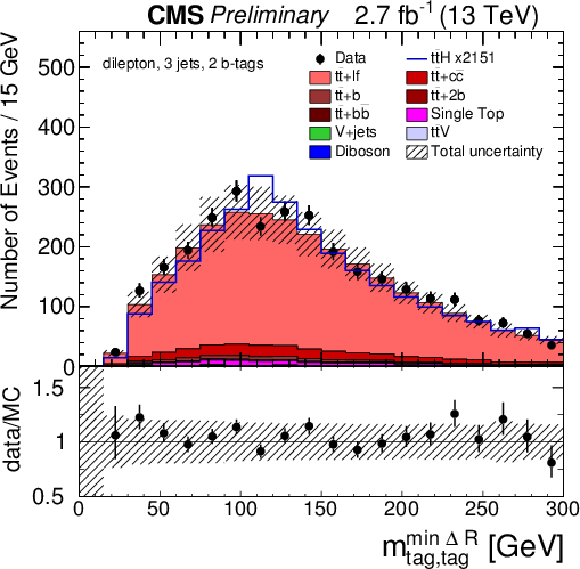
png pdf |
Additional Figure 27-d:
Data-to-simulation comparison of the BDT input distributions in the 3 jets, 2 b-tags category of the dilepton channel corresponding to an integrated luminosity of 2.7 fb$^{-1}$. The expected contributions of the different background processes (filled histograms) are stacked. The expected signal distribution (line) for a Higgs-boson mass of $m_{\mathrm{H}} =$ 125 GeV is superimposed; it has been normalized to the sum of backgrounds for better visibility. |

png pdf |
Additional Figure 27-e:
Data-to-simulation comparison of the BDT input distributions in the 3 jets, 2 b-tags category of the dilepton channel corresponding to an integrated luminosity of 2.7 fb$^{-1}$. The expected contributions of the different background processes (filled histograms) are stacked. The expected signal distribution (line) for a Higgs-boson mass of $m_{\mathrm{H}} =$ 125 GeV is superimposed; it has been normalized to the sum of backgrounds for better visibility. |

png pdf |
Additional Figure 27-f:
Data-to-simulation comparison of the BDT input distributions in the 3 jets, 2 b-tags category of the dilepton channel corresponding to an integrated luminosity of 2.7 fb$^{-1}$. The expected contributions of the different background processes (filled histograms) are stacked. The expected signal distribution (line) for a Higgs-boson mass of $m_{\mathrm{H}} =$ 125 GeV is superimposed; it has been normalized to the sum of backgrounds for better visibility. |
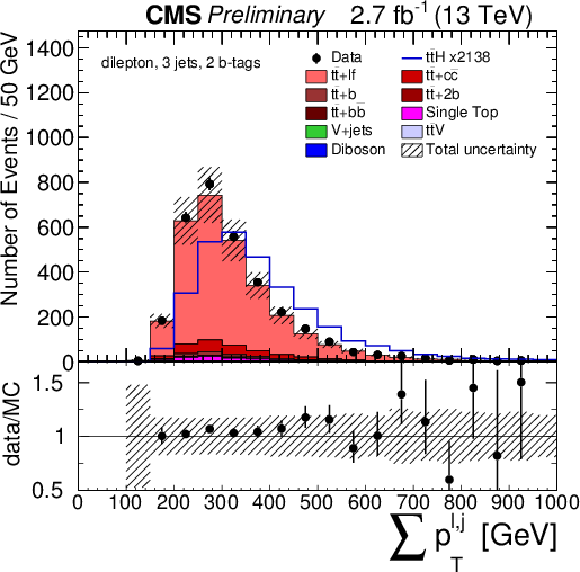
png pdf |
Additional Figure 27-g:
Data-to-simulation comparison of the BDT input distributions in the 3 jets, 2 b-tags category of the dilepton channel corresponding to an integrated luminosity of 2.7 fb$^{-1}$. The expected contributions of the different background processes (filled histograms) are stacked. The expected signal distribution (line) for a Higgs-boson mass of $m_{\mathrm{H}} =$ 125 GeV is superimposed; it has been normalized to the sum of backgrounds for better visibility. |
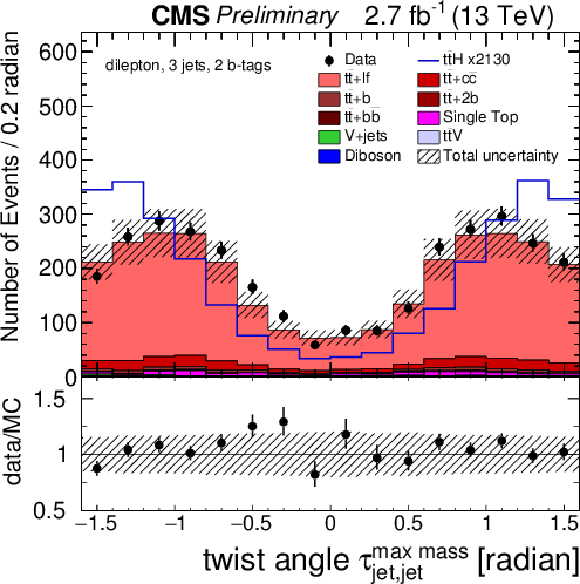
png pdf |
Additional Figure 27-h:
Data-to-simulation comparison of the BDT input distributions in the 3 jets, 2 b-tags category of the dilepton channel corresponding to an integrated luminosity of 2.7 fb$^{-1}$. The expected contributions of the different background processes (filled histograms) are stacked. The expected signal distribution (line) for a Higgs-boson mass of $m_{\mathrm{H}} =$ 125 GeV is superimposed; it has been normalized to the sum of backgrounds for better visibility. |
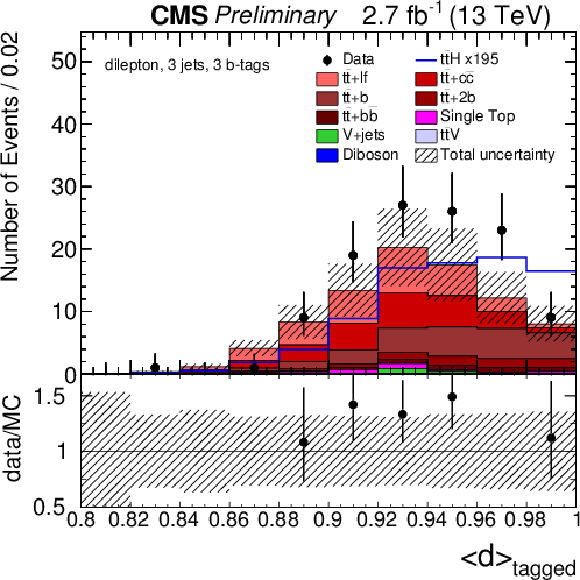
png pdf |
Additional Figure 28-a:
Data-to-simulation comparison of the BDT input distributions in the 3 jets, 3 b-tags category of the dilepton channel corresponding to an integrated luminosity of 2.7 fb$^{-1}$. The expected contributions of the different background processes (filled histograms) are stacked. The expected signal distribution (line) for a Higgs-boson mass of $m_{\mathrm{H}} =$ 125 GeV is superimposed; it has been normalized to the sum of backgrounds for better visibility. |

png pdf |
Additional Figure 28-b:
Data-to-simulation comparison of the BDT input distributions in the 3 jets, 3 b-tags category of the dilepton channel corresponding to an integrated luminosity of 2.7 fb$^{-1}$. The expected contributions of the different background processes (filled histograms) are stacked. The expected signal distribution (line) for a Higgs-boson mass of $m_{\mathrm{H}} =$ 125 GeV is superimposed; it has been normalized to the sum of backgrounds for better visibility. |
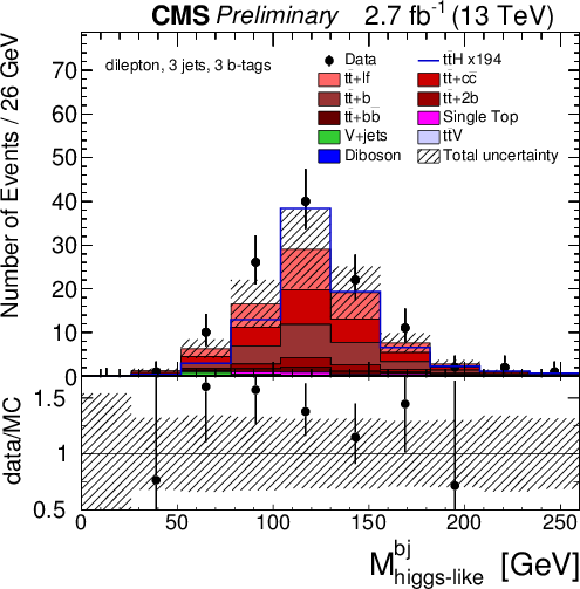
png pdf |
Additional Figure 28-c:
Data-to-simulation comparison of the BDT input distributions in the 3 jets, 3 b-tags category of the dilepton channel corresponding to an integrated luminosity of 2.7 fb$^{-1}$. The expected contributions of the different background processes (filled histograms) are stacked. The expected signal distribution (line) for a Higgs-boson mass of $m_{\mathrm{H}} =$ 125 GeV is superimposed; it has been normalized to the sum of backgrounds for better visibility. |
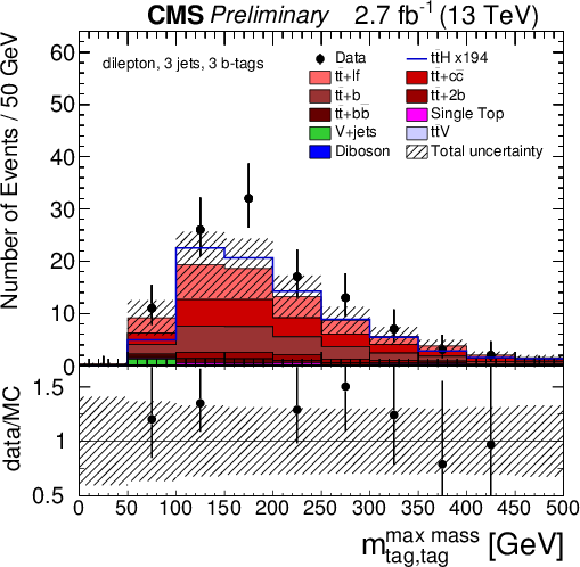
png pdf |
Additional Figure 28-d:
Data-to-simulation comparison of the BDT input distributions in the 3 jets, 3 b-tags category of the dilepton channel corresponding to an integrated luminosity of 2.7 fb$^{-1}$. The expected contributions of the different background processes (filled histograms) are stacked. The expected signal distribution (line) for a Higgs-boson mass of $m_{\mathrm{H}} =$ 125 GeV is superimposed; it has been normalized to the sum of backgrounds for better visibility. |
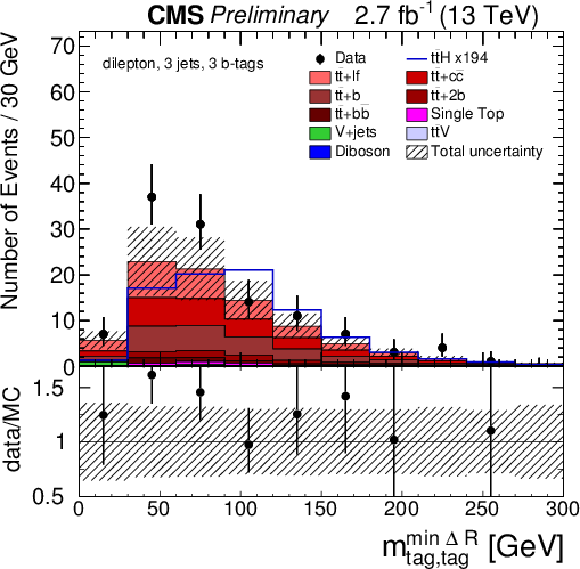
png pdf |
Additional Figure 28-e:
Data-to-simulation comparison of the BDT input distributions in the 3 jets, 3 b-tags category of the dilepton channel corresponding to an integrated luminosity of 2.7 fb$^{-1}$. The expected contributions of the different background processes (filled histograms) are stacked. The expected signal distribution (line) for a Higgs-boson mass of $m_{\mathrm{H}} =$ 125 GeV is superimposed; it has been normalized to the sum of backgrounds for better visibility. |
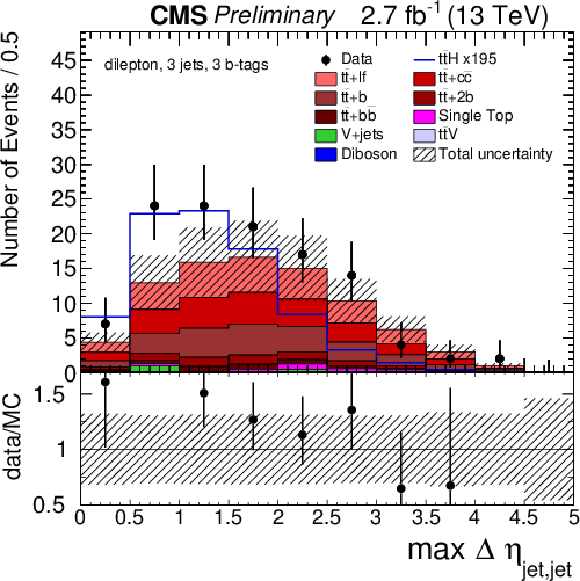
png pdf |
Additional Figure 28-f:
Data-to-simulation comparison of the BDT input distributions in the 3 jets, 3 b-tags category of the dilepton channel corresponding to an integrated luminosity of 2.7 fb$^{-1}$. The expected contributions of the different background processes (filled histograms) are stacked. The expected signal distribution (line) for a Higgs-boson mass of $m_{\mathrm{H}} =$ 125 GeV is superimposed; it has been normalized to the sum of backgrounds for better visibility. |
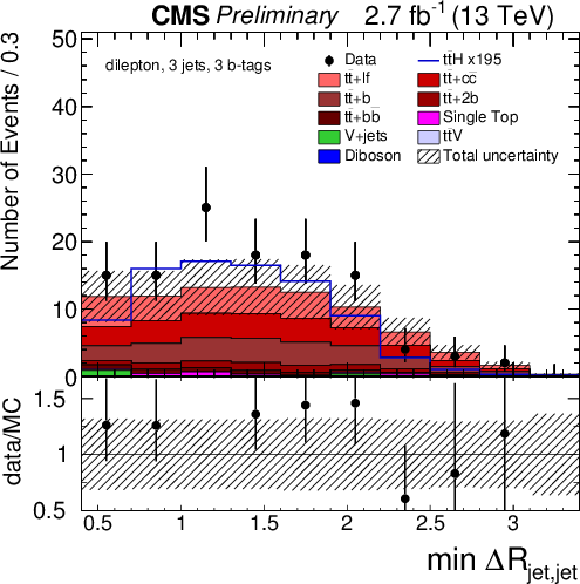
png pdf |
Additional Figure 28-g:
Data-to-simulation comparison of the BDT input distributions in the 3 jets, 3 b-tags category of the dilepton channel corresponding to an integrated luminosity of 2.7 fb$^{-1}$. The expected contributions of the different background processes (filled histograms) are stacked. The expected signal distribution (line) for a Higgs-boson mass of $m_{\mathrm{H}} =$ 125 GeV is superimposed; it has been normalized to the sum of backgrounds for better visibility. |

png pdf |
Additional Figure 28-h:
Data-to-simulation comparison of the BDT input distributions in the 3 jets, 3 b-tags category of the dilepton channel corresponding to an integrated luminosity of 2.7 fb$^{-1}$. The expected contributions of the different background processes (filled histograms) are stacked. The expected signal distribution (line) for a Higgs-boson mass of $m_{\mathrm{H}} =$ 125 GeV is superimposed; it has been normalized to the sum of backgrounds for better visibility. |
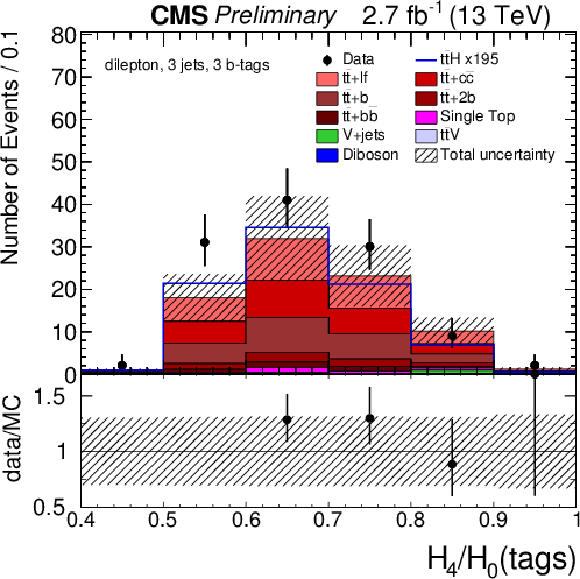
png pdf |
Additional Figure 28-i:
Data-to-simulation comparison of the BDT input distributions in the 3 jets, 3 b-tags category of the dilepton channel corresponding to an integrated luminosity of 2.7 fb$^{-1}$. The expected contributions of the different background processes (filled histograms) are stacked. The expected signal distribution (line) for a Higgs-boson mass of $m_{\mathrm{H}} =$ 125 GeV is superimposed; it has been normalized to the sum of backgrounds for better visibility. |
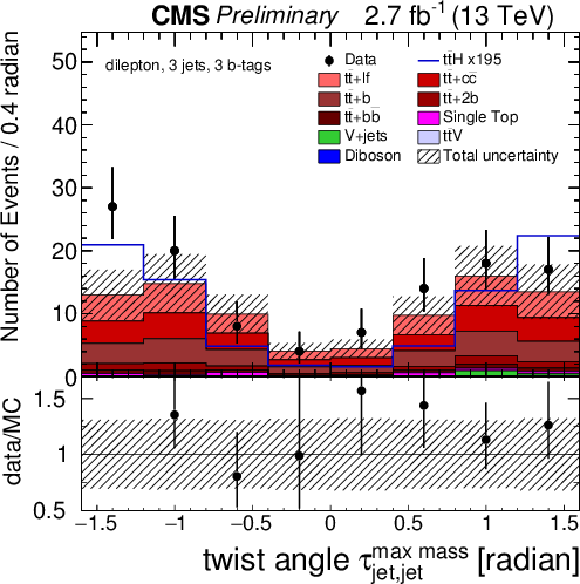
png pdf |
Additional Figure 28-j:
Data-to-simulation comparison of the BDT input distributions in the 3 jets, 3 b-tags category of the dilepton channel corresponding to an integrated luminosity of 2.7 fb$^{-1}$. The expected contributions of the different background processes (filled histograms) are stacked. The expected signal distribution (line) for a Higgs-boson mass of $m_{\mathrm{H}} =$ 125 GeV is superimposed; it has been normalized to the sum of backgrounds for better visibility. |
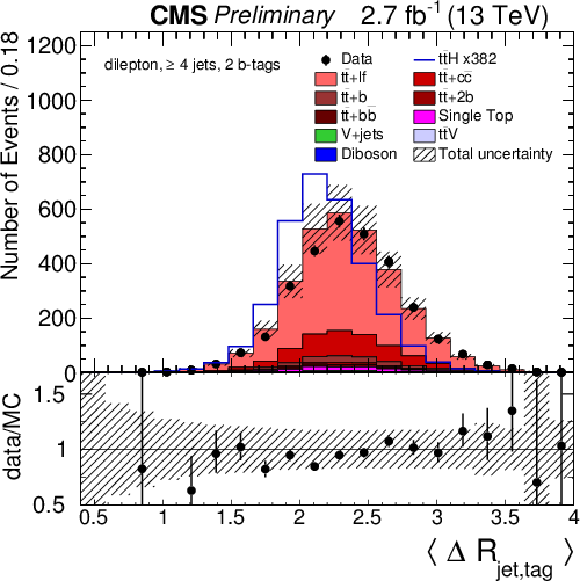
png pdf |
Additional Figure 29-a:
Data-to-simulation comparison of the BDT input distributions in the $\geq $ 4 jets, 2 b-tags category of the dilepton channel corresponding to an integrated luminosity of 2.7 fb$^{-1}$. The expected contributions of the different background processes (filled histograms) are stacked. The expected signal distribution (line) for a Higgs-boson mass of $m_{\mathrm{H}} =$ 125 GeV is superimposed; it has been normalized to the sum of backgrounds for better visibility. |
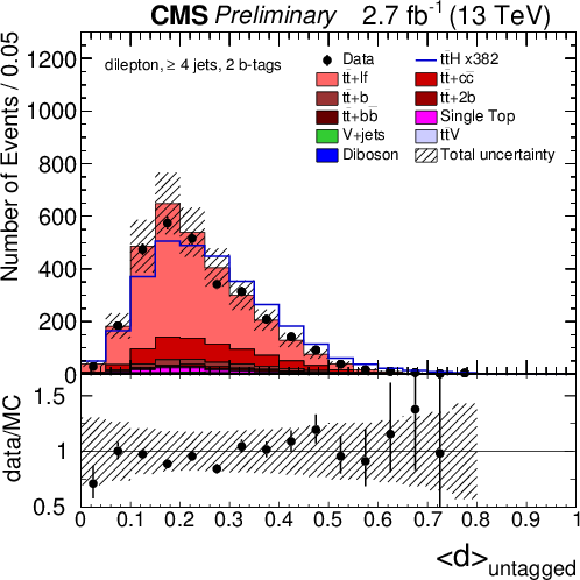
png pdf |
Additional Figure 29-b:
Data-to-simulation comparison of the BDT input distributions in the $\geq $ 4 jets, 2 b-tags category of the dilepton channel corresponding to an integrated luminosity of 2.7 fb$^{-1}$. The expected contributions of the different background processes (filled histograms) are stacked. The expected signal distribution (line) for a Higgs-boson mass of $m_{\mathrm{H}} =$ 125 GeV is superimposed; it has been normalized to the sum of backgrounds for better visibility. |
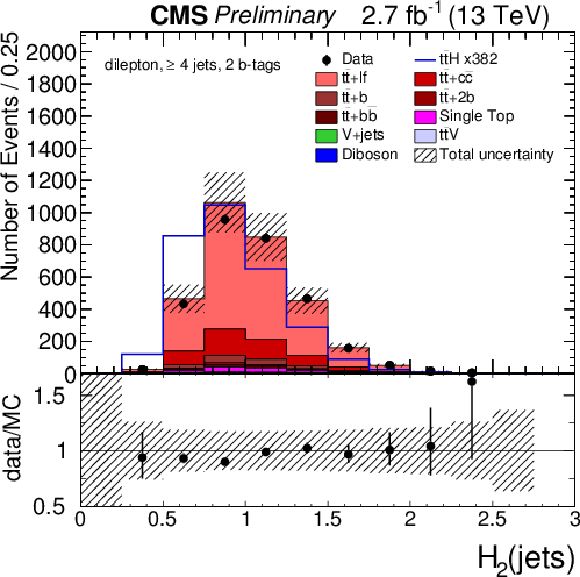
png pdf |
Additional Figure 29-c:
Data-to-simulation comparison of the BDT input distributions in the $\geq $ 4 jets, 2 b-tags category of the dilepton channel corresponding to an integrated luminosity of 2.7 fb$^{-1}$. The expected contributions of the different background processes (filled histograms) are stacked. The expected signal distribution (line) for a Higgs-boson mass of $m_{\mathrm{H}} =$ 125 GeV is superimposed; it has been normalized to the sum of backgrounds for better visibility. |
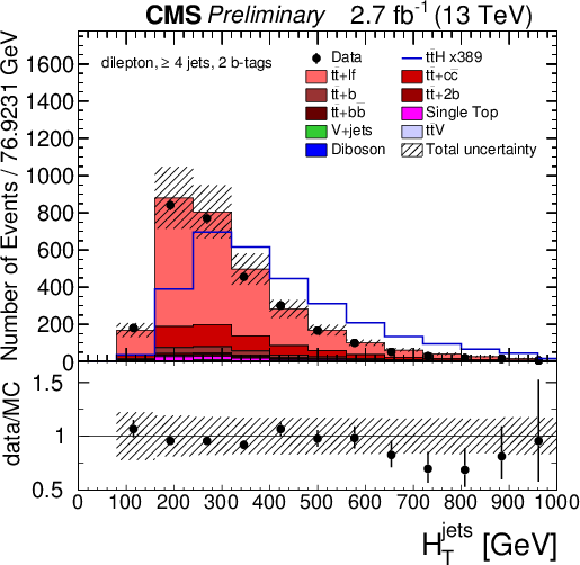
png pdf |
Additional Figure 29-d:
Data-to-simulation comparison of the BDT input distributions in the $\geq $ 4 jets, 2 b-tags category of the dilepton channel corresponding to an integrated luminosity of 2.7 fb$^{-1}$. The expected contributions of the different background processes (filled histograms) are stacked. The expected signal distribution (line) for a Higgs-boson mass of $m_{\mathrm{H}} =$ 125 GeV is superimposed; it has been normalized to the sum of backgrounds for better visibility. |

png pdf |
Additional Figure 29-e:
Data-to-simulation comparison of the BDT input distributions in the $\geq $ 4 jets, 2 b-tags category of the dilepton channel corresponding to an integrated luminosity of 2.7 fb$^{-1}$. The expected contributions of the different background processes (filled histograms) are stacked. The expected signal distribution (line) for a Higgs-boson mass of $m_{\mathrm{H}} =$ 125 GeV is superimposed; it has been normalized to the sum of backgrounds for better visibility. |
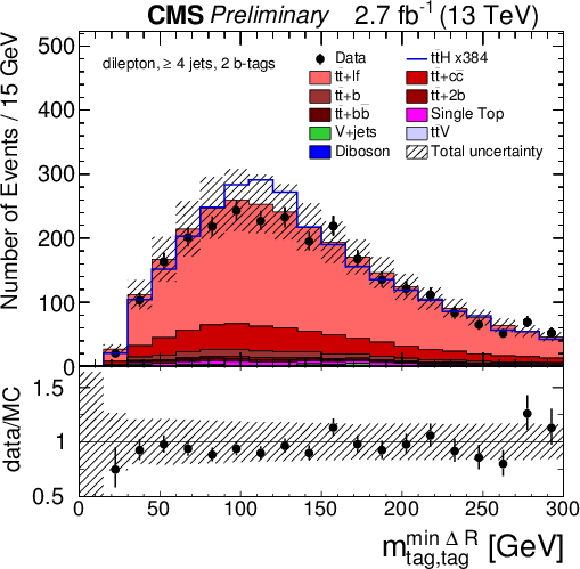
png pdf |
Additional Figure 29-f:
Data-to-simulation comparison of the BDT input distributions in the $\geq $ 4 jets, 2 b-tags category of the dilepton channel corresponding to an integrated luminosity of 2.7 fb$^{-1}$. The expected contributions of the different background processes (filled histograms) are stacked. The expected signal distribution (line) for a Higgs-boson mass of $m_{\mathrm{H}} =$ 125 GeV is superimposed; it has been normalized to the sum of backgrounds for better visibility. |
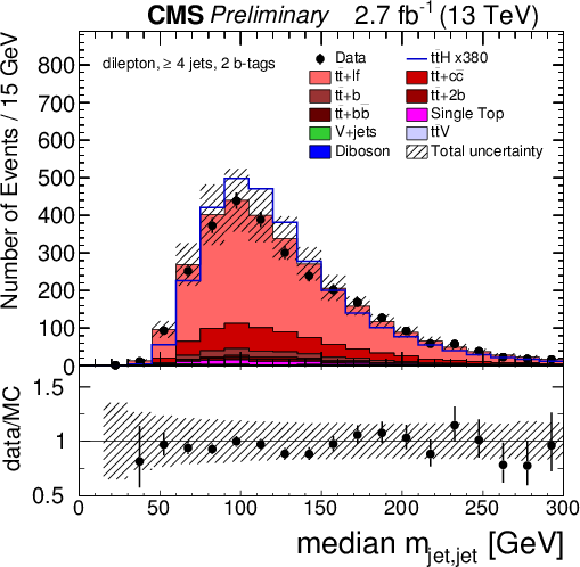
png pdf |
Additional Figure 29-g:
Data-to-simulation comparison of the BDT input distributions in the $\geq $ 4 jets, 2 b-tags category of the dilepton channel corresponding to an integrated luminosity of 2.7 fb$^{-1}$. The expected contributions of the different background processes (filled histograms) are stacked. The expected signal distribution (line) for a Higgs-boson mass of $m_{\mathrm{H}} =$ 125 GeV is superimposed; it has been normalized to the sum of backgrounds for better visibility. |
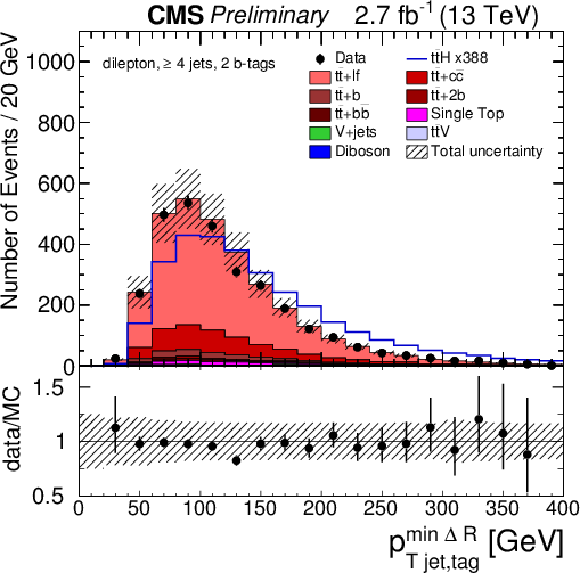
png pdf |
Additional Figure 29-h:
Data-to-simulation comparison of the BDT input distributions in the $\geq $ 4 jets, 2 b-tags category of the dilepton channel corresponding to an integrated luminosity of 2.7 fb$^{-1}$. The expected contributions of the different background processes (filled histograms) are stacked. The expected signal distribution (line) for a Higgs-boson mass of $m_{\mathrm{H}} =$ 125 GeV is superimposed; it has been normalized to the sum of backgrounds for better visibility. |

png pdf |
Additional Figure 29-i:
Data-to-simulation comparison of the BDT input distributions in the $\geq $ 4 jets, 2 b-tags category of the dilepton channel corresponding to an integrated luminosity of 2.7 fb$^{-1}$. The expected contributions of the different background processes (filled histograms) are stacked. The expected signal distribution (line) for a Higgs-boson mass of $m_{\mathrm{H}} =$ 125 GeV is superimposed; it has been normalized to the sum of backgrounds for better visibility. |
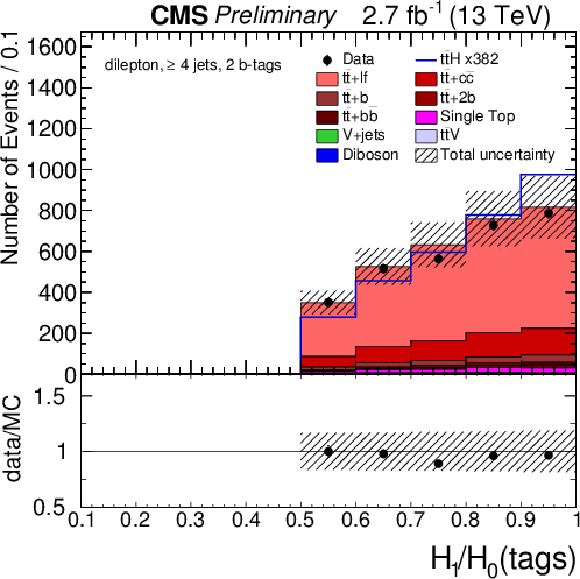
png pdf |
Additional Figure 29-j:
Data-to-simulation comparison of the BDT input distributions in the $\geq $ 4 jets, 2 b-tags category of the dilepton channel corresponding to an integrated luminosity of 2.7 fb$^{-1}$. The expected contributions of the different background processes (filled histograms) are stacked. The expected signal distribution (line) for a Higgs-boson mass of $m_{\mathrm{H}} =$ 125 GeV is superimposed; it has been normalized to the sum of backgrounds for better visibility. |
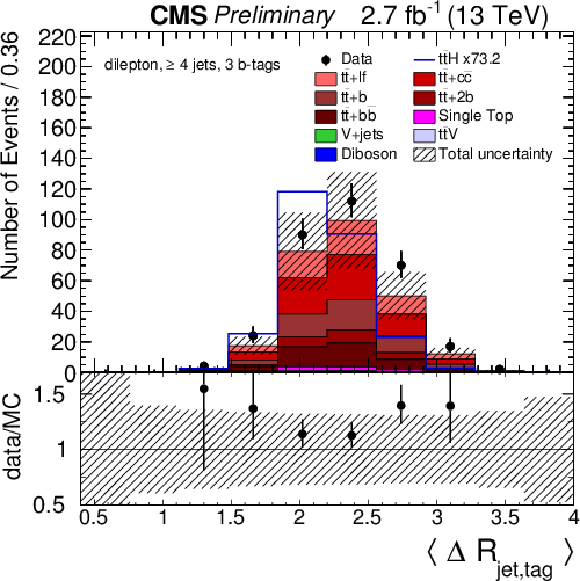
png pdf |
Additional Figure 30-a:
Data-to-simulation comparison of the BDT input distributions in the $\geq $ 4 jets, 3 b-tags category of the dilepton channel corresponding to an integrated luminosity of 2.7 fb$^{-1}$. The expected contributions of the different background processes (filled histograms) are stacked. The expected signal distribution (line) for a Higgs-boson mass of $m_{\mathrm{H}} =$ 125 GeV is superimposed; it has been normalized to the sum of backgrounds for better visibility. |
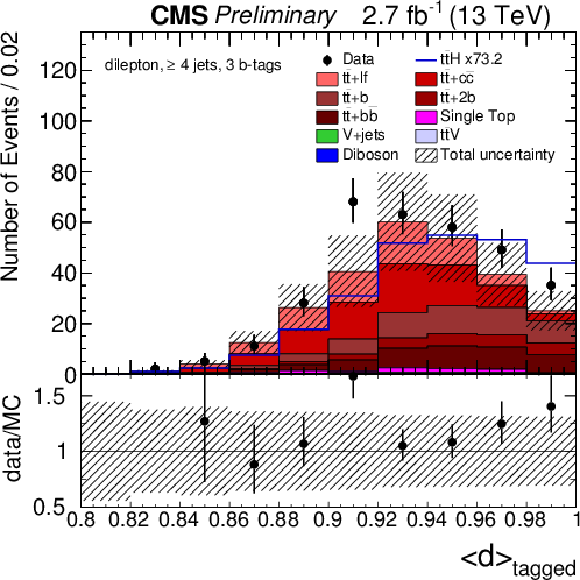
png pdf |
Additional Figure 30-b:
Data-to-simulation comparison of the BDT input distributions in the $\geq $ 4 jets, 3 b-tags category of the dilepton channel corresponding to an integrated luminosity of 2.7 fb$^{-1}$. The expected contributions of the different background processes (filled histograms) are stacked. The expected signal distribution (line) for a Higgs-boson mass of $m_{\mathrm{H}} =$ 125 GeV is superimposed; it has been normalized to the sum of backgrounds for better visibility. |
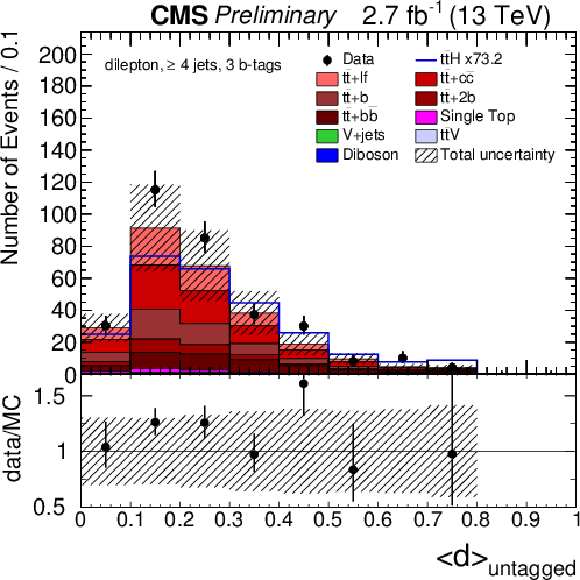
png pdf |
Additional Figure 30-c:
Data-to-simulation comparison of the BDT input distributions in the $\geq $ 4 jets, 3 b-tags category of the dilepton channel corresponding to an integrated luminosity of 2.7 fb$^{-1}$. The expected contributions of the different background processes (filled histograms) are stacked. The expected signal distribution (line) for a Higgs-boson mass of $m_{\mathrm{H}} =$ 125 GeV is superimposed; it has been normalized to the sum of backgrounds for better visibility. |

png pdf |
Additional Figure 30-d:
Data-to-simulation comparison of the BDT input distributions in the $\geq $ 4 jets, 3 b-tags category of the dilepton channel corresponding to an integrated luminosity of 2.7 fb$^{-1}$. The expected contributions of the different background processes (filled histograms) are stacked. The expected signal distribution (line) for a Higgs-boson mass of $m_{\mathrm{H}} =$ 125 GeV is superimposed; it has been normalized to the sum of backgrounds for better visibility. |
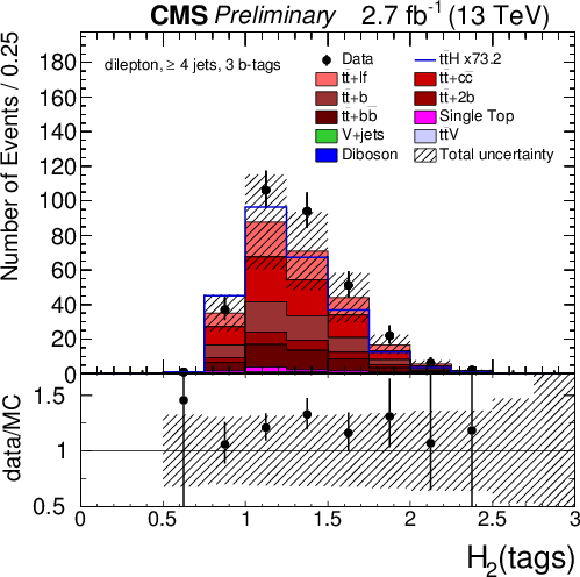
png pdf |
Additional Figure 30-e:
Data-to-simulation comparison of the BDT input distributions in the $\geq $ 4 jets, 3 b-tags category of the dilepton channel corresponding to an integrated luminosity of 2.7 fb$^{-1}$. The expected contributions of the different background processes (filled histograms) are stacked. The expected signal distribution (line) for a Higgs-boson mass of $m_{\mathrm{H}} =$ 125 GeV is superimposed; it has been normalized to the sum of backgrounds for better visibility. |
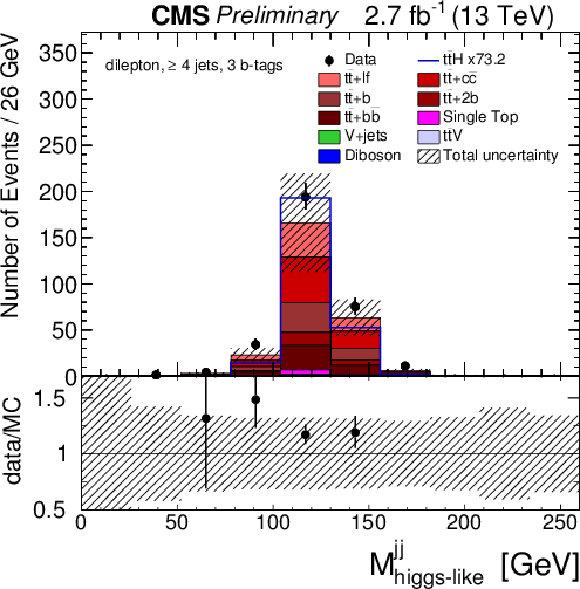
png pdf |
Additional Figure 30-f:
Data-to-simulation comparison of the BDT input distributions in the $\geq $ 4 jets, 3 b-tags category of the dilepton channel corresponding to an integrated luminosity of 2.7 fb$^{-1}$. The expected contributions of the different background processes (filled histograms) are stacked. The expected signal distribution (line) for a Higgs-boson mass of $m_{\mathrm{H}} =$ 125 GeV is superimposed; it has been normalized to the sum of backgrounds for better visibility. |
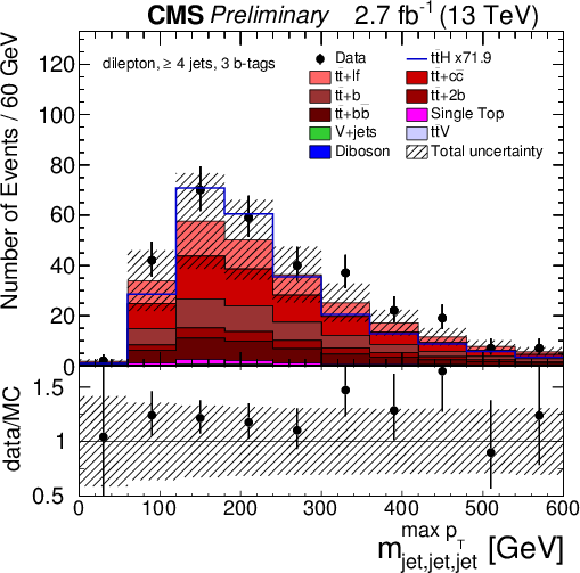
png pdf |
Additional Figure 30-g:
Data-to-simulation comparison of the BDT input distributions in the $\geq $ 4 jets, 3 b-tags category of the dilepton channel corresponding to an integrated luminosity of 2.7 fb$^{-1}$. The expected contributions of the different background processes (filled histograms) are stacked. The expected signal distribution (line) for a Higgs-boson mass of $m_{\mathrm{H}} =$ 125 GeV is superimposed; it has been normalized to the sum of backgrounds for better visibility. |
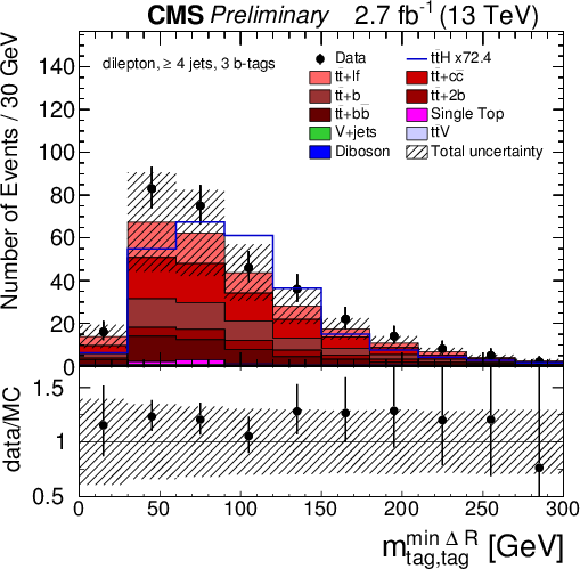
png pdf |
Additional Figure 30-h:
Data-to-simulation comparison of the BDT input distributions in the $\geq $ 4 jets, 3 b-tags category of the dilepton channel corresponding to an integrated luminosity of 2.7 fb$^{-1}$. The expected contributions of the different background processes (filled histograms) are stacked. The expected signal distribution (line) for a Higgs-boson mass of $m_{\mathrm{H}} =$ 125 GeV is superimposed; it has been normalized to the sum of backgrounds for better visibility. |
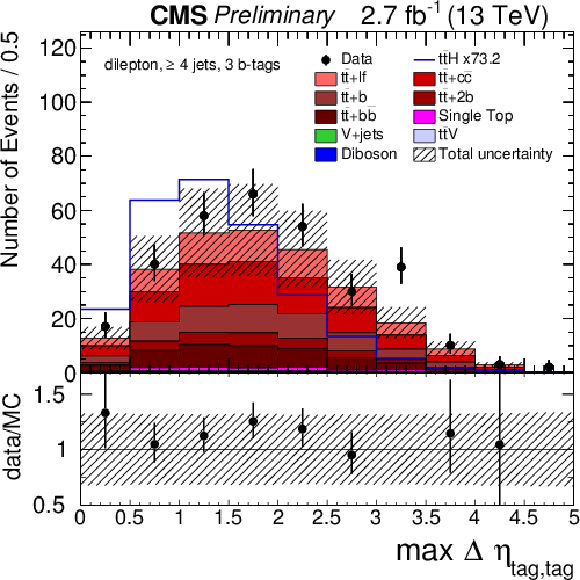
png pdf |
Additional Figure 30-i:
Data-to-simulation comparison of the BDT input distributions in the $\geq $ 4 jets, 3 b-tags category of the dilepton channel corresponding to an integrated luminosity of 2.7 fb$^{-1}$. The expected contributions of the different background processes (filled histograms) are stacked. The expected signal distribution (line) for a Higgs-boson mass of $m_{\mathrm{H}} =$ 125 GeV is superimposed; it has been normalized to the sum of backgrounds for better visibility. |
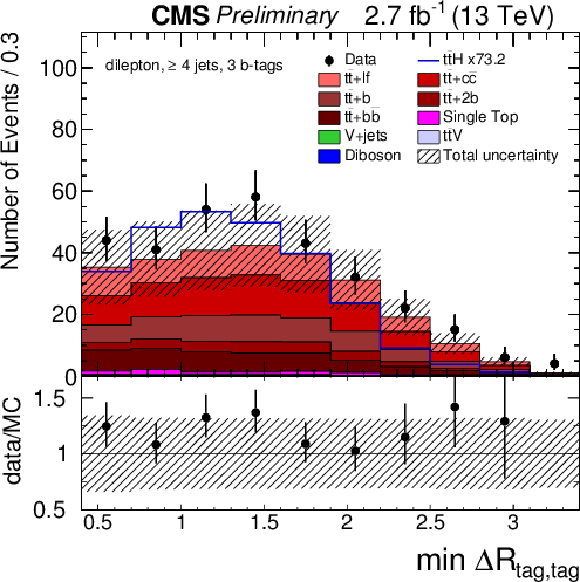
png pdf |
Additional Figure 30-j:
Data-to-simulation comparison of the BDT input distributions in the $\geq $ 4 jets, 3 b-tags category of the dilepton channel corresponding to an integrated luminosity of 2.7 fb$^{-1}$. The expected contributions of the different background processes (filled histograms) are stacked. The expected signal distribution (line) for a Higgs-boson mass of $m_{\mathrm{H}} =$ 125 GeV is superimposed; it has been normalized to the sum of backgrounds for better visibility. |
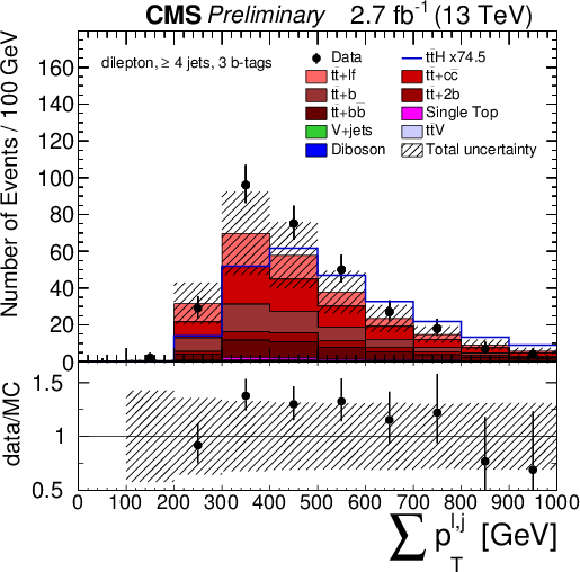
png pdf |
Additional Figure 30-k:
Data-to-simulation comparison of the BDT input distributions in the $\geq $ 4 jets, 3 b-tags category of the dilepton channel corresponding to an integrated luminosity of 2.7 fb$^{-1}$. The expected contributions of the different background processes (filled histograms) are stacked. The expected signal distribution (line) for a Higgs-boson mass of $m_{\mathrm{H}} =$ 125 GeV is superimposed; it has been normalized to the sum of backgrounds for better visibility. |

png pdf |
Additional Figure 30-l:
Data-to-simulation comparison of the BDT input distributions in the $\geq $ 4 jets, 3 b-tags category of the dilepton channel corresponding to an integrated luminosity of 2.7 fb$^{-1}$. The expected contributions of the different background processes (filled histograms) are stacked. The expected signal distribution (line) for a Higgs-boson mass of $m_{\mathrm{H}} =$ 125 GeV is superimposed; it has been normalized to the sum of backgrounds for better visibility. |

png pdf |
Additional Figure 31-a:
Data-to-simulation comparison of the BDT input distributions in the $\geq $ 4 jets, $\geq $ 4 b-tags category of the dilepton channel corresponding to an integrated luminosity of 2.7 fb$^{-1}$. The expected contributions of the different background processes (filled histograms) are stacked. The expected signal distribution (line) for a Higgs-boson mass of $m_{\mathrm{H}} =$ 125 GeV is superimposed; it has been normalized to the sum of backgrounds for better visibility. |
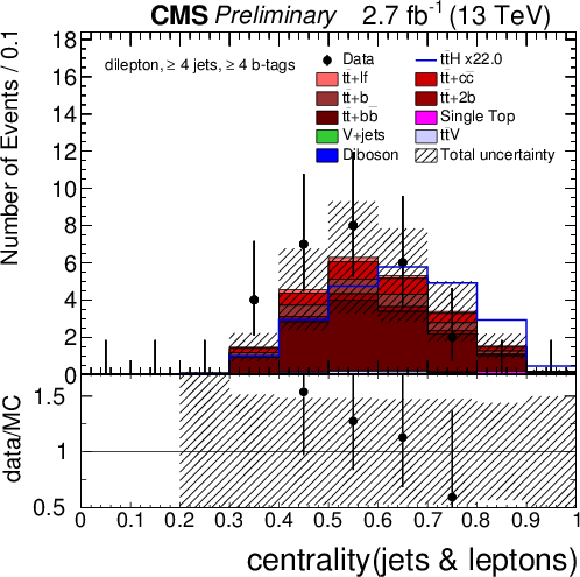
png pdf |
Additional Figure 31-b:
Data-to-simulation comparison of the BDT input distributions in the $\geq $ 4 jets, $\geq $ 4 b-tags category of the dilepton channel corresponding to an integrated luminosity of 2.7 fb$^{-1}$. The expected contributions of the different background processes (filled histograms) are stacked. The expected signal distribution (line) for a Higgs-boson mass of $m_{\mathrm{H}} =$ 125 GeV is superimposed; it has been normalized to the sum of backgrounds for better visibility. |
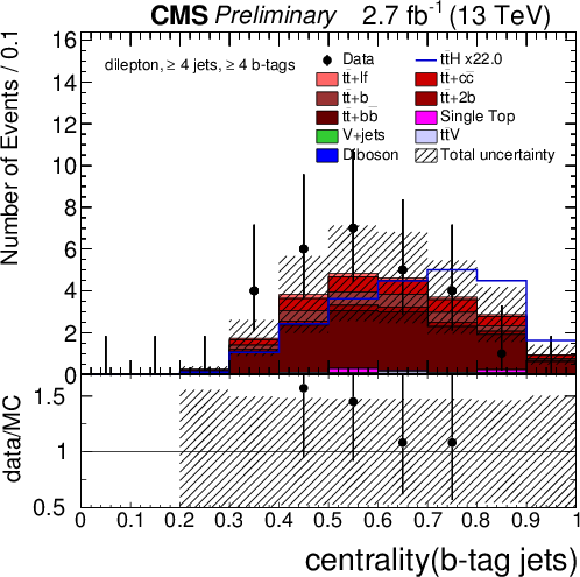
png pdf |
Additional Figure 31-c:
Data-to-simulation comparison of the BDT input distributions in the $\geq $ 4 jets, $\geq $ 4 b-tags category of the dilepton channel corresponding to an integrated luminosity of 2.7 fb$^{-1}$. The expected contributions of the different background processes (filled histograms) are stacked. The expected signal distribution (line) for a Higgs-boson mass of $m_{\mathrm{H}} =$ 125 GeV is superimposed; it has been normalized to the sum of backgrounds for better visibility. |
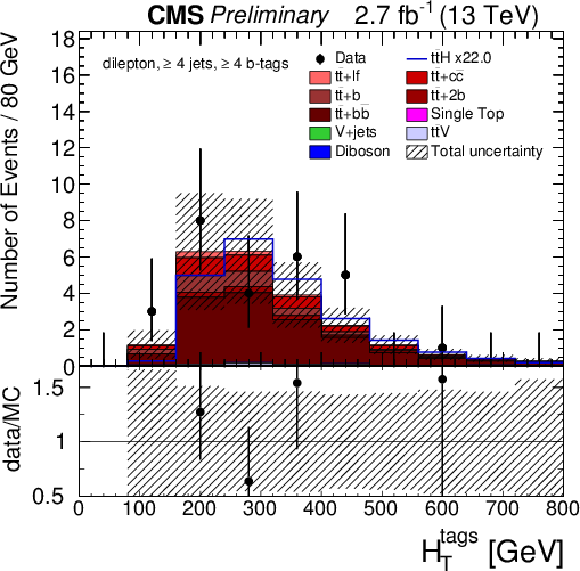
png pdf |
Additional Figure 31-d:
Data-to-simulation comparison of the BDT input distributions in the $\geq $ 4 jets, $\geq $ 4 b-tags category of the dilepton channel corresponding to an integrated luminosity of 2.7 fb$^{-1}$. The expected contributions of the different background processes (filled histograms) are stacked. The expected signal distribution (line) for a Higgs-boson mass of $m_{\mathrm{H}} =$ 125 GeV is superimposed; it has been normalized to the sum of backgrounds for better visibility. |
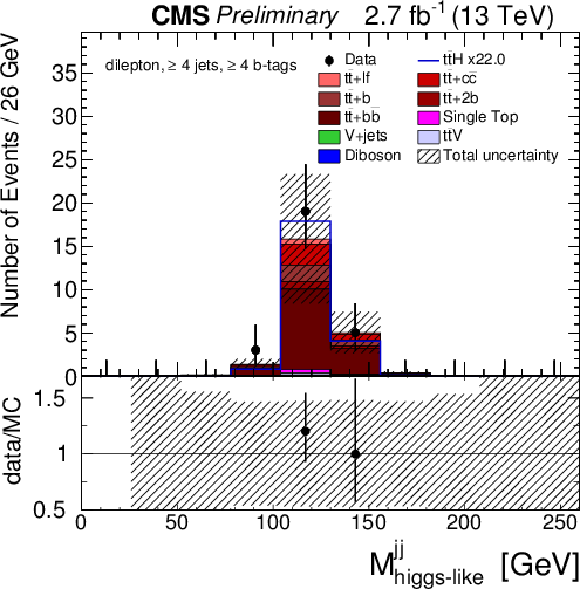
png pdf |
Additional Figure 31-e:
Data-to-simulation comparison of the BDT input distributions in the $\geq $ 4 jets, $\geq $ 4 b-tags category of the dilepton channel corresponding to an integrated luminosity of 2.7 fb$^{-1}$. The expected contributions of the different background processes (filled histograms) are stacked. The expected signal distribution (line) for a Higgs-boson mass of $m_{\mathrm{H}} =$ 125 GeV is superimposed; it has been normalized to the sum of backgrounds for better visibility. |
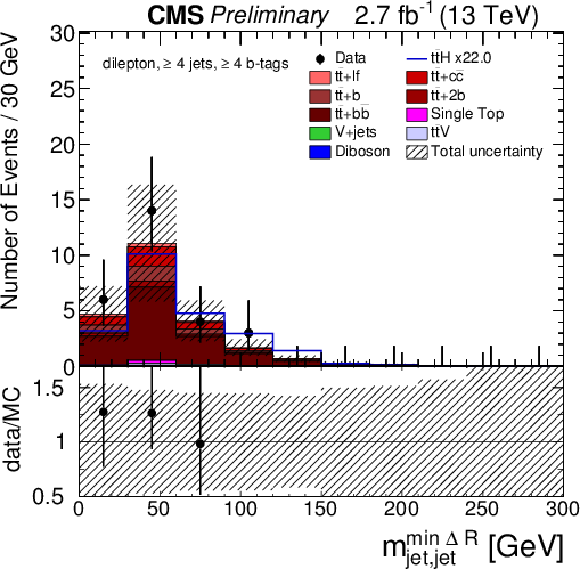
png pdf |
Additional Figure 31-f:
Data-to-simulation comparison of the BDT input distributions in the $\geq $ 4 jets, $\geq $ 4 b-tags category of the dilepton channel corresponding to an integrated luminosity of 2.7 fb$^{-1}$. The expected contributions of the different background processes (filled histograms) are stacked. The expected signal distribution (line) for a Higgs-boson mass of $m_{\mathrm{H}} =$ 125 GeV is superimposed; it has been normalized to the sum of backgrounds for better visibility. |

png pdf |
Additional Figure 31-g:
Data-to-simulation comparison of the BDT input distributions in the $\geq $ 4 jets, $\geq $ 4 b-tags category of the dilepton channel corresponding to an integrated luminosity of 2.7 fb$^{-1}$. The expected contributions of the different background processes (filled histograms) are stacked. The expected signal distribution (line) for a Higgs-boson mass of $m_{\mathrm{H}} =$ 125 GeV is superimposed; it has been normalized to the sum of backgrounds for better visibility. |
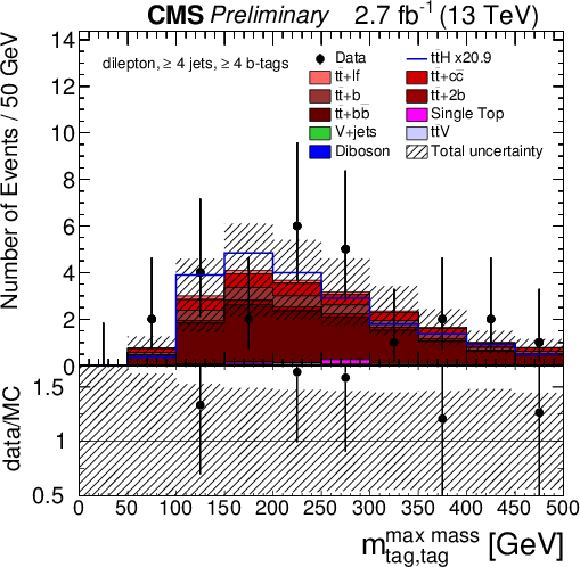
png pdf |
Additional Figure 31-h:
Data-to-simulation comparison of the BDT input distributions in the $\geq $ 4 jets, $\geq $ 4 b-tags category of the dilepton channel corresponding to an integrated luminosity of 2.7 fb$^{-1}$. The expected contributions of the different background processes (filled histograms) are stacked. The expected signal distribution (line) for a Higgs-boson mass of $m_{\mathrm{H}} =$ 125 GeV is superimposed; it has been normalized to the sum of backgrounds for better visibility. |
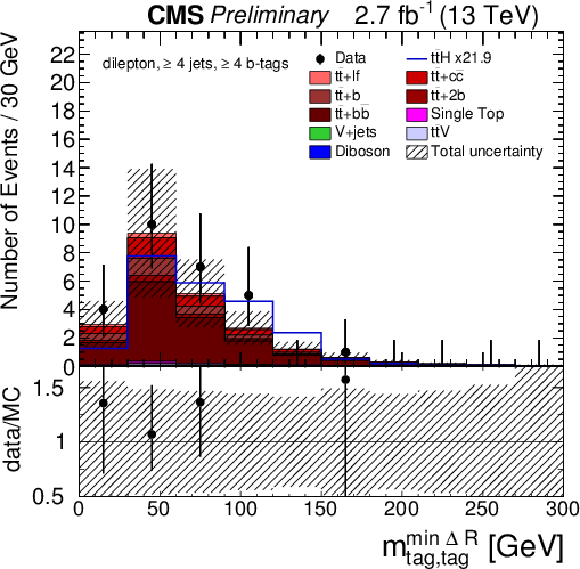
png pdf |
Additional Figure 31-i:
Data-to-simulation comparison of the BDT input distributions in the $\geq $ 4 jets, $\geq $ 4 b-tags category of the dilepton channel corresponding to an integrated luminosity of 2.7 fb$^{-1}$. The expected contributions of the different background processes (filled histograms) are stacked. The expected signal distribution (line) for a Higgs-boson mass of $m_{\mathrm{H}} =$ 125 GeV is superimposed; it has been normalized to the sum of backgrounds for better visibility. |
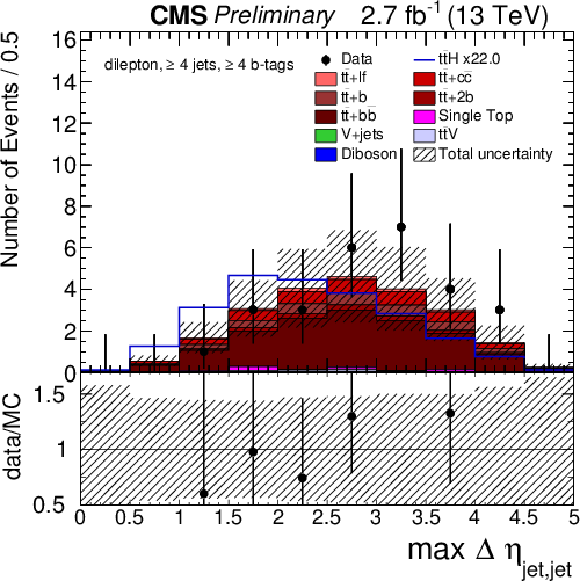
png pdf |
Additional Figure 31-j:
Data-to-simulation comparison of the BDT input distributions in the $\geq $ 4 jets, $\geq $ 4 b-tags category of the dilepton channel corresponding to an integrated luminosity of 2.7 fb$^{-1}$. The expected contributions of the different background processes (filled histograms) are stacked. The expected signal distribution (line) for a Higgs-boson mass of $m_{\mathrm{H}} =$ 125 GeV is superimposed; it has been normalized to the sum of backgrounds for better visibility. |

png pdf |
Additional Figure 31-k:
Data-to-simulation comparison of the BDT input distributions in the $\geq $ 4 jets, $\geq $ 4 b-tags category of the dilepton channel corresponding to an integrated luminosity of 2.7 fb$^{-1}$. The expected contributions of the different background processes (filled histograms) are stacked. The expected signal distribution (line) for a Higgs-boson mass of $m_{\mathrm{H}} =$ 125 GeV is superimposed; it has been normalized to the sum of backgrounds for better visibility. |

png pdf |
Additional Figure 31-l:
Data-to-simulation comparison of the BDT input distributions in the $\geq $ 4 jets, $\geq $ 4 b-tags category of the dilepton channel corresponding to an integrated luminosity of 2.7 fb$^{-1}$. The expected contributions of the different background processes (filled histograms) are stacked. The expected signal distribution (line) for a Higgs-boson mass of $m_{\mathrm{H}} =$ 125 GeV is superimposed; it has been normalized to the sum of backgrounds for better visibility. |

|
Compact Muon Solenoid LHC, CERN |

|

|

|

|

|

|